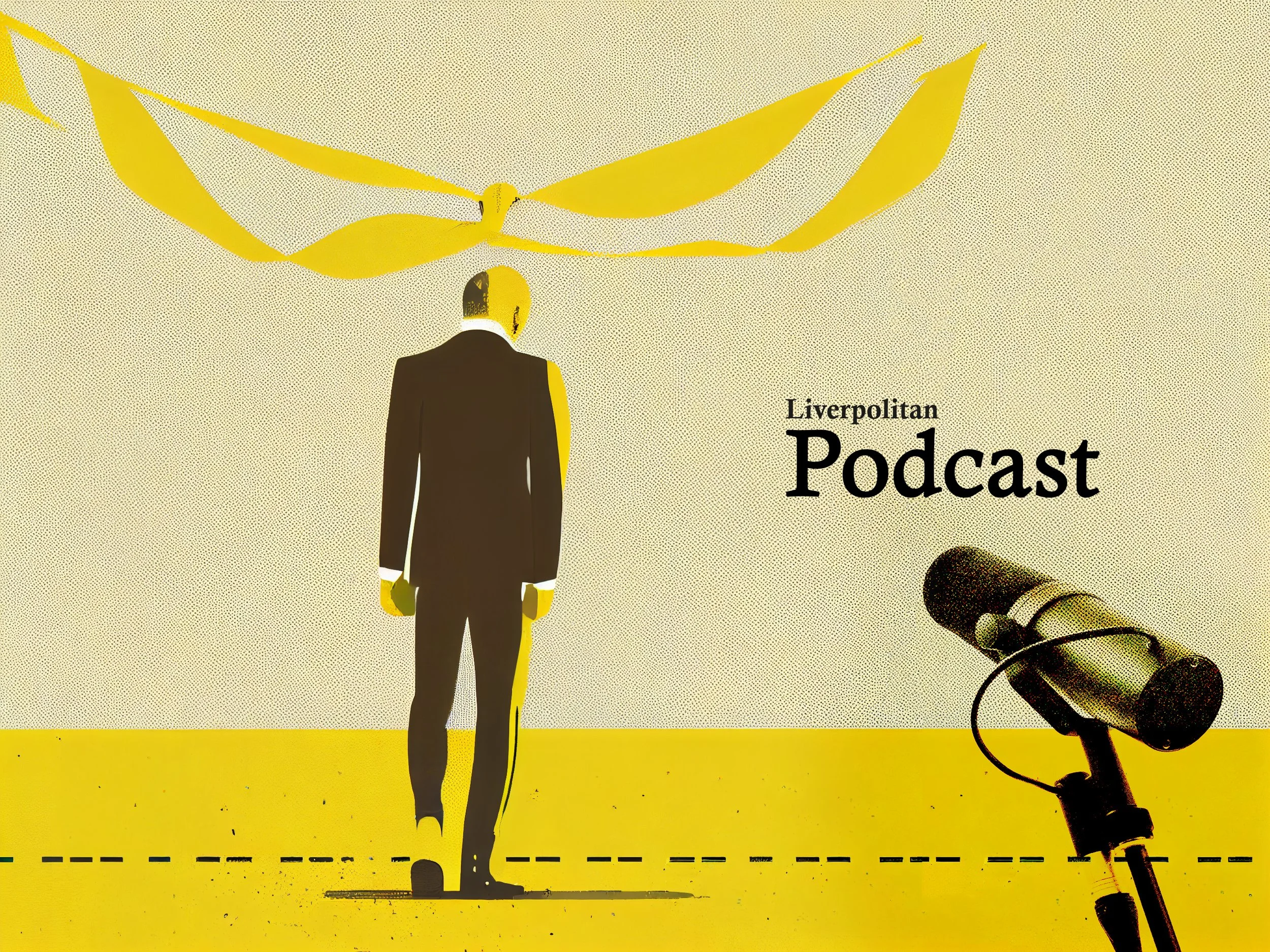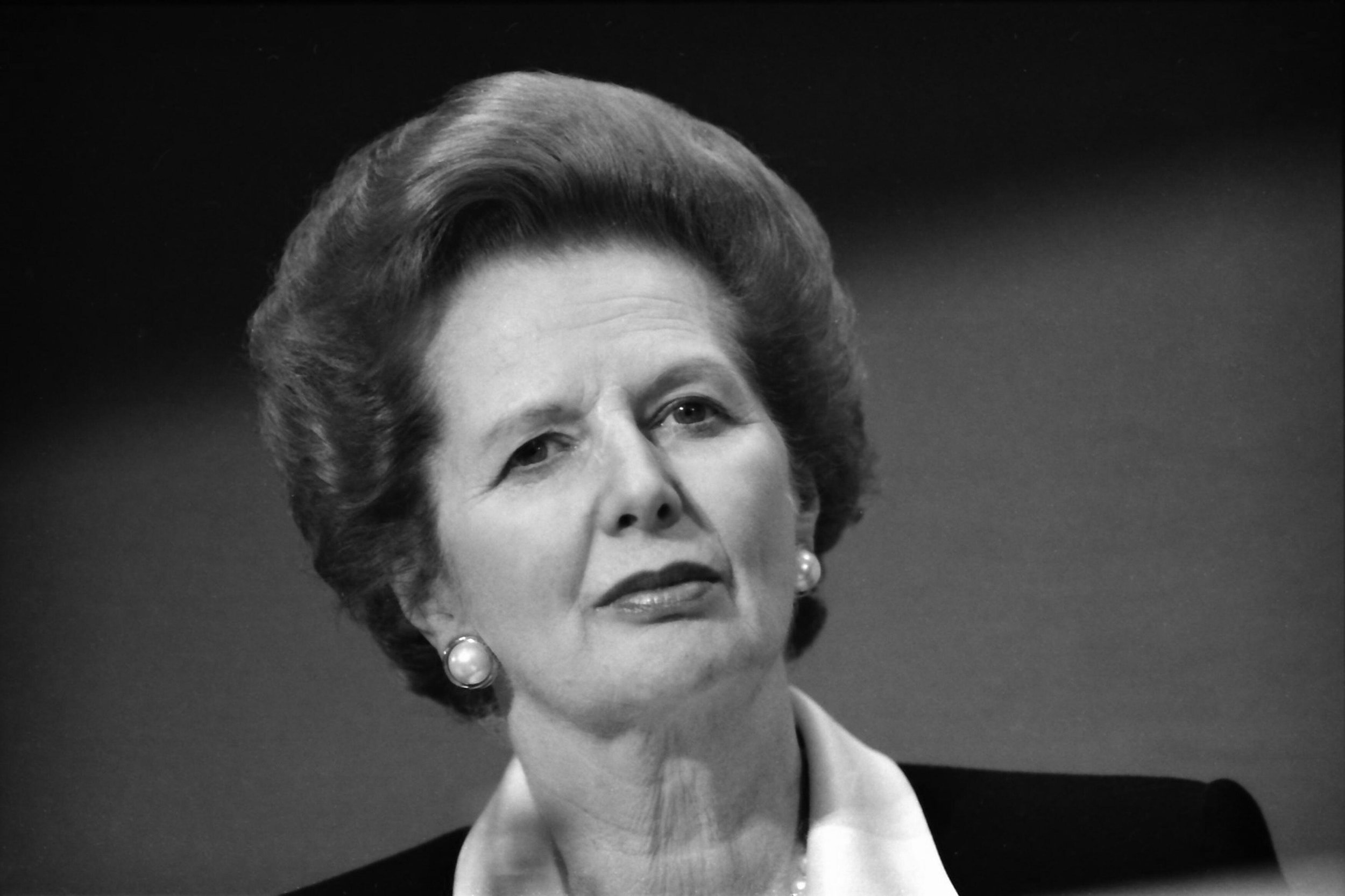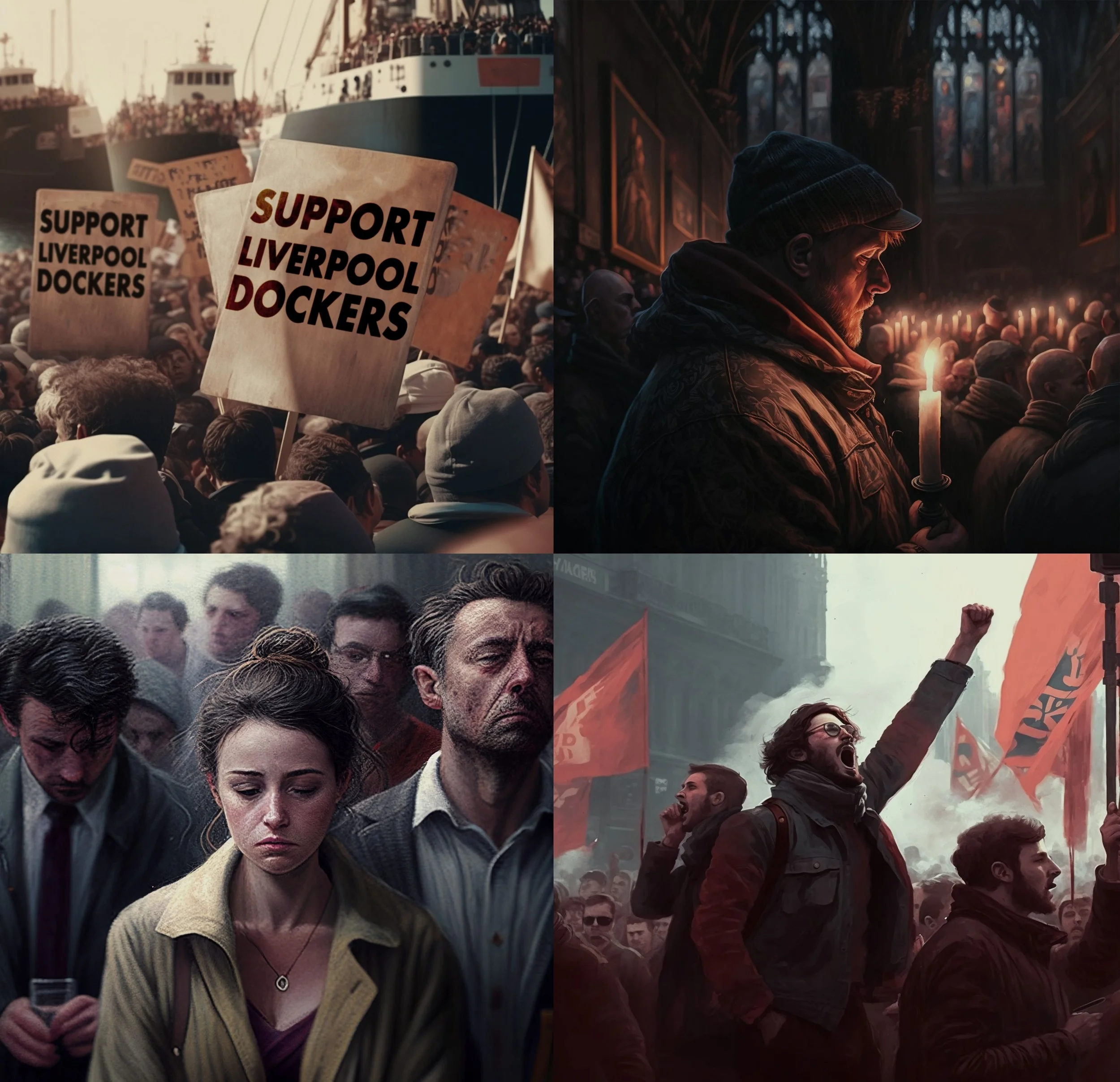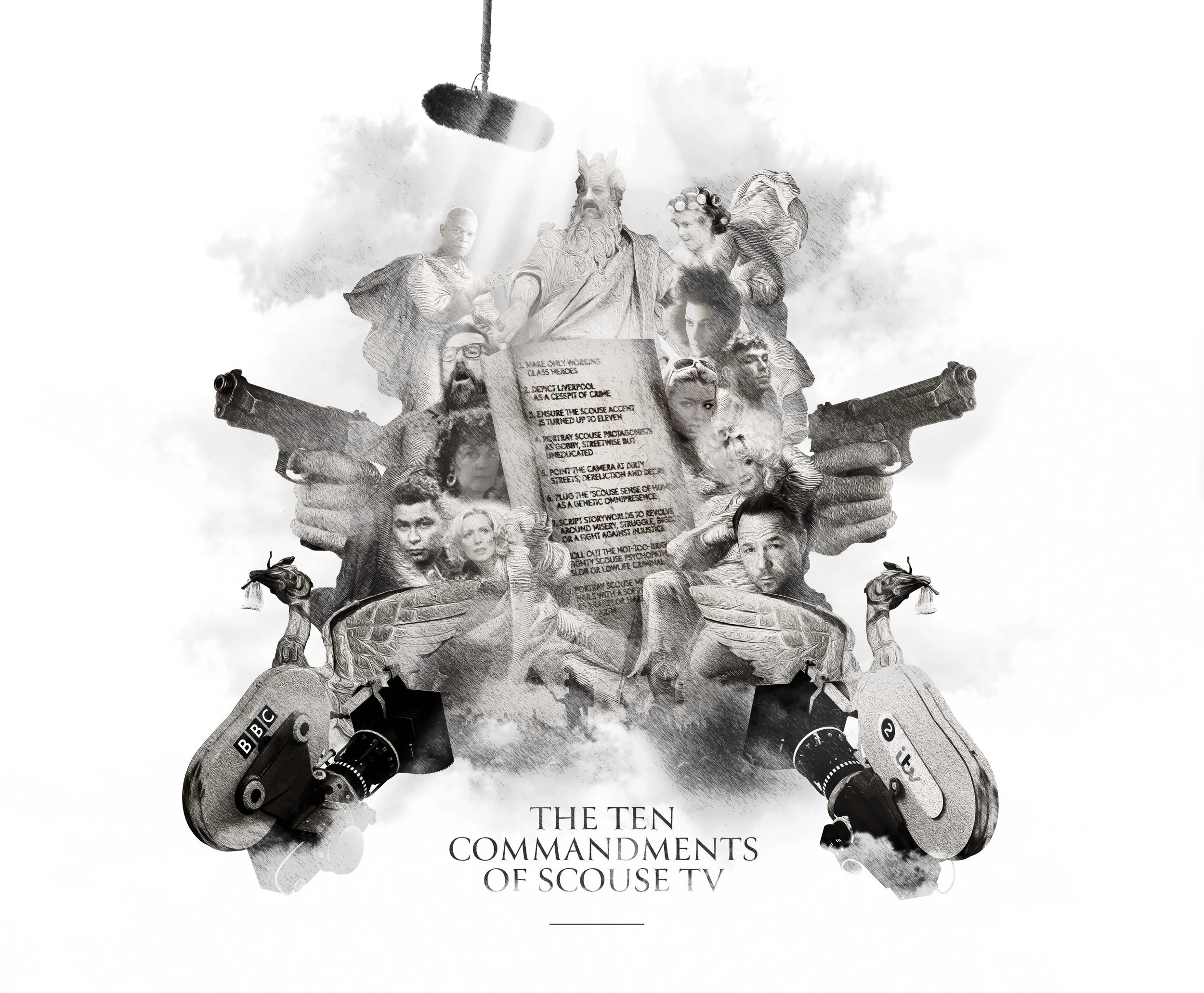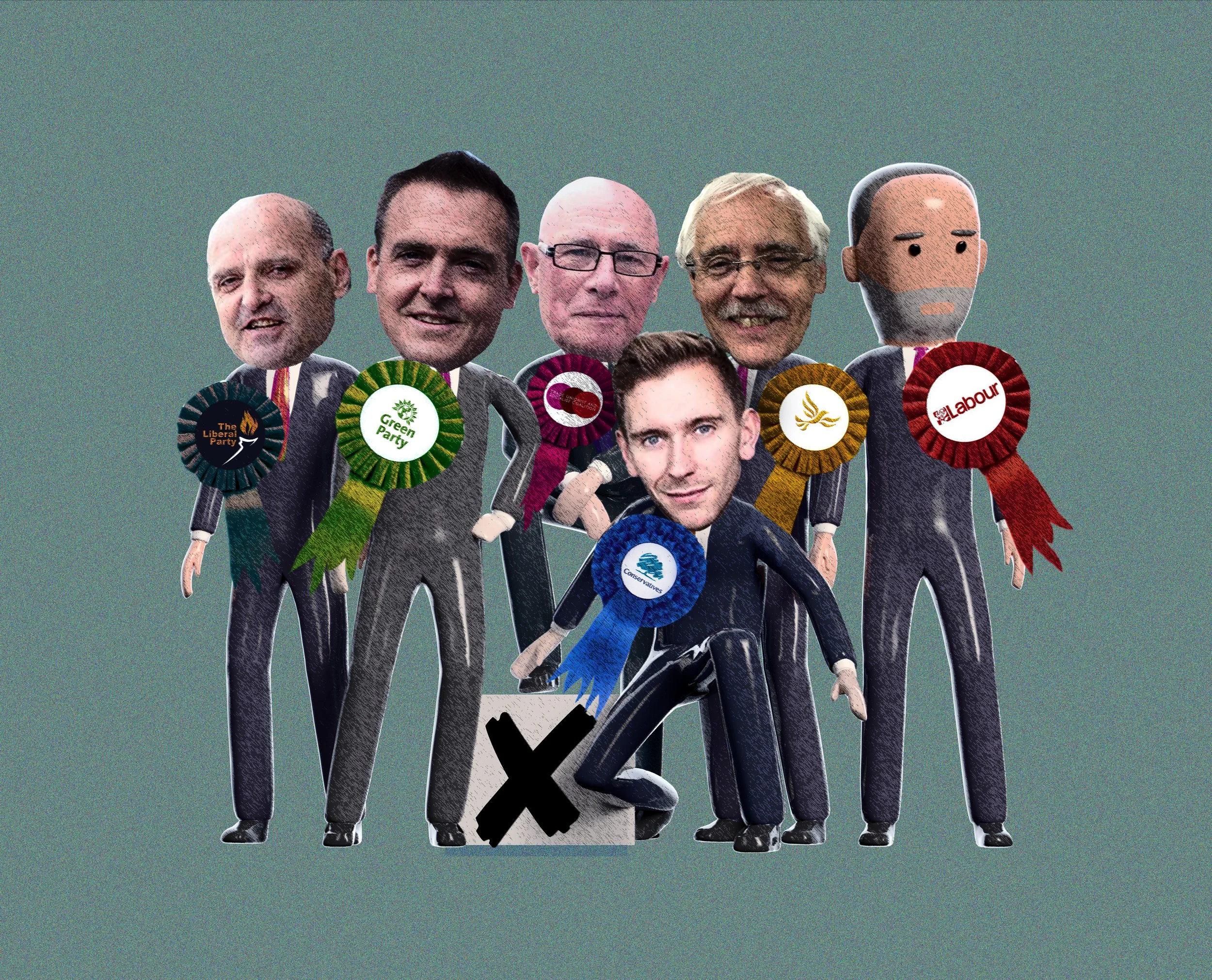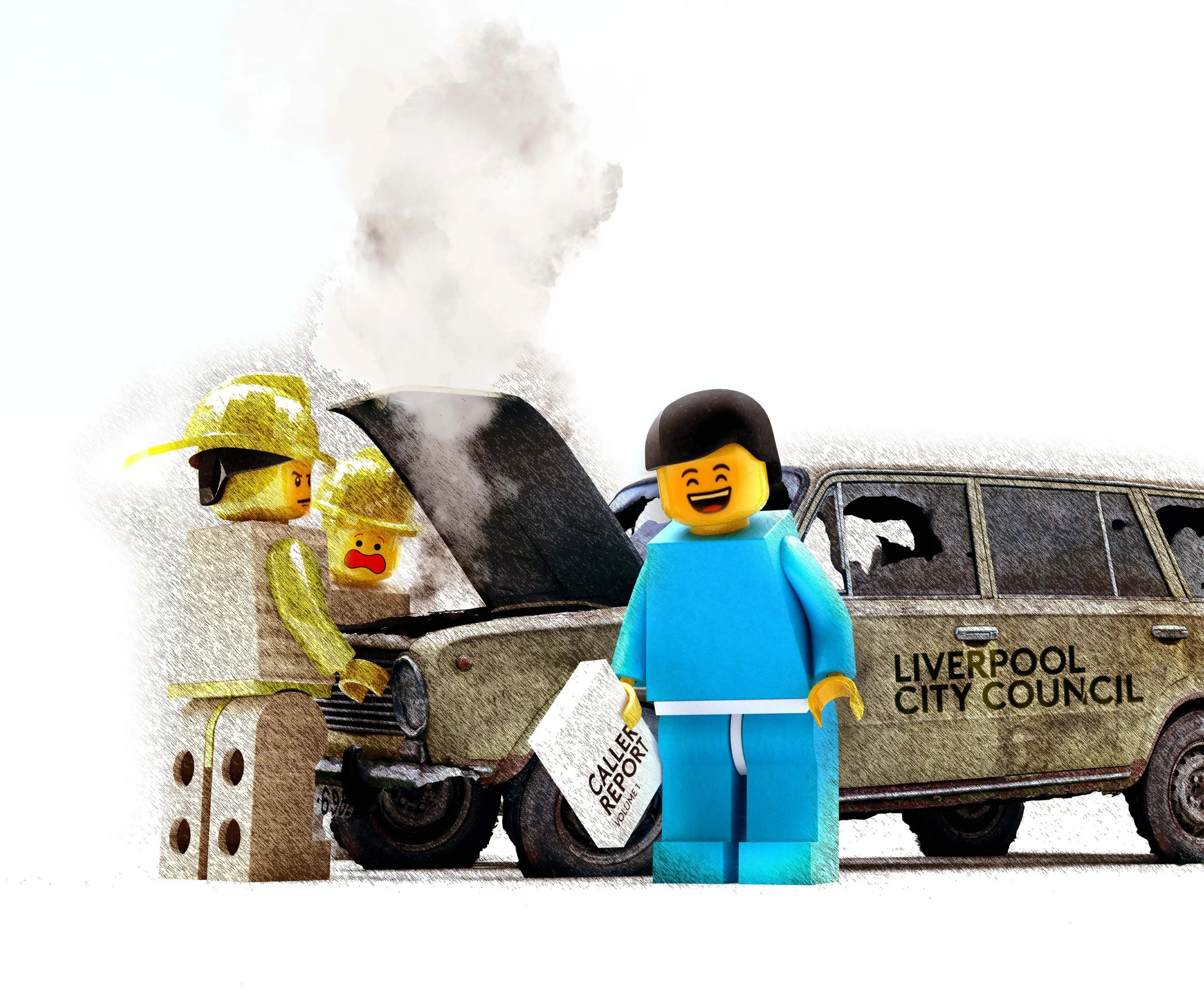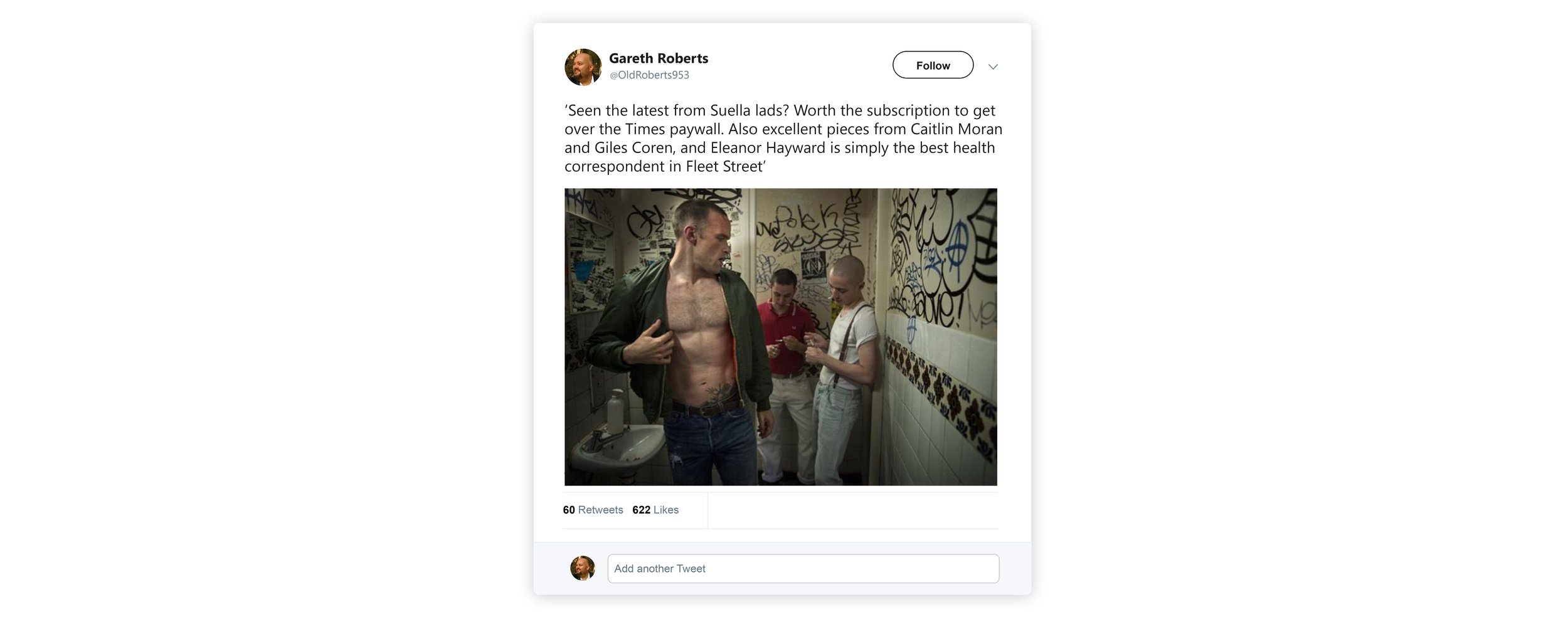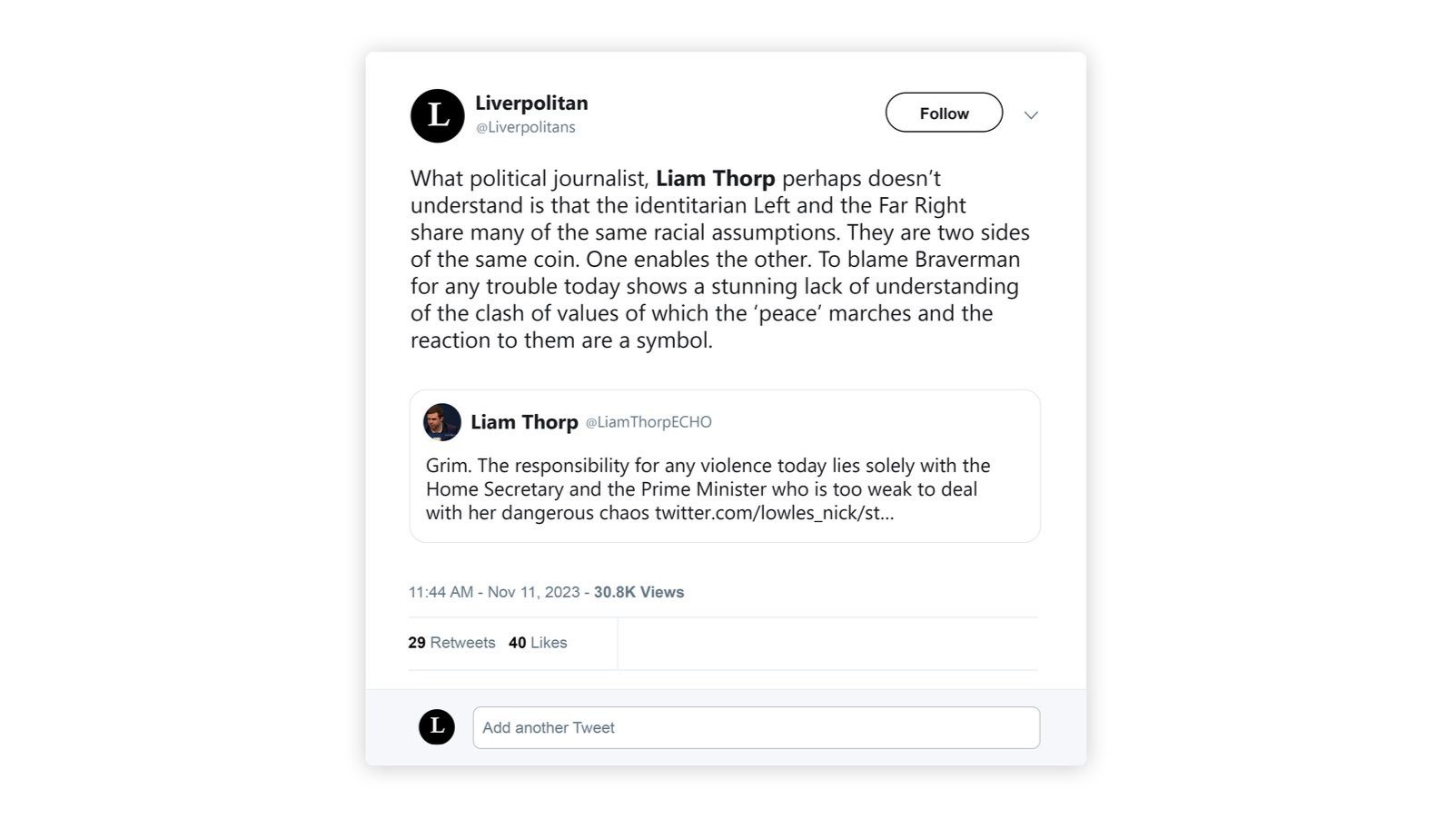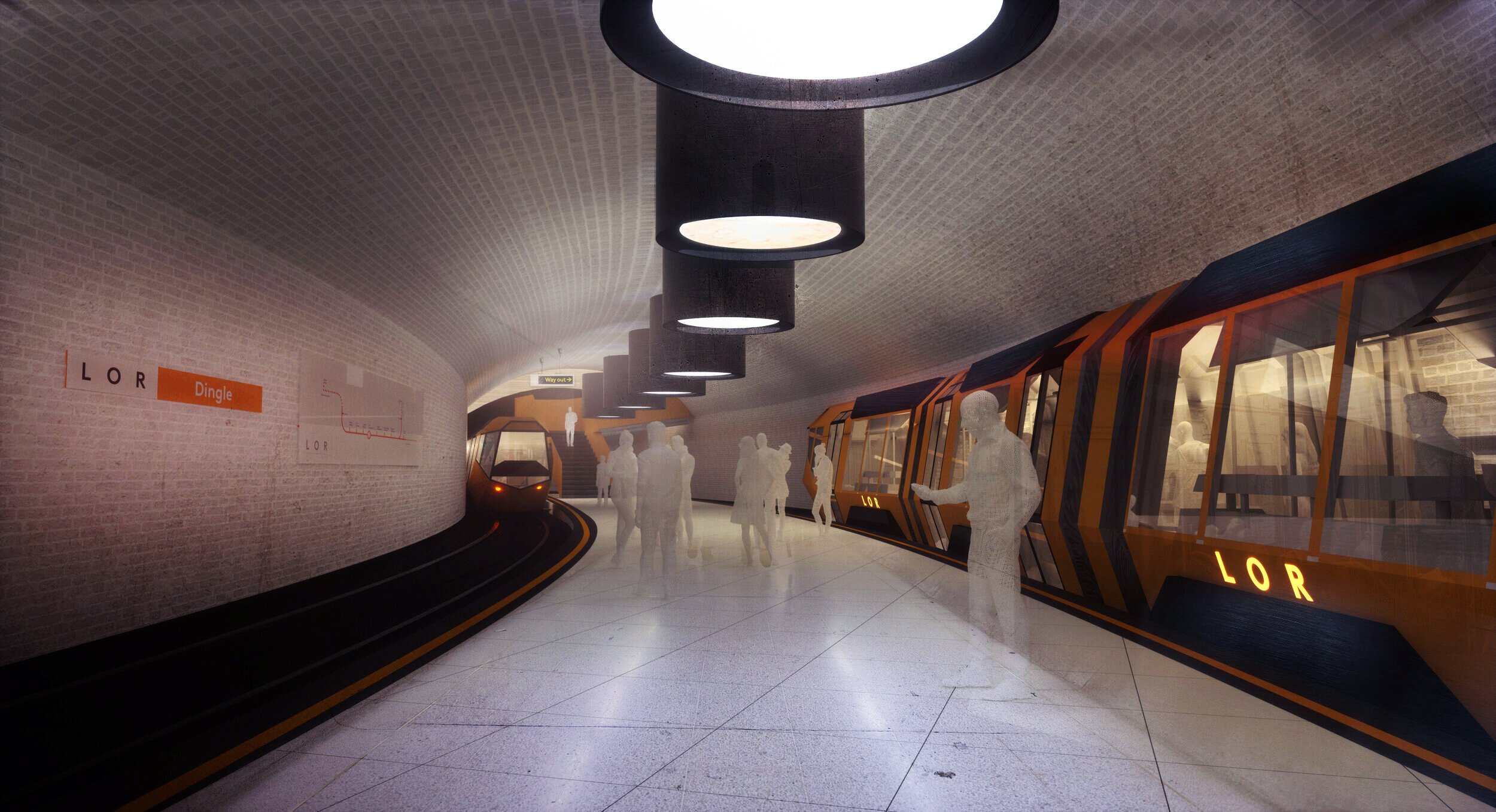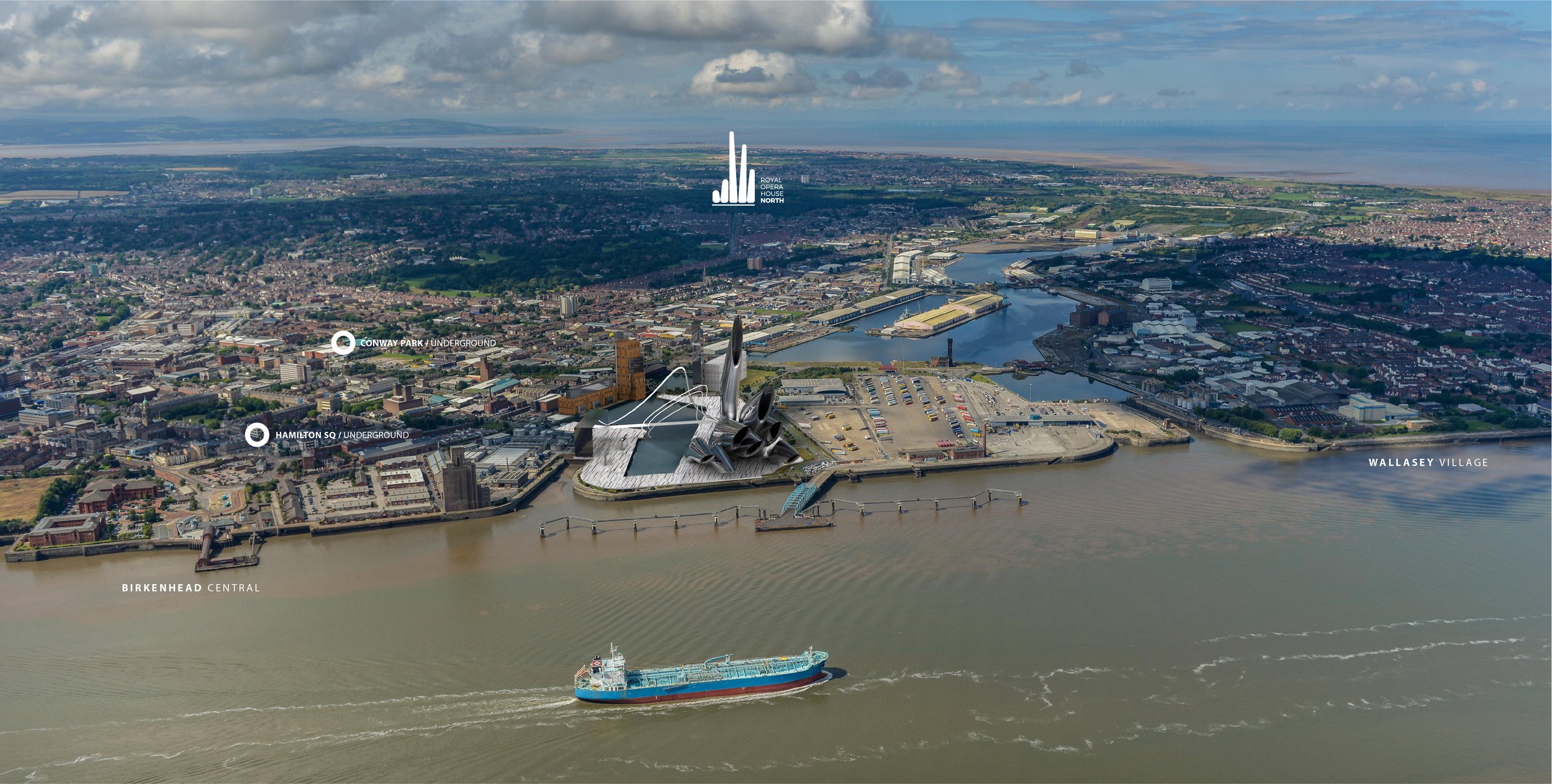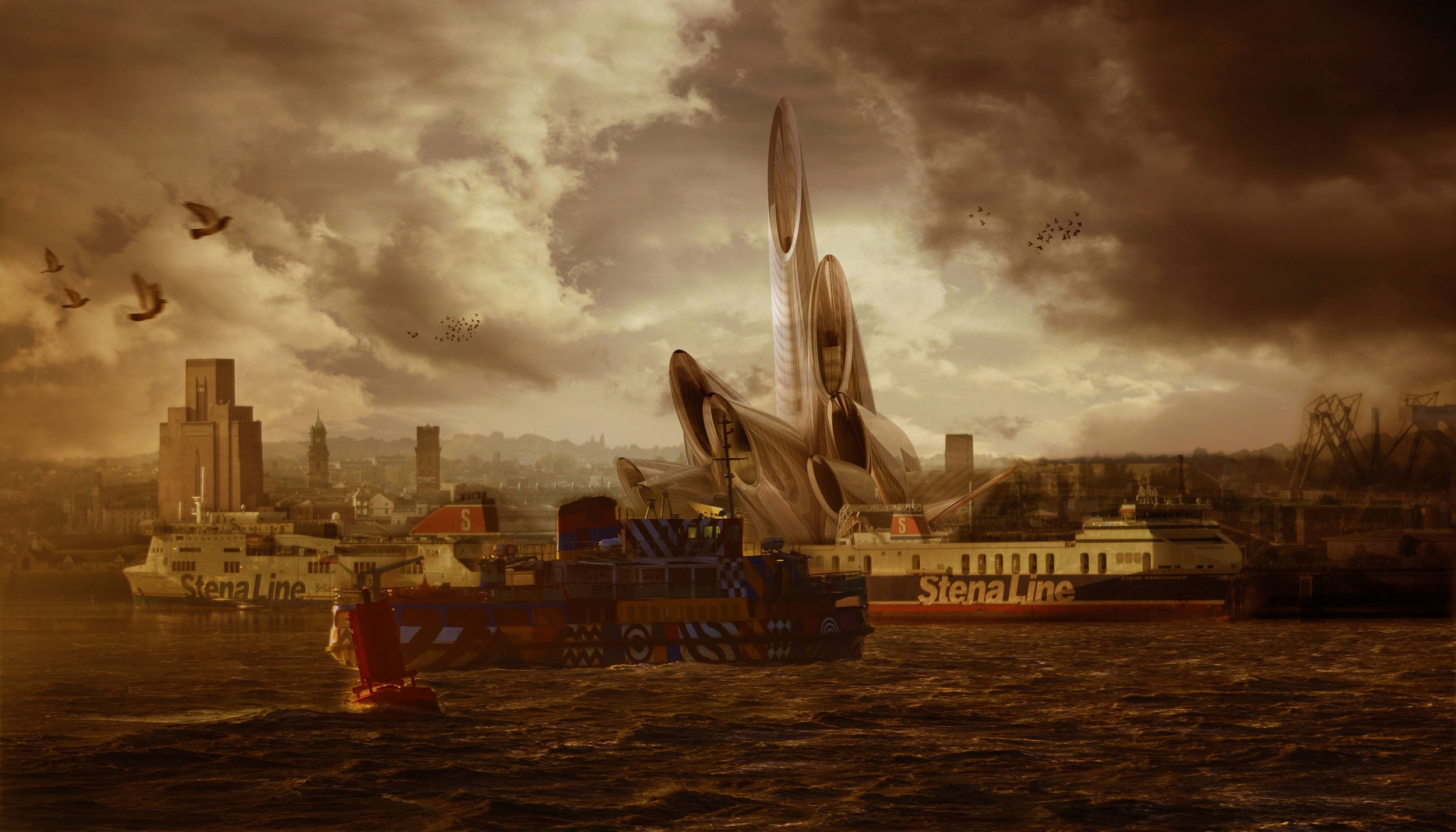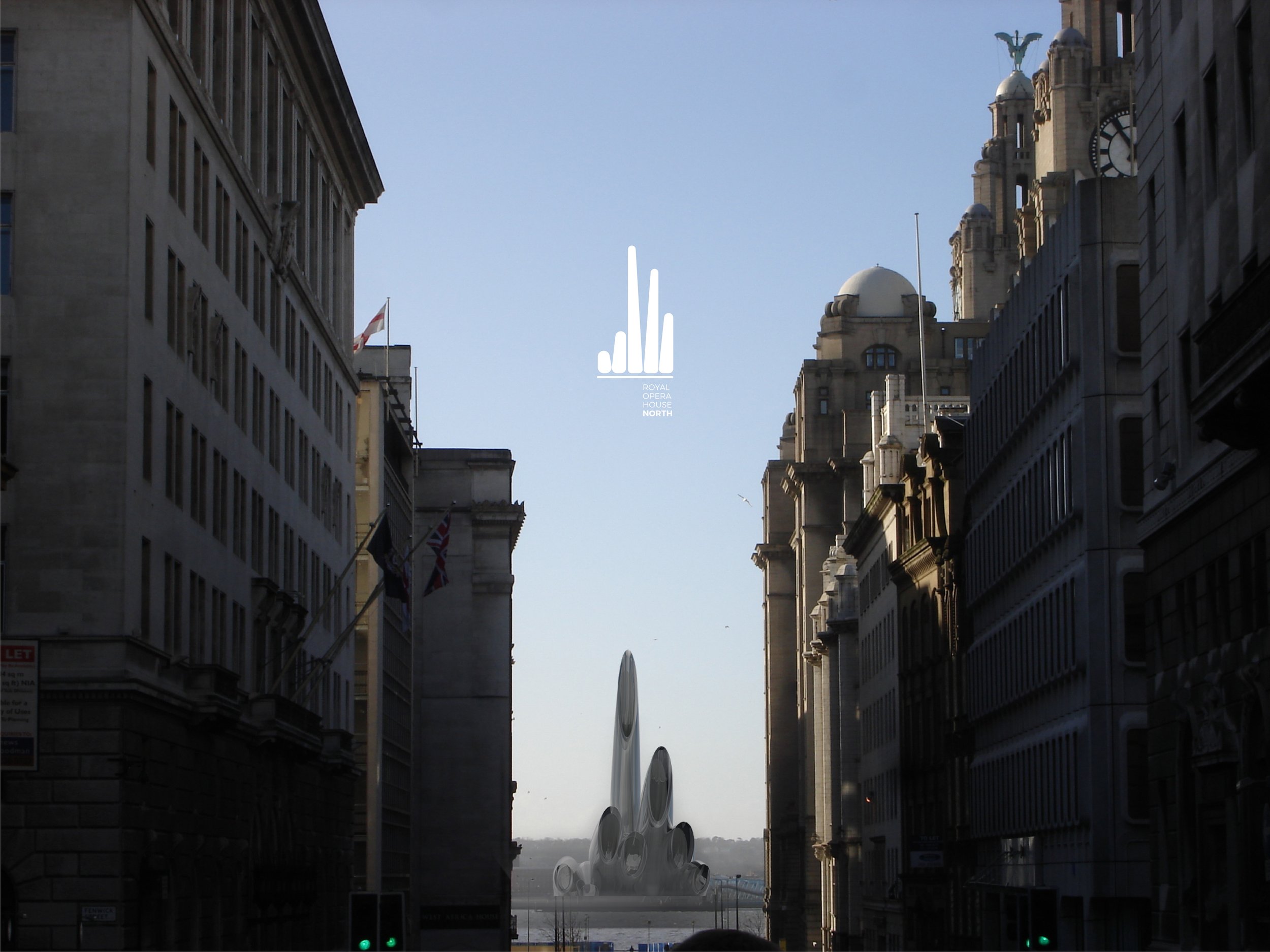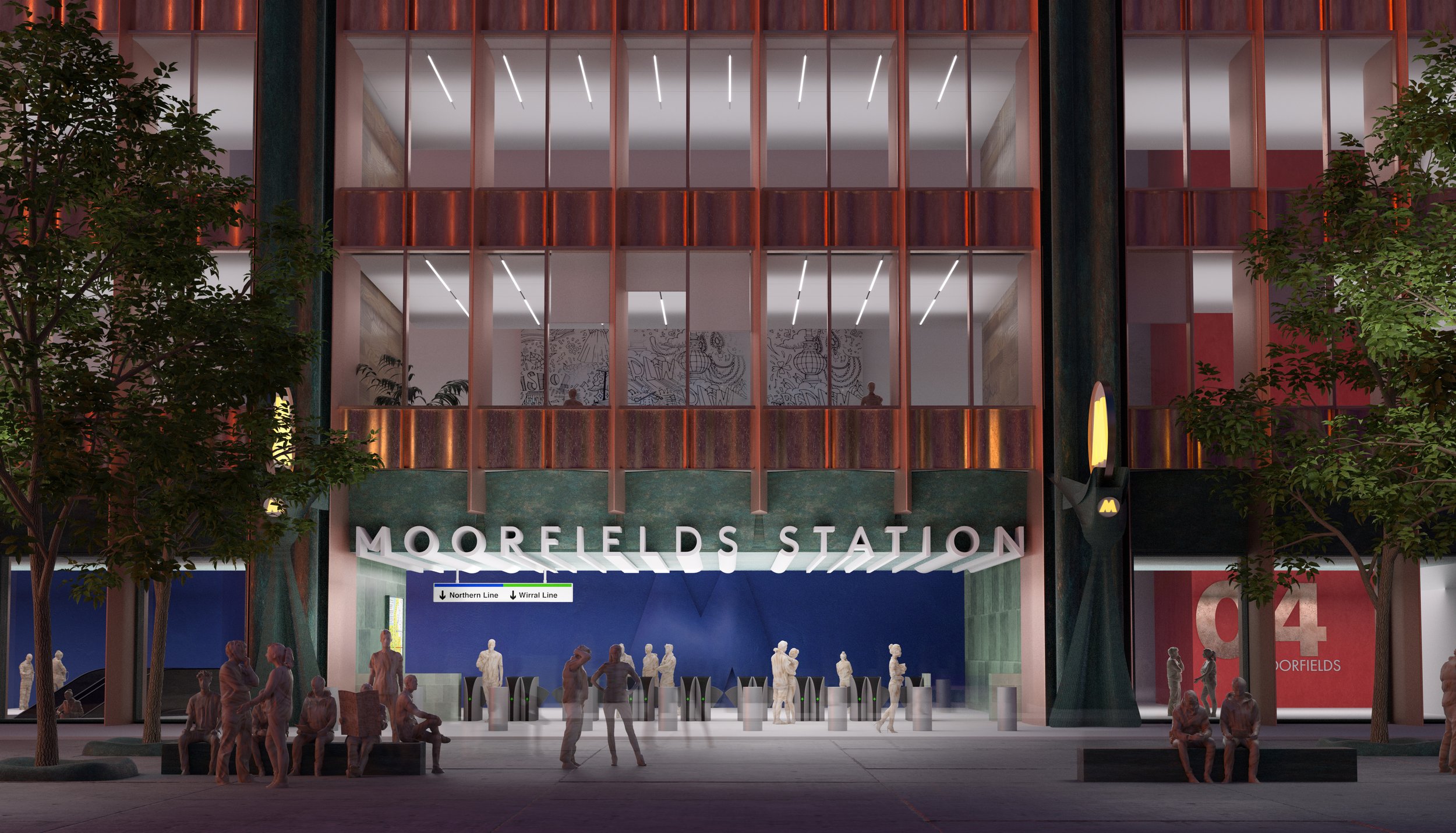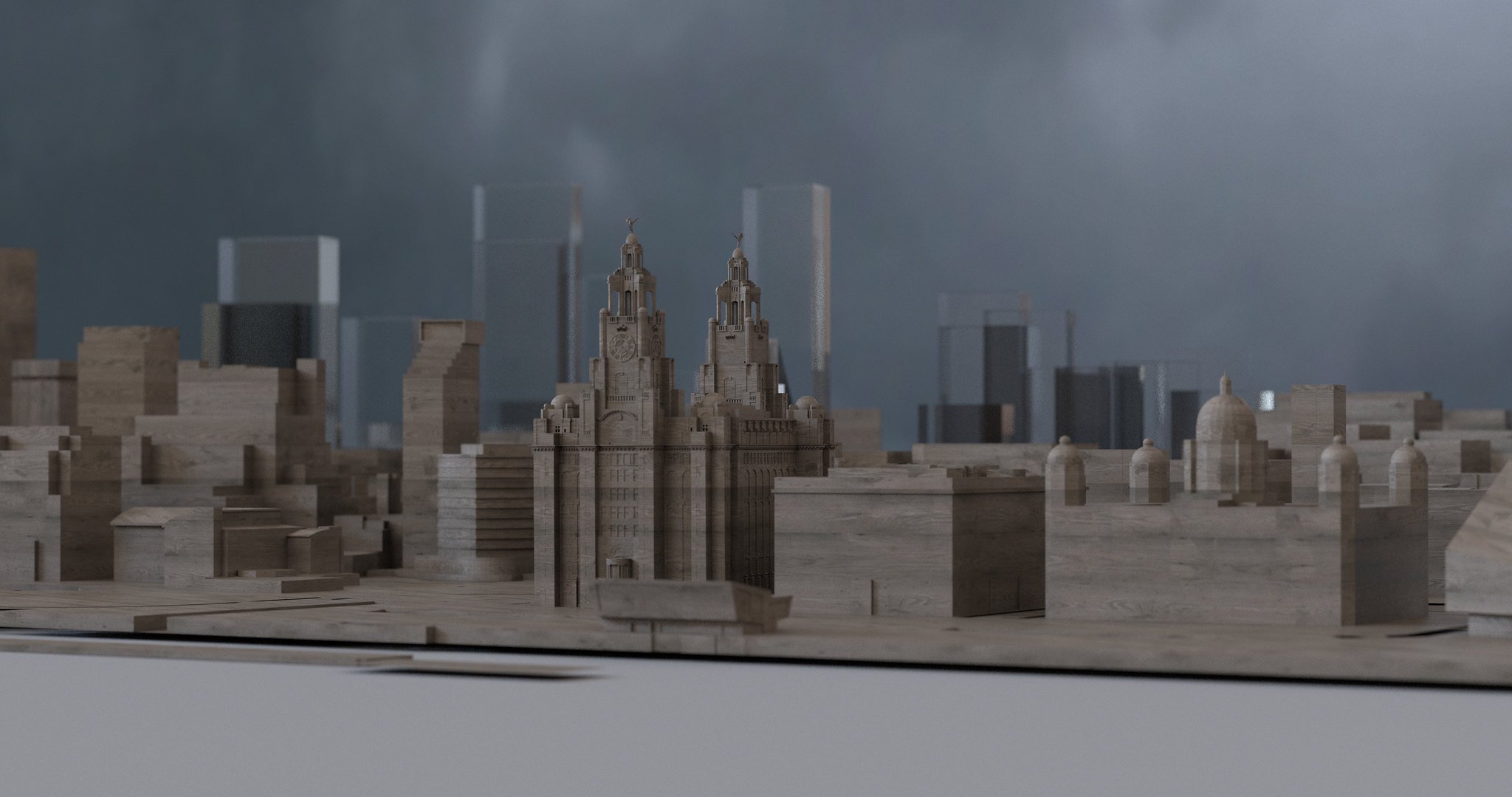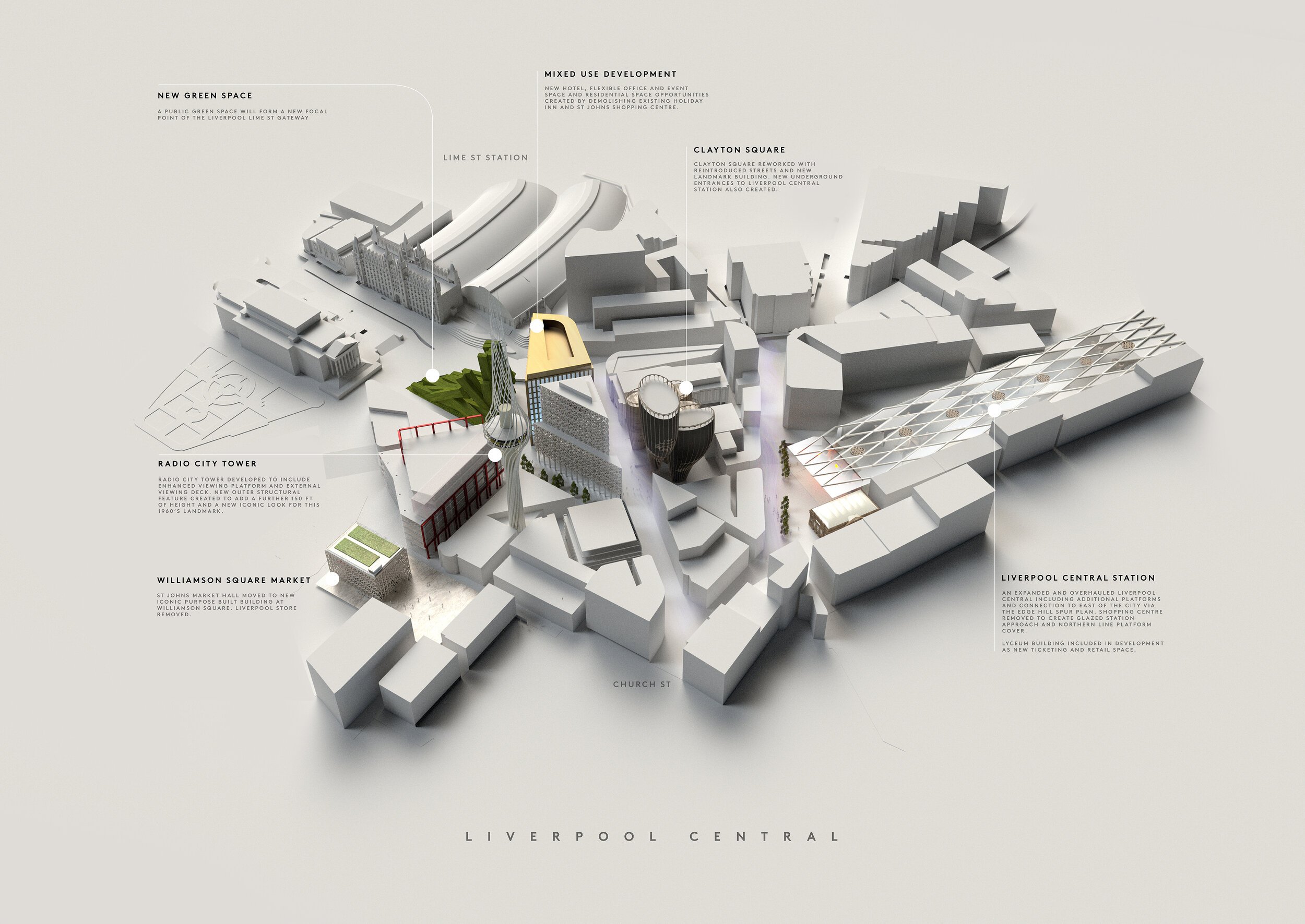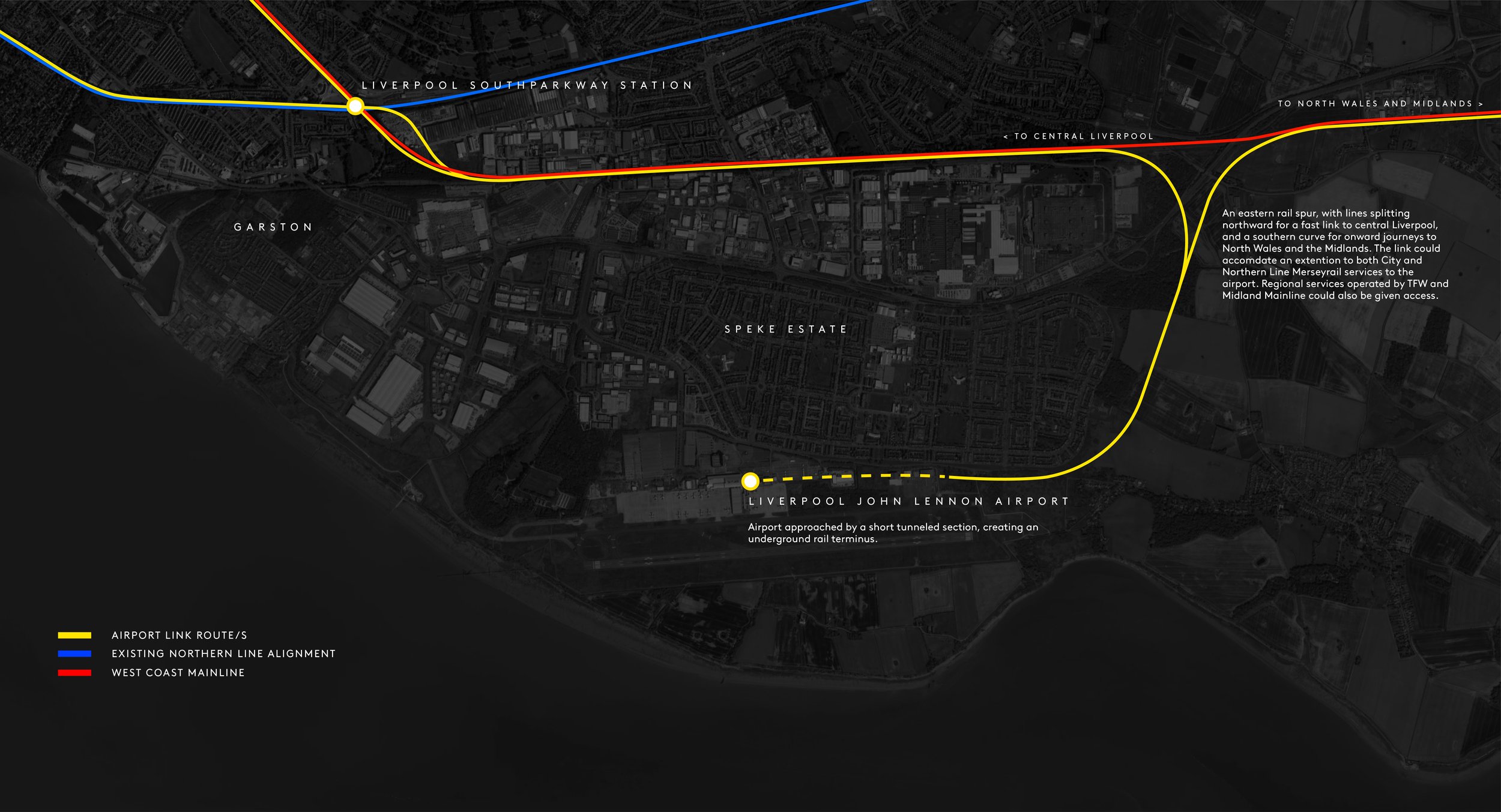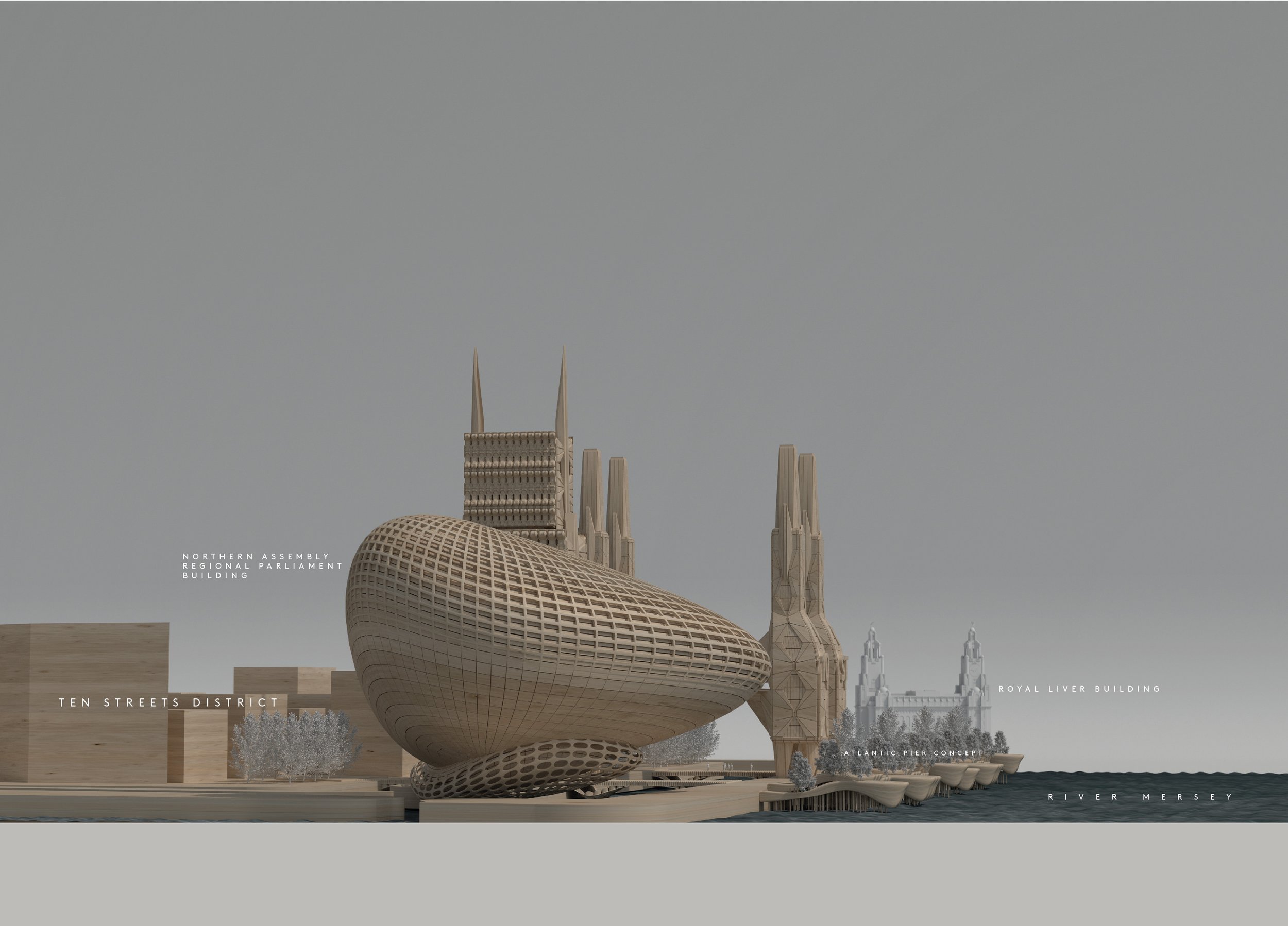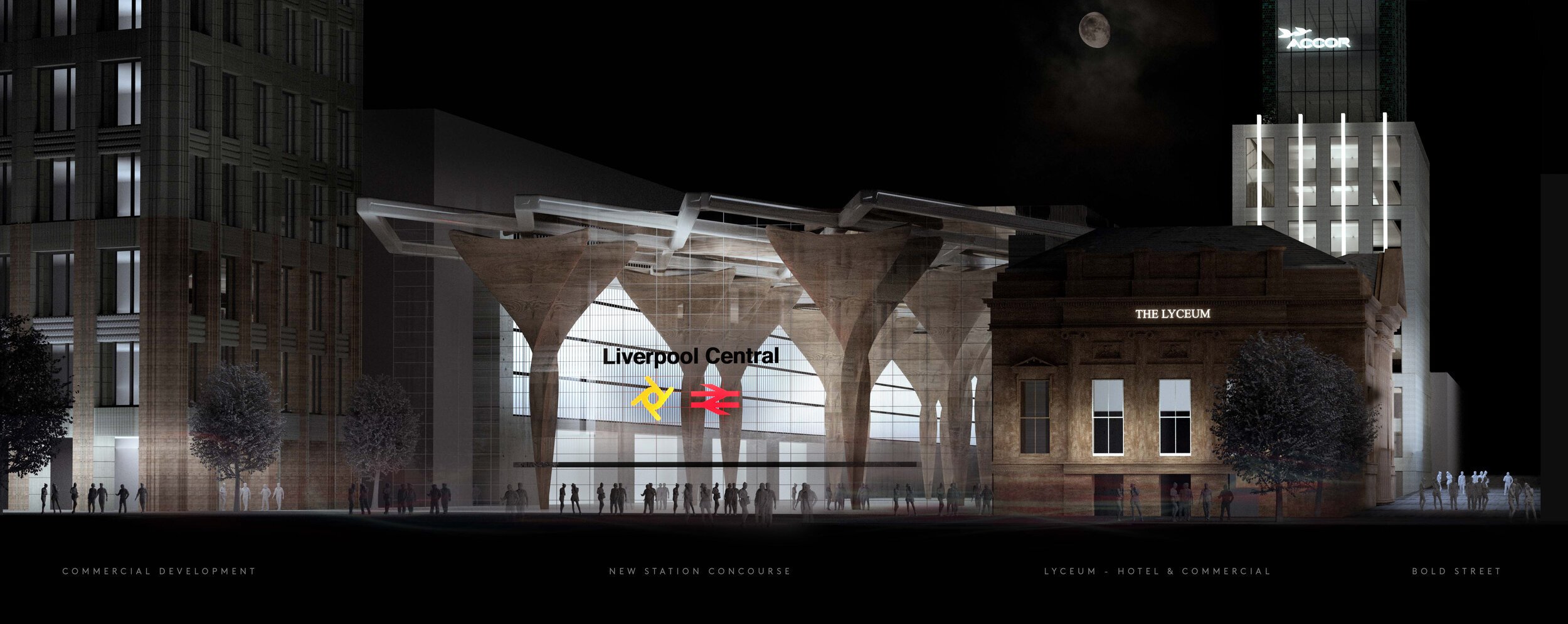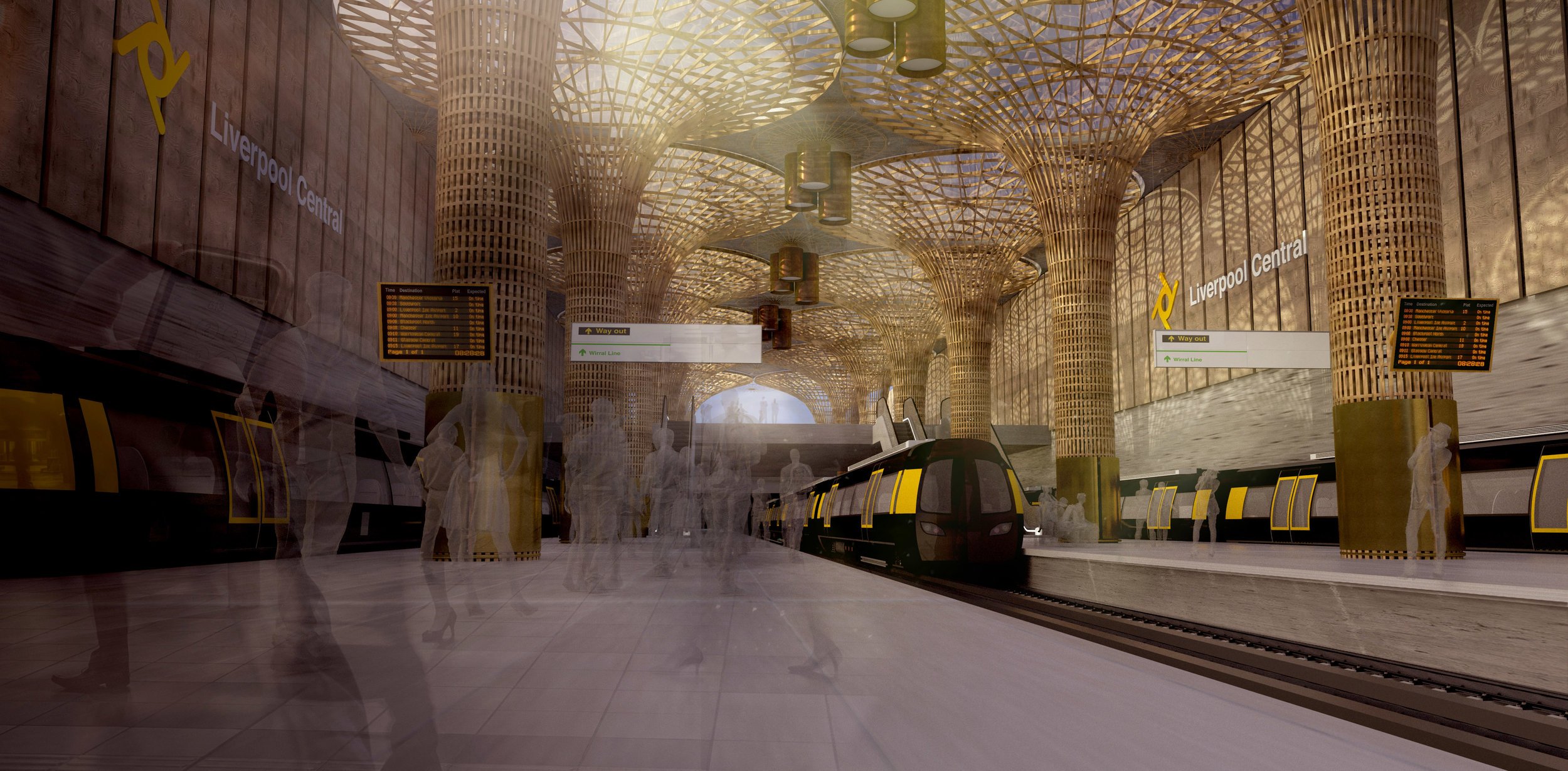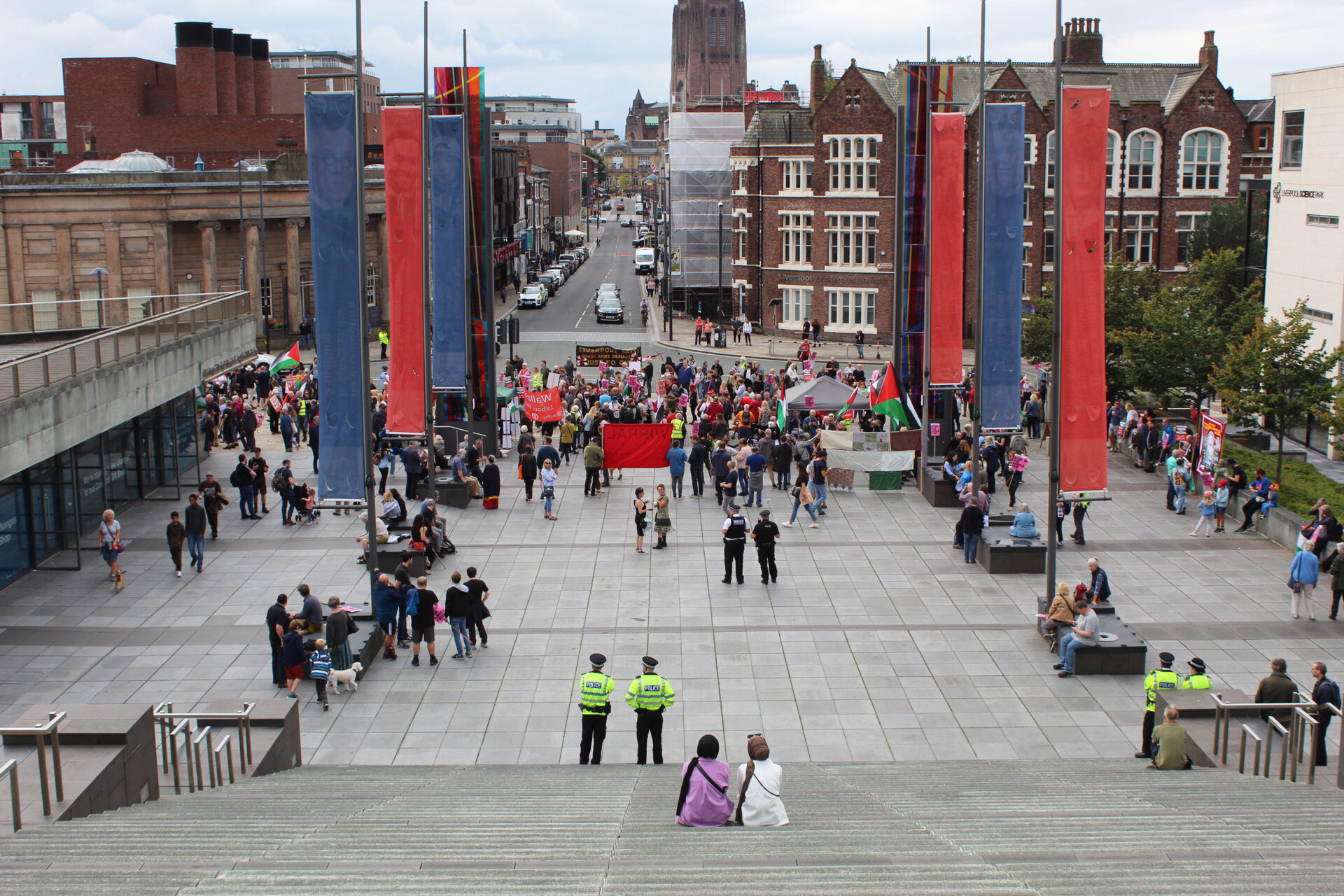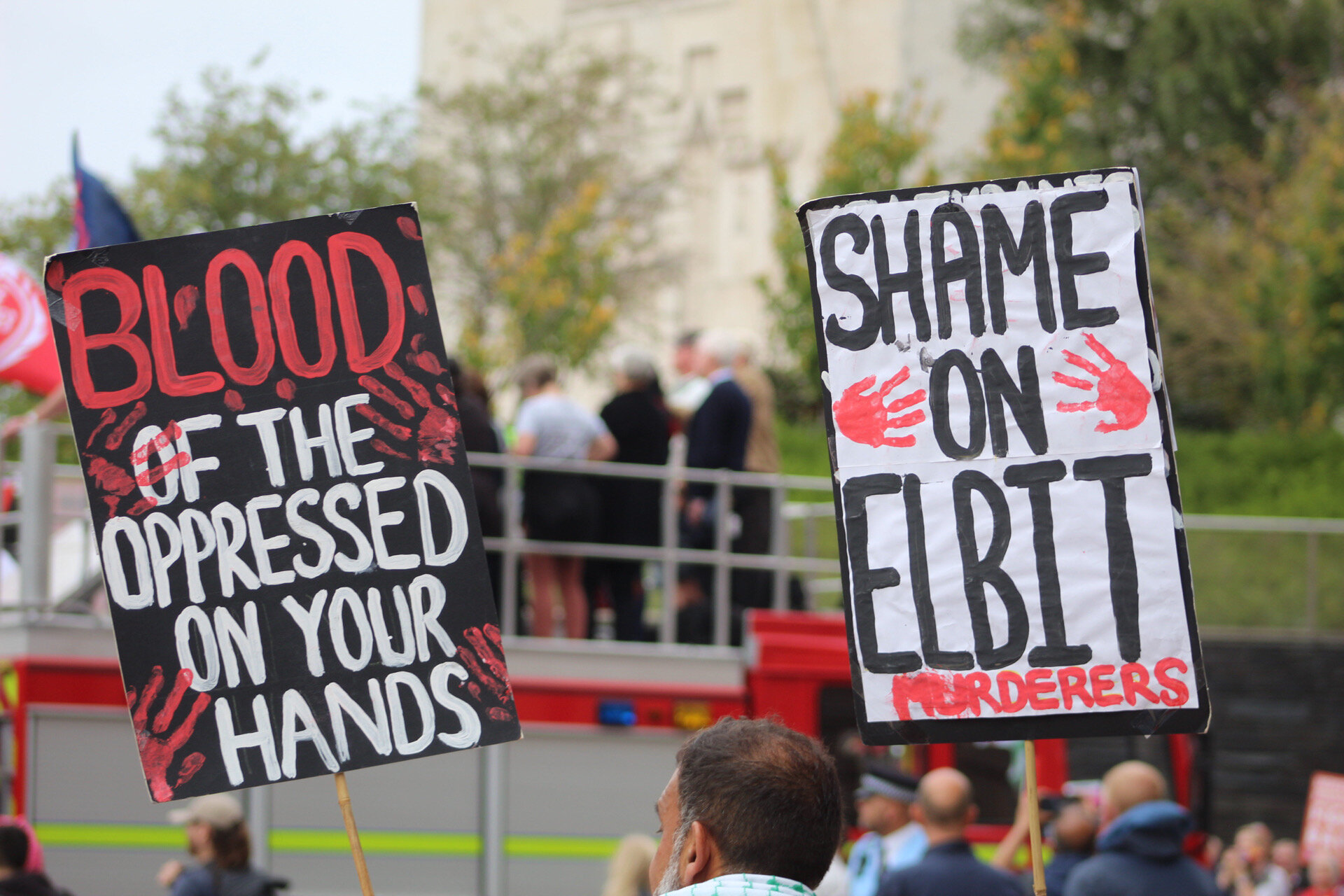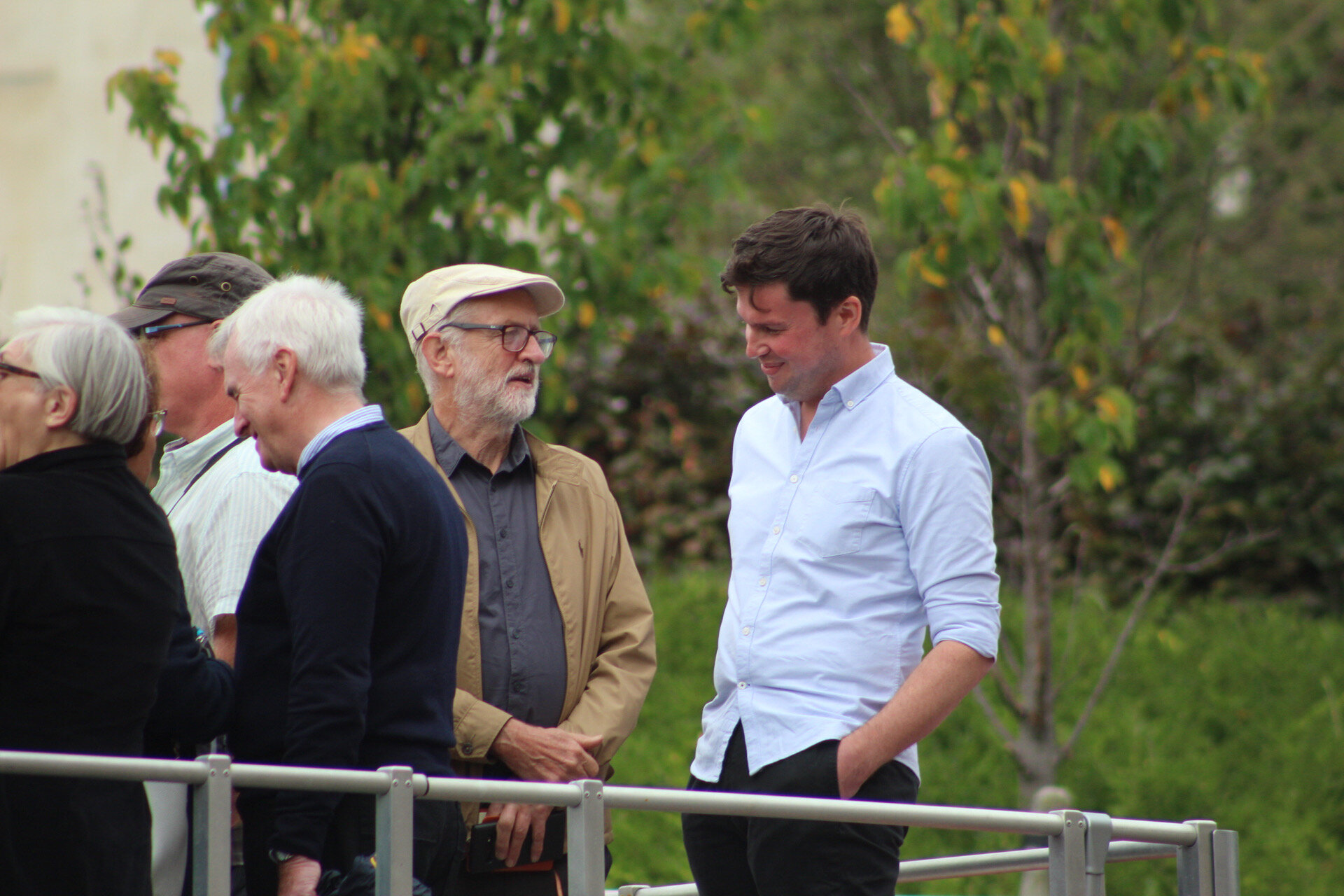Recent features
Israel-Hamas: Britain looks for fascists in the wrong place
In the wake of the Israel-Hamas war, Pro-Palestinian marches calling for a ‘Ceasefire Now’ are attracting ever larger crowds in Britain’s cities. But with the reaction comes a counter-reaction. Are fears that the Far-Right will exploit these tensions to sow mayhem truly justified? Or could it be said that those calling for peace are turning a blind eye to the support for fascism within Hamas and the Free Palestine movement?
Paul Bryan
It was like all their Christmases had come at once. This was the evidence they needed to quash their opponents and get rid of that evil witch, Suella Braverman, the now ex-Home Secretary.
Famed Far-Right pantomime villain, Tommy Robinson had put in a brief London appearance on Armistice Day as part of the counter protest against the Pro-Palestine march, though he quickly fled the scene in a taxi once the police closed in. There was some pushing and shoving and objects thrown as a crowd of white men headed to ‘protect’ the Cenotaph. “Every. Single. One. Of. Them. Was. Looking. For. Blood. Every one,” intoned professional scouser, sports reporter and mind reader Tony Evans, formerly of the Times. After all, he should know. “I live in Pimlico,” he tweeted. Enough said.
The media went to town of course, with Channel 4 News embarrassing themselves with the claim that ‘the only scuffles on the day involved far-right protesters who clashed with police.’ This spurious claim was later deleted.
Meanwhile, that bellwether of over-the-top reaction, polemicist Owen Jones, did his level best to impose a simplistic division of oppressed and oppressor on the marches. “There were two protests,” he tweeted. “One were a bunch of far right thugs intent on violence. The other was a massive Palestinian protest with “no issues”. One was whipped up by politicians and media outlets. The other was demonised by them.” At least Owen, waited for events to unfold (somewhat). The Liverpool Echo’s political editor and sometime Newsnight guest, Liam Thorp, couldn’t wait to get stuck in, tweeting at 11am that “The responsibility for any violence today lies solely with the Home Secretary and the Prime Minister who is too weak to deal with her dangerous chaos.” Why does he always sound like a pound-shop Churchill?
The feeling that the script was already written before the birds had tweeted was overwhelming. So let’s get somethings straight. Members of the Far Right were present in London though their numbers are hard to pin down – I’ve seen everything from 200 to 2000 quoted in the media – a x10 level of confusion that points to the subjective nature of the assessment. Quite what qualifies which members of the crowd were Far Right and which weren’t was not always obvious – though white skin, opposition to the Pro-Palestinian marches and shouting obscenities seemed qualification enough for many pundits. I suspect membership cards of the English Defence League and their like were largely absent but who knows? After all, the Far-Right label is used so promiscuously these days, it’s becoming hard to distinguish between your Mosely’s and your Monetarists. Alan Gibbons, leader of the Liverpool Community Independents seemed to sum up the mood of presumption - “Look, if it quacks like a fascist, chants like a fascist and attacks police like a fascist it's a fascist.” Obviously not spent much time around Red Action then. Anyway, Alan thought he’d found the smoking gun – a picture of a thug with a swastika tattooed on his torso. Labour MP Dianne Abbot was chuffed about it too. Sadly, a quick reverse image search revealed the picture was from 2016 and not in fact from this year’s Armistice Day marches, but let’s not allow facts to get in the way of good story.
Talking of facts, here’s a few – 126 people have so far been arrested in a demonstration involving over 300,000 people. More will most probably follow but the number is thankfully relatively small. Many of those arrests, as one officer explained on the radio, were pre-emptive of serious trouble, the police choosing to use arrests as a method of keeping opposing camps apart. A knife, a knuckleduster and a baton were found as well as some class-A drugs. Nine police officers were injured amidst chants of “You’re not English anymore.”
We’re told the majority of arrests were from the right-wing and according to the Metropolitan Police Assistant Commissioner, Matt Twist this group was largely made up of “football hooligans from across the UK.” The police are now trying to hunt down protesters from the pro-Palestinian side who are accused of that most amorphous of crime/non-crime categories - hate crime, as well as possible support for proscribed organisations like Hamas. Officers intercepted a group of 150 who were wearing face coverings and firing fireworks. Arrests were made after some of the fireworks struck officers in the face.
So there you have it. It got ugly in places, and where it did the police successfully kept a lid on things. But and here’s the rub, I’m struggling to reconcile the relatively small scale of the trouble with the histrionic shout-outs for a disaster averted. The question we should ask ourselves is why were the ‘Ceasefire Now’ crew so excited about the appearance of a scintilla of right-wingers?
“The idea that white, Far-Right nationalists were just waiting for their Asian Home Secretary to let them off the leash is of course absurd.”
I think there are two answers to this question. One is about Suella Braverman and the other is about diverting the public gaze from the horrors of Palestinian violence.
On the first point, LBC presenter James O’Brien, who likes a good quote, couldn’t help giving the game away. “The Home secretary wanted a riot,” he thundered. Does he do anything but thunder? He continued… “Editors of national newspapers, columnists and commentators… ‘pray that there is not a riot at the Cenataph’ they wrote, while licking their lips at the prospect.” Oh, the hypocrisy! It should be clear to everyone that Suella Braverman is everything progressives hate. They were determined to pin this one on her because they wanted her head and they weren’t going to be satisfied until they got it. Right wing violence on Armistice Day was the metaphorical bullet and they were determined to pull the trigger.
I just wish the James O’Brien’s and the Liam Thorp’s of this world would be honest about that – they were licking their lips too. The absurdity of the proposition that it was all Suella’s fault was for me, best summarised by this tweet…
‘Seen the latest from Suella lads? Worth the subscription to get over the Times paywall. Also excellent pieces from Caitlin Moran and Giles Coren, and Eleanor Hayward is simply the best health correspondent in Fleet Street,’ wrote Gareth Roberts.
The idea that white, Far-Right nationalists were just waiting for their Asian Home Secretary to let them off the leash is of course absurd. But it reveals how the public is increasingly viewed by the political class as mindless puppets who will do whatever they’re told. If it wasn’t for Suella, the logic goes, the yobs would have stayed at home, ironing their flags of St George. They were ‘inflamed’ by her words, unleashing the beast within. As if.
The other reason for the lip-licking is all too transparent. It’s the finger pointing of the anti-racist. ‘Look’, they say, ‘only racists and white supremacists would not want to join our side in our quest for a Free Palestine. Israel is an apartheid state. Join us, as we march from the river to the sea.’
“For all the focus on the threat of Britain’s rump of a right-wing and their historic focus on immigration and racial purity, do you not see a far more extreme mirror of that vile ideology in the rantings of Hamas and Hezbollah?”
These tactics are destined to fail because there are many who can see through them and don’t want to become apologists for a form of Islamofascism. Yasser Arafat, the one-time Chairman of the Palestine Liberation Organisation (PLO) and leader of the supposedly more tolerant Fatah Party, once said, “We will not bend or fail until the blood of every last Jew from the youngest child to the oldest elder is spilt to redeem our land.” What do you think he meant exactly? For all the focus on the threat of Britain’s rump of a right-wing and their historic focus on immigration and racial purity, do you not see a far more extreme mirror of that vile ideology in the rantings of Hamas and Hezbollah? Except, unlike the EDL, these ‘liberators’ have the weapons and the resources to kidnap, maim and kill, as well as making victims of their own people.
Calling for a Ceasefire Now means leaving Hamas intact, free to pursue future campaigns of horrific barbarism. More October 7ths. No thank you. Not for me.
Israel-Hamas: Collective insanity threatens to overwhelm us
In the aftermath of the Pro-Palestine marches in London and the much smaller counter-protest, a game of political ping-pong has ensued. Videos clips are being swapped online from all sides as a new digital currency in moral certainty. Have you seen the one of fascists surging past the police? Yobs! Right-wing scum. Yes, but have YOU seen the one with the Palestine supporter saying, “Hitler knew how to deal with these people.” Islamic fascism right there. Yes, but what about those WHITE supremacists causing mayhem at the train station? What, you mean the one where a protester shouts “death to all Jews.” And so it goes on…
There’s a danger that we’re all about to lose our heads and if we let it, it could get ugly.
Now, I don’t want to give the impression that this is about to be some country vicar, Thought For The Day style piece, urging a gentle middle road, while papering over the cracks in our civilisation with kind words and a cup of tea. There is clearly a huge amount at stake. But I would at least ask everyone to take a deep breath and not assume the very worst motivations from those who find themselves on the opposite side of the fence. There lies the path to de-humanisation and all that goes with it. Rather than summoning partial evidence to prove a point that we know deep down does not represent the full picture, maybe we should look for the courage to acknowledge the flaws in both camps.
Is this image dehumanising? Owen Jones thought so but others disagreed. If we are forever re-defining words to mean whatever we want them to mean, we will lose our ability to think straight. Perhaps that’s the point. Image: Twitter; cartoon originally from Ramirez, Las Vegas Review Journal for the Washington Post.
I for one am critical of the Pro-Palestinian ‘peace’ marches. I just don’t think they represent what their supporters claim, hopelessly entwinned as they are with Islamicist influences favouring a free Palestine ‘from the river to the sea’. A recent article in the Telegraph showed six of the organisations behind Saturday’s London march had connections to Hamas including Muhammad Kathem Sawalha, a former Hamas chief who co-founded the Muslim Association of Britain. This is not a good look. To me, too many people are diving naively in with their eyes closed to the movement’s nasty antisemitic underbelly and risk turning themselves into willing tools of groups who do not share their values and who use apologists consciously and calculatingly as cover. But even I have to admit that many of the protesters clearly mean well – responding to the horrific pictures coming out of Gaza with a natural, empathic desire to put a stop to the suffering. Clearly, they hope that silencing the guns can be a first step in finding a new and lasting peace process in which all can reconcile and heal deep wounds. This is an admirable instinct and should be recognised (when it’s not premised on virtue signalling), but I’d put it in the category of viewing the world through the lens of how we want it to be, rather than how it is really is.
Palestinian leadership have rejected every peace offer that’s ever been put on the table – in 1947, in 2000, and 2008. Negotiations have swiftly been followed by rockets and bombs. Meanwhile, the Jewish settler movement, aided with a nod and a wink by the administrations of Israeli Prime Minister Benjamin Netanyahu, appears to believe it is their God-given right to continue encroaching on the West Bank. As one settler infamously explained a few years back, while attempting to take possession of a property that wasn’t his, “If I don’t steal it, someone else is gonna steal it.” This is religiously inspired entitlement as cover for our basest instincts.
A prized peace cannot hold in the iron grip of absolutism. For all the blood and rubble, you cannot negotiate with someone whose only vision of the future is wanting you dead and gone. Especially ones with a scripture-endorsed death wish where, as author and podcaster, Sam Harris puts it, sadism is “celebrated as a religious sacrament.” Those who have watched the raw footage of the October 7th massacre have described how the killers were elated at their deeds. Douglas Murray for the Jewish Chronicle recounts chillingly, how one Hamas terrorist called his parents back in Gaza to boast that he had killed ten Jews “with my own hands.” Ecstatic with joy he received the praise he desired - “Their boy had turned out good.”
“A prized peace cannot hold in the iron grip of absolutism. For all the blood and rubble, you cannot negotiate with someone whose only vision of the future is wanting you dead and gone.”
There is a secularist presumption at play that all people basically want the same thing – peace, security, a roof over their head, good schools, full bellies and a decent job. But what if it’s not true? Here in the West, this ‘humanistic’ presumption is mapped onto the Israel-Hamas conflict even if it doesn’t apply to all the protagonists. People calling for a ceasefire now, such as the RMT union leader, Mick Lynch end up thinking with a bit of good grace and a fair wind the Israelis and Palestinians can be convinced to sit around a table and hammer it out. As if this was a negotiation over terms and conditions. From this perspective, when confronted with the reality of suicide bombers and hideous acts of barbarity, the question is asked - how could this be? What could turn people to such extreme behaviour? And the prescription as Sam Harris characterises it, is always the same – “they must have been pushed into it…their entire society oppressed and humiliated to the point of madness by some malign power. So many people, he says, “imagine that the ghoulish history of Palestinian terrorism simply indicates how profound the injustice has been on the Israeli side.” And some might argue that the extremities of the Jewish holocaust layered on century after century of cruel pogroms have had a similar effect on the Jewish psyche. But perhaps these explanations are all too neatly packaged for the contemporary western imagination. In an interview with Piers Morgan, psychologist and author, Jordan Peterson makes the point that the sins of the father are visited on their children. That we may not wish life was like this, but it is – generations of bloody violence echoing down in retribution. It’s hard to break the cycle, not impossible, but hard, especially when you add a strong dose of religious certainty that can make even good people do bad things.
Maybe, just maybe, the cries to martyrdom reveal a deeper, unsettling truth about the role belief plays in violence. Maybe the people of the region need to look deep within to question the core ideas that shape their coda.
Paul Bryan is the Editor and Co-Founder of Liverpolitan. He is also a freelance content writer, script editor and creative coach.
@thePabryan
*Main image: Mark Kerrison, Alamy
Ye Wha? Opera on the Mersey and other Mad Visions
For over ten years, 3D animator Michael McDonough, has been dreaming up new ways to re-imagine Liverpool’s urban landscape – designing outlandish opera houses, cathedral-like train stations, gothic bridges, and new visions for the docks. None of them have been built or are ever likely to be. But why does he bother? In this showcase of his work, Liverpolitan Editor, Paul Bryan explores Michael’s fascinating dreamscapes of the imagination.
Paul Bryan
“The way I come at things is to make no small plans. The city has had too much of that, too much dross, too much crap, too much small time thinking.”
So says Michael McDonough, Co-Founder here at Liverpolitan, and a man who has developed a bit of a reputation for his outspoken criticism of Liverpool’s (lack of) development scene. And in fairness, it’s a view that I, as the magazine’s Editor, often share.
One of the things that makes Michael interesting to me (other than the fact he’s had to develop skin as thick as a rhinosaurus to bat off ‘the army of gobshites’ who take him on or even pose as him online) is the fact that despite a successful career as a 3D designer and animator which has taken him to the capital, he continues through his design work to try to make a positive contribution to his home city of Liverpool and the discussion about its future. He does this without fanfare or gratitude and in fact, often in the face of quite complacent criticism from ‘locals’. Often by people with far less talent or insight than himself. For over ten years now, entirely under his own steam, Michael has been dreaming up new ways to re-imagine Liverpool’s urban landscape – designing outlandish opera houses, cathedral-like train stations, gothic bridges, and new visions for the docks. None of them have been built or are ever likely to be. They are not fully formed architectural plans, more dreamscapes of the imagination and we’ve made a showcase of that work in this feature article.
But why does he bother? What’s the point? Aren’t they just castles in the air built before AI and Midjourney made fantastical images the prerogative of all? To believe so would be to miss what’s really going on. There’s a much harder edge lying beneath the glossy visuals. He’s making the case for ambition as an antidote to a city-wide loss of nerve.
“We should be thinking in the same way world cities do like London, Singapore and New York. All these places have big ambitions. We should be looking to emulate that,” says McDonough. Instead, he believes Liverpool increasingly seems resigned to a lower status and too often its mediocre plans reflect that. Small schemes are favoured over transformative ones and then heralded as being the way forward. Anything substantial or showy is typically treated with hostility and suspicion.
“I keep hearing that in Liverpool we’re different, that we have our own models of success, but it’s a language of defeatism, masked and airbrushed as some kind of urban superiority.” He rejects this idea totally. “Being different doesn’t mean you reject ambition, scale and big ideas. That doesn’t make you different, it just makes you stupid.”
‘There’s an obsession in Liverpool’s planning circles with ‘context’ – the idea that new developments must be submissive to the city’s crown jewels."
Michael’s designs are meant in sharp contrast to the veritable cottage industry of ‘place-making’ peddlers, much favoured in recent years by our city leaders, whose low aspiration output chimes with this defeatist mindset. Meanwhile, the same old local architectural practices win job after job, churning out budget off-the-shelf buildings that further erode what makes the city special. There’s an obsession in Liverpool’s planning circles with ‘context’ – the idea that new developments must be submissive to the city’s crown jewels. But that attitude just results in bad buildings and Michael’s designs deliberately shun such restrictions. Some of his designs will inspire, but also enrage.
“The irony,” says McDonough, “is that those buildings we love so much are there purely because of ambition, because of power and commerce. They didn’t just land there as gifts from God.”
The point of history is to learn from it, not to fetishize it. We do Liverpool’s history a disservice by feeble attempts at mimicry. The Liverpool of yesteryear was bolder and more global in its perspective and if we are to take something useful from the past, it should be that. What Michael is attempting to do with these designs is to remind the city that it’s capable of bigger ideas, capable of re-imagining itself, capable of statement architecture, and capable of challenging its city rivals.
“What pushes me to create these designs is a desire to make people see the city differently – and by that I mean primarily the people who live and work within it. Because if we can awaken that boldness of old, so much is possible in our future,” says Michael. That is the lens through which he’d like people to view his designs. Of course, design is subjective. What might be considered beautiful by one person, can be viewed as horrendous by another but he claims to welcome those reactions. “One of our motivations for founding Liverpolitan magazine, was to create a place where thoughts and ideas on the city’s built environment could be shared, discussed and visualised – to think beyond self-constrained limitations,” he concludes. And indeed that is part of our mission.
So buckle in. This is Michael’s contribution. We hope others will be inspired to contribute in the future. It’s a long read. You may need a cup of tea. But there are lots of pretty pictures and food for thought.
Enjoy.
English National Opera, Liverpool
Post-Eurovision, Liverpool emerges with its reputation for hosting big events enhanced and attention inevitably turns to ‘what next?’ So how should the city attempt to capitalise on this positive exposure? Capitalise being the key word here – turning the benefits of a one-off event into something long-lasting, and preferably given a tangible physical form.
Step forward candidate 1: The English National Opera (ENO). This prestigious London-based institution has been told by its funders, Arts Council England, that if it wants the purse strings to remain untied, the institution needs to up-sticks and move to the regions, and rumour has it that Liverpool is very much on the short-list. Some will question why a city like Liverpool needs opera, but even if Tosca and Turandot are not your kind of thing, attracting such a high profile organisation will only add to Liverpool’s cultural offer and open up new job opportunities for young people who might otherwise fly the nest.
Dreaming up a new opera house on the banks of the Mersey, is something that dates back to the wild and unfunded dreams of former Mayor Joe Anderson. But this time, at least in theory, the prospect sounds a little more plausible. Not fully plausible mind – a recent article in The Post claimed the move might be more northern outpost than wholesale relocation, akin to Channel 4’s setup in Leeds. Still, it’s not completely out of the equation – especially if a new facility could combine uses with other functions – education, meeting space, performance arts. Back in 2021, the then-chancellor, Rishi Sunak allocated £2m for a feasibility study into some kind of new immersive music attraction. So despite initial talk of yet another Beatles-focused space, perhaps there’s scope for blending these projects onto one site to make the whole more achievable.
‘The point of history is to learn from it, not to fetishize it. We do Liverpool’s history a disservice by feeble attempts at mimicry.’
The most obvious location is the site of the now defunct former police station headquarters at Canning Place off the Strand. It’s a big site in a glamorous location with the potential to integrate the city centre more closely with the Baltic Triangle. In scale, Michael is proposing a building similar to the much lauded Copenhagen Opera House, which also has a waterfront setting, but he’s keen to avoid any slavish adherence to ‘context’ – “the space is big enough to create its own”, adding new aesthetic design cues to Liverpool’s urban environment rather than forever replicating (usually in impoverished form) what is already there. For Michael, this means “no warehouse-style blocks, no red-brick, and a departure from straight lines.” Some have said they can see a cobra snake in this design and others an elephant (hopefully not of the white variety). “I didn’t intend either but if they’re there, they’re there,” says Michael. “It’s all about organic, smooth, natural forms.” The final two images in the set, which show the interior of the main auditorium, were created using artificial intelligence more as an experiment in what is possible with the technology.
As an added bonus, Michael is proposing to demolish the John Lewis car park, which adds a “blocky barrier to the growth of the city centre eastwards,” as well as eroding the sense of occasion that this landmark structure deserves. A new solution would have to be found for the bus depot that sits beneath it (not to be confused with the Paradise Street Bus Station which would remain unaffected).





Liverpool Overhead Railway
Many people have long been fascinated by the Liverpool Overhead railway and perplexed by its loss. Extending seven miles along the length of the city’s impressive docklands from Seaforth and Litherland in the north to the Dingle in the south, the line survived for just 64 years before the decline in dock employment ate too deeply into its commuter base. There can be little doubt that if the Overhead Railway had survived into the modern era instead of being dismantled in 1956-57, it would have become another iconic symbol of Liverpool reminiscent of the Chicago ‘L’ trains. Not only that, but it may have long ago expedited the regeneration of the north docks into other uses. Instead, minus viable transport provision, we have had to watch on powerless as docks have lain derelict for decades under the tattered banner of Liverpool Waters.
As much as it’s fun to sit within an old Overhead carriage within the Liverpool Museum (and marvel at its spacious dimensions and varnished wooden interiors), Michael would much prefer to see it rebuilt. The case is becoming stronger with the soon to open Bramley Moore Dock Stadium, the Titanic Hotel and new apartments in the Tobacco warehouse extending the city centre and creating a line of activity to the attractions centred around the Albert Dock.
‘The Liverpool Overhead Railway may have long ago expedited the regeneration of the north docks into other uses. Instead, minus viable transport provision, we have had to watch on powerless as docks have lain derelict for decades under the tattered banner of Liverpool Waters.’
However, Michael says “we cannot and should not merely recreate a pastiche of the old line.” Technology and engineering have moved on, and the old structure was difficult and expensive to maintain. Besides, its heavy-set viaducts blocked views of the river from further inland, which might be unwelcome today. If the city are ever to rebuild the Liverpool Overhead Railway, he feels it should “celebrate the past but not be beholden to it.” A little like London’s Docklands Light Railway (DLR), his version 2.0 is a fully-fledged railway, not a monorail, elevated by organic and elegant concrete columns that avoid the blocky and very nineties form of the DLR design.
To maximise its utility, Michael’s new Liverpool Overhead Railway would not simply follow the old route but would connect more widely. Starting at Bootle in the north to better integrate that area as part of our metropolis, the line would connect the Everton stadium and key attractions centred around the Albert Dock before heading off south to the airport, and perhaps also east via the disused Waterloo or Victoria tunnels. The design of the structure would be modern, and the trains capable of running on conventional tracks (like the recently introduced Merseyrail ones) opening up options for integration with the wider rail network.
Royal Opera House North & Wirral Cultural Centre
At Liverpolitan, we’ve always believed the Wirral Waterfront to be Liverpool’s great missed opportunity. Overlooking one of the finest riverside vistas in the world, the left bank of the Mersey should be prime real estate, and yet it’s almost apologetically unimpressive – as if frightened to upstage its more famous brother. Surely, we can do better? “People laughed at the idea of Salford Quays hosting the BBC and the Imperial War Museum North,” says Michael, “but with its spectacular setting, the Wirral Waterfront should be aiming higher again.”
Two waterfronts, one city has to be the future but to really make that idea count, at some point we’ll need a significant intervention in the landscape. Wirral Council are doing good work in master planning a new Birkenhead with a better relationship to the river and Liverpolitan is all for it. But to seal the deal, argues Michael, “the Wirral needs something that stands out, something that can be seen from the Liverpool side – something that says ‘Look at me, come over to the Left Bank.’”
Given the 0.7 mile width of the Mersey between Liverpool and Birkenhead, any new landmark structure would need to be huge, gargantuan even. Taller than the 210 feet Ventilation Tower. Possibly taller than the 328 feet Radio City Tower. Cathedral-like in scale and presence. It was along those lines that McDonough put forward this earlier concept for a Royal Opera House North – aligned so that “you can see it as you look down Water Street – the two sides of the river visually connected with an iconic landmark; a catalyst for seeing Birkenhead through new eyes.”
The design is dominated by a series of steel funnels with a glinting chrome façade pointing in all directions of the compass including skyward. They would be wrapped around a central auditorium which could also have uses as a cultural centre exploring the Wirral’s fascinating history from the Vikings to its use as a monastic retreat, not to mention shipbuilding and its colourful background as a smugglers paradise.
‘The Wirral needs something that stands out, something that can be seen from the Liverpool side – that says ‘Look at me, come over to the Left Bank.’
Liverpool HS2
It’s all gone a bit quiet on the High Speed 2 railway project hasn’t it? Maybe that’s a good thing – just get on and build it. But for Liverpolitan, HS2 has always been something of a poker-tell, not so much about the lack of commitment of the national government to invest anywhere outside of the south – which to be honest, we can all take for granted. No, what HS2 really reveals in full technicolour is the shallowness of Northern solidarity – some places, most notably Manchester and Leeds are consistently favoured over others like Liverpool and Newcastle. Despite the sweet words of ‘King of the North’, Andy Burnham, arguments about agglomeration are forever used to draw money and opportunity towards these investment blackholes and away from everywhere else. And HS2 has been the smoking gun. More’s the pity that Liverpool’s own leaders have been too foolish to notice (or they never cared).
When the Conservative government announced the Integrated Rail Plan for the North and Midlands in late 2021, the media was full of a wailing and gnashing of teeth. Cutting HS2’s eastern leg to Leeds and scaling back plans for Northern Powerhouse Rail was seen as more evidence of the perfidiousness of London and Whitehall. Right on cue, Liverpool’s often hapless Metro Major Steve Rotheram, joined in the venting, complaining that “we were promised Grand Designs, but we’ve had to settle for 60 Minute Make Over.”
Not for the first time, a fair reflection of Liverpool’s own particular interests was absent, but with the help of railway campaigners like Martin Sloman and Andrew Morris of 20 Miles More, Liverpolitan spotted it. The truth was, the plan might have been less good for Leeds and Manchester but it was better for Liverpool. Fresh high speed track was going to be laid closer to the city in a dedicated spur that would relieve capacity constraints and increase the scope for an expansion in freight services. In addition, the need to widen the narrow throat entrance to Lime Street was also finally acknowledged. Hurrah!
‘What HS2 really reveals in full technicolour is the shallowness of Northern solidarity – some places, most notably Manchester and Leeds are consistently favoured over others like Liverpool and Newcastle.’
Still, wanting the best for Liverpool means building new track all the way into the city centre serviced by a full specification HS2 station. By the way, what happened to the commission set up by Steve Rotheram in March 2019 and announced with full fanfare at the MIPIM Property Exhibition, which chaired by Everton CEO Denise Barrett-Baxendale, was going to choose between 2 possible locations for a new “architecturally stunning” HS2 station in the city centre as well as 5 routes in for the track? Quietly dropped?
Focusing on the most likely outcome of a redeveloped Liverpool Lime Street, Michael has put together some outline designs, which incorporated the grade-II listed Radisson Red Hotel (previously the North Western Hotel) as the main entrance to the station.
To read Liverpolitan’s cutting dissection of HS2 and the Integrated Rail Plan for the North and Midlands, check out ‘HS2 – A Liverpool Coup?’ by Michael McDonough and Paul Bryan
Or to read Martin Sloman’s examination into the options for a city centre station, try ‘Lime Street or Bust? The Options For Liverpool’s HS2 Station’
Moorfields and the Commercial District
Back in March 2023, Liverpolitan tweeted about the state of Moorfields, which we described as “a regrettable symbol of Liverpool's down at heel CBD.” We noted that the area is littered with dereliction, empty office buildings and signs of homelessness, and asked the question, “Have we become so used to this embarrassing patch that we no longer see it as failure?”
The tweet received almost 45,000 views and provoked a whole host of online conversation with the issue later picked up by the Liverpool Echo. Councillor Nick Small, who after the recent local elections is now the city’s Cabinet Member For Growth and the Economy, got involved, agreeing that the site needs to be developed. There was some discussion about whether robust plans for the area were in place already as part of the City Centre Local Plan and Strategic Investment Frameworks (SIFs). But mostly, to the extent that the local BID or the Council have acknowledged the issue, action on the ground seems in short supply.
To some extent, the lack of regeneration may be an issue of plot owners sitting on parcels of land and waiting for a payday, but as a subsequent squabble between Merseyrail and the Council over who was responsible for cleaning the grotty Moorfields escalator showed, a lack of concerted coordination between agencies leaves ample scope for things to fall between the cracks.
Moorfields is littered with dereliction, empty office buildings and signs of homelessness. Have we become so used to this embarrassing patch that we no longer see it as failure?
Michael McDonough argues that Moorfields is another of Liverpool’s great missed opportunities and it’s hard to disagree. The area’s city centre location, great transport links, and historic setting within the traditional heart of Liverpool commerce, should with the right support, allow it to live again. “The whole area needs re-invention and the drift towards noisy bars and tourism serves to cheapen its prospects,” says Michael. He claims that demolishing the rotten Yates Wine Lodge should just be the start. “Moorfields can handle density and scale and is the perfect place to rebuild Liverpool’s grade-A office offer” centred around the idea of prestige and talent.
In these visuals, Michael wanted to rebuild the entrance to Moorfields Station with mid-rise commercial office space above – no more going up to go down. He also took a stab at upgrading the former Exchange Station offices, which “may have been grand from the front, but from the rear leave a lot to be desired” – failing to properly address the park that will hopefully one day be re-instated as part of new public realm within the wider Pall Mall development.
St Johns and Central Liverpool
Far, far and away McDonough’s biggest bugbear with Liverpool’s built environment has to the St Johns Shopping Centre. We know it’s commercially successful and last time we looked it had a 97% retail occupancy rate. It clearly fills an important niche within the city’s shopping offer with its cheaper rents for retailers. But damn if isn’t an ugly pig of a building (no offence to our porcine brethren). Arriving at Liverpool Lime Street, that’s the first thing you see. Talk about first impressions. Squatting over a network of old streets and the site of what would be today, if it hadn’t been bulldozed, a much valued Victorian market, Michael believes St Johns is a “dated lump of a building that acts as a physical and psychological barrier between London Road and the rest of the city centre.” It’s not a stretch to suggest that St Johns has played a role in the former’s decline. Repeated, half-hearted attempts to patch the shopping centre up have failed and its blue plastic blanket and struggling traders’ market are a testament to “a succession of bad planning decisions going back fifty plus years.” A lasting solution to all of these problems, says Michael, “requires demolition.”
The images Michael has put together here are a collection of different attempts to reinvent this “ugly and misfiring section of Liverpool.” The main driving force behind his designs is a desire to remove this “lumpen barrier” and re-stitch together our centre “in a more permeable way that evokes expressions of pride rather than cringes.” Michael wants to see a much better front door to Liverpool Lime Street – our city’s once grand hello and goodbye point. He’d like to replace this “parody of the city’s greatness” with something more iconic and ambitious.
‘St Johns is a dated lump of a building, its blue plastic blanket and struggling traders’ market a testament to a succession of bad planning decisions going back fifty plus years.’
The eagle-eyed might spot the use of neon and a prominent clock tower as a modernised callback to what the site has lost. As Michael says, “we can’t always recreate the past but we can be inspired by its best bits.” He’s also given the Grade 2-listed but still a bit ugly, Radio City Tower, a makeover, adding an elegant polished steel lattice of radiating lines which add height, fluidity and tricks of light to recast a regional landmark into one of world significance.
Read more about Michael McDonough’s vision for St Johns in the Liverpolitan feature, A New Central Liverpool.
The Silo
The former grain silo in the north docks is one of Liverpolitan’s favourite buildings in Liverpool. If it was just a little further south, closer to the Tobacco warehouse and Bramley Moore, we could imagine it being repurposed as a truly iconic, high capacity arts, events and business hub. However, the silo is located deep within the working part of the dock estate with industrial infrastructure all around it, so that idea is likely to remain a dream. Still, just imagine what could be done with this incredible structure. For McDonough, the project would “represent a development challenge similar to how London’s Bankside Power Station was transformed into the Tate Modern.”
For these visuals, Michael has re-imagined the space as a media industry hub – with film, TV and radio studios and education space for our universities – “a back-up plan in case the Littlewoods Film Project doesn’t deliver.” There would also be a theatre venue, gallery space and office facilities for the production sector – which he describes as “the perfect tonic to act as a catalyst for the regeneration of North Liverpool.” Another possible use, he suggests, might be a central hub for burgeoning logistics businesses if the new Freeport ever takes off. As you can see, Michael has taken the liberty of re-instating the Liverpool Overhead Railway, with ‘Silo Station’ ready to whisk visitors straight to the doorstep.
‘What Michael is attempting to do with these designs is to remind the city that it’s capable of bigger ideas, capable of re-imagining itself, capable of statement architecture, and capable of challenging its city rivals.’
Liverpool John Lennon Airport
Not for the first time, Liverpool John Lennon Airport finds itself in a strange position. Back in the years following World War 2, JLA (minus the Beatles moniker) lost its opportunity to become the north’s most important airport when the Ministry of Defence, which had requisitioned it for the RAF, sat on the asset while its Manchester rival grew. It’s been an uphill struggle ever since.
Not that Speke Airport, as some still call it, hasn’t had its days in the sun. For a time in the early 2000s, Liverpool was THE favoured location for budget airlines in the northwest as passenger numbers ballooned from 0.6 million in 1997 to 5.5 million in 2007. That growth stalled as its much larger rival came to its senses and stopped turning its nose up at budget travellers. Still, JLA has remained a valuable strategic asset for the city, and despite the devastating blow that Covid dealt to its passenger numbers and its finances, the airport is making a solid recovery. Finally free of the dominant stranglehold of Ryanair and Easyjet, the airport is now diversifying its offer, attracting new airlines such as Lufthansa, Air Lingus and Wizz Air. And JLA continues to pick up a steady stream of awards for the efficiency of its operations, where queues tend to be largely absent.
Sad then, that Liverpool Airport has found itself consistently under attack in recent years from local environmental activists such as Liverpool Friends of the Earth and the Save Oglet Shore campaign group, who appear to want to make an example of it, by opposing all possible expansion. In fact, it’s been pretty clear in Liverpolitan’s own Twitter debates with these groups that there are those who would like to see the airport closed altogether – its miniscule contribution to the nation’s CO2 output too much for some. Others claim the farmers’ fields to the south are too ecologically important to lose or that air quality is impacting the health of local residents – the result in part of some very strange and short-sighted choices by the Planning Department on where to locate new residential developments. Inexplicably, our council continues to have a very ambivalent attitude to what should rightly be viewed as a key enabler of our economic prosperity.
‘The reality is, the healthy human desire to travel and see the world will not and should not be legislated away by those with a dystopian vision of the future.’
The reality is, the healthy human desire to travel and see the world will not and should not be legislated away by those with a dystopian vision of the future. The technical challenges to realising a cleaner way to fly are immense, but they are not uniquely Liverpool’s burden and no other city would so blindly hobble itself in restriction.
Michael McDonough grew up next to Liverpool John Lennon Airport and has seen its infrastructure grow from “a small, bland, industrial shed of a terminal into something more befitting,” and at some point in the future he believes it will need to expand. Michael argues that better public transport provision should be a priority with an extension of the Northern line or a tram connection mooted as alternatives. In these designs, Michael has proposed a train line that tracks underground for the final few hundred meters to arrive directly at a much expanded terminal. The capacity of the current structure is around 7 million, so if JLA can hold onto its post-Covid gains and continue to build upon them, discussions about what comes next will be inevitable. “The myopic few who claim the northwest already has a large airport and doesn’t need another, are shutting their eyes on the obvious.,” says Michael. “Demand for flying will continue to rise and the north can easily sustain a larger Liverpool John Lennon Airport at Speke.”
Northern Assembly
Given the shenanigans at Liverpool City Council in recent years, it might seem strange to suggest our city as the seat of political governance for the whole of the north. But a Labour government is a distinct possibility come 2025 and they’ve often flirted with the idea of greater regional devolution and a northern assembly to govern our unruly mob. Manchester is the usual default option, of course, but at Liverpolitan we can’t be having that. Perhaps only Newcastle can offer the grandeur of our riverside estuary setting here on the Mersey. Wouldn’t it be wonderful if Liverpool took inspiration from its darkest days to become a paragon of democratic values? To take accountability and citizen engagement as its governing principle, to put behind it the days of boss politics and party before city, and instead show the world how local government is done when at its best.
McDonough’s design of a new Assembly district is based on a wholly different concept to Peel’s current underwhelming plans for Liverpool’s central docks – albeit quite capable of incorporating a sizeable, new park. The site encompasses a parliament building, ancillary office space, a new cultural centre with notes of modern gothic and an extension of a revitalised mixed-use Ten Streets area including substantial residential to repopulate the area and give it life. In these days when the potential for terrorist attacks is sadly a design factor, Michael believes the location’s riverside setting has unique advantages, making it defensible for security services. Addressing concerns about the loss of ‘blue space’ at Waterloo Dock, he has increased the provision of waterways by reclaiming some of the infilled land, and bridging buildings across it. This Michael explains is “meant as both a symbolic and practical gesture of compromise in a city often at loggerheads with itself on how to reach for the stars architecturally without compromising existing heritage elements.”
Naturally, this substantial expansion of our city centre, requires transport infrastructure, which Michael has designed in with a new station at Vauxhall on the Northern line. Such investments in transport become more viable as we add additional all-year-round uses instead of just relying on the footfall that the new Bramley Moore stadium will provide.
‘Wouldn’t it be wonderful if Liverpool took inspiration from its darkest days to become a paragon of democratic values? To put behind it the days of boss politics and party before city, and instead show the world how local government is done at its best.’
For a fuller exploration of this concept, read Michael McDonough’s Liverpolitan feature, Welcome to the Assembly District.
Liverpool Central Station
The redevelopment of Liverpool Central Station has long been on Merseytravel’s wish list and it’s not hard to understand why. Boasting the highest passenger numbers of any underground station in the UK outside of London, Liverpool Central is, despite recent minor refurbishment, “a dark, dated and cramped station prone to over-crowding,” according to Michael. Its current single island platform structure and track layout on the Northern Line section also places restrictions on train capacity. A full scale expansion of the station, which the Liverpool Combined Authority are pushing central government for, would allow more trains to run through services linking up the Northern and City lines via a re-used Wapping Tunnel. This would in turn free up capacity at Lime Street Station enabling it to focus on its role as an intercity and regional transport hub.
A few years ago there were grand plans to convert the old Lewis’ department store which sits next to Central Station into a new shopping centre accommodating new residential blocks. A side benefit of the scheme was the use of Lewis’ ground floor to open up a new, additional entrance to the station itself. However, the proposed scheme, which ultimately came to nothing, left intact the tired, almost prefab current station entrance – “a pale shadow of what was once a magnificent Victorian railway terminal,” says Michael.
McDonough believes that when the time comes to rebuild this thing, we should “go all out and design a station that lets in the light.” These visuals imagine a doubling in the size of the station envelope, with an additional platform, and the complete removal and replacement of the shopping arcade with a dedicated railway concourse at the street level front end. The plan would allow the floor above the underground platforms to be removed allowing sunlight to reach down to create a much more welcoming environment. Reinforced as a major local transport hub for the city, and with the poorly performing shopping centre now gone, Michael believes the wider site offers potential to “accommodate new office and residential accommodation at impressive scale.”
‘The proposed scheme, which ultimately came to nothing, left intact the tired, almost prefab current station entrance – a pale shadow of what was once a magnificent Victorian railway terminal.’
New Brighton Pier and Observation Tower
The advent of foreign travel certainly did for many of Britain’s seaside resorts. Still, nostalgia aside, glancing through old photographs of New Brighton does makes the heart bleed for what was lost. It’s hard to think of a more striking example of the region’s self-destructive attitude towards its built environment than the loss of the old ballroom and tower, fire or no fire. Not to mention its pier, pleasure grounds and lido. Daniel Davies of Rockpoint Leisure has been doing his bit in recent years to bring a bit of hip to Victoria Street and the Championship Adventure Golf course is well worth a visit too. In fact, there are tentative signs that Wirral Council are starting to understand what they have, even if the area has been stripped of many of its key attractions. Liverpool’s Left Bank can and should be a treasured beauty spot, a place for families to enjoy and a haven for the avante garde and edgy. Now is the time to think bigger.
Michael hasn’t yet worked on a full plan for New Brighton but bringing back some kind of landmark beacon with a viewing deck, visible from the other side of the Mersey and prominent to the passing cruise ships feels like it should be part of the picture. Back in the early 2000s, sculptor Tom Murphy proposed a 150-foot statue of the Roman god, Neptune, to sit in the waters at the mouth of our mighty river – Liverpool’s equivalent of the Statue of Liberty or the Colossus of Rhodes. Oh, how we’d like to have seen that! Or if money was no object, two of them either side of the river standing proud like the Argonaths of Lord of the Rings. In the meantime, Michael McDonough took a stab at a slightly less monumentalist beacon a few years ago.
‘Back in the early 2000s, sculptor Tom Murphy proposed a 150-foot statue of the Roman god, Neptune, to sit in the waters at the mouth of our mighty river – Liverpool’s equivalent of the Statue of Liberty or the Colossus of Rhodes.’
The Liverpool ‘Angel’ Bridge
Unashamedly a flight of fancy and almost certainly the most outlandish of McDonough’s ideas, the concept of a bridge linking Liverpool and Birkenhead delivers an element of San Francisco’s Golden Gate magic and then tries to one-up it. There’s something slightly Game of Thrones about this design, which Michael says he wasn’t consciously thinking about at the time. “It’s intended as statement architecture,” says McDonough, “A big ‘Here I am’ to the world that would forever add a new image to the iconography by which Liverpool is known.” The idea behind it is to unlock the two sides of the Mersey as one urban centre, transforming Birkenhead’s prospects for the better. It would, of course, be ludicrously expensive and so is likely to remain one for the mind’s eye. “Building this kind of structure would take serious doses of civic ambition and that’s the kind of vision we don’t often see in these parts,” said Michael.
For those worrying whether the bridge would undermine the Mersey tunnels, it has been designed as pedestrian-only, although it could be adapted to accommodate light rail or electric tram-buses. In terms of location, on the Liverpool side, Michael imagines it would sit between the Albert Dock and the Museum of Liverpool, while over at Birkenhead, the bridge would land at Woodside, right next to his alternate proposed site for an Opera House North.
“It’s intended as statement architecture”, says McDonough, “A big ‘Here I am’ to the world that would forever add a new image to the iconography by which Liverpool is known.”
…and finally.
Project vision and designs by Michael McDonough. Article by Paul Bryan.
Paul Bryan is the Editor and Co-Founder of Liverpolitan. He is also a freelance content writer, script editor, communications strategist and creative coach.
Michael McDonough is the Art Director and Co-Founder of Liverpolitan. He is also a lead creative specialising in 3D and animation, film and conceptual spatial design.
Share this article
What do you think? Let us know.
Write a letter for our Short Reads section, join the debate via Twitter or Facebook or just drop us a line at team@liverpolitan.co.uk
Can Liverpool be Liberated from Labour?
From black ops-style campaigns to discredit rival independent candidates by the local Labour Party to the unlikely rise of the ultimately doomed anti-corruption movement, Liberate Liverpool, the city’s local elections proved to be one of the most fiercely contested in years. And then Labour won. Writing for UnHerd on the eve of the election, Liverpolitan Editor Paul Bryan describes the fervid atmosphere of the campaign amongst the hopes and shattered dreams of candidates of all colours.
Local Elections 2023
Paul Bryan
This article by Liverpolitan Editor, Paul Bryan was published by UnHerd on 3rd May 2023 on the eve of the 2023 Local Elections in Liverpool. To read the whole feature visit…
Before Liverpool can bask in the joy of hosting next week’s Eurovision Song Contest, it must first contend with tomorrow’s local elections — and the rounds of mudslinging that have come with it. Take one of Labour’s election pamphlets, pushed through the letterboxes of residents in the south of the city. Disguised under the banner of Garston Resident News, the leaflet mined old social media posts belonging to independent councillor, Sam Gorst, who had been expelled from the Labour Party in December 2021 for associating with Labour Against the Witchhunt, a group opposed to “the purge” of pro-Corbyn supporters for alleged antisemitism.
Under the headline “Sickening”, Gorst was criticised for historic posts in which he called Queen Elizabeth “a useless bitch” and the Jewish former Liverpool Wavertree MP Luciana Berger, who eventually resigned from the party, a “hideous traitor”. The pamphlet also claimed that he lived in a “leafy” area and insinuated that he had jumped the queue on social housing, although that accusation is contested.
But if the intention was to make an opponent look bad, Labour may have shot itself in the foot. A joint statement released by the Liberal Democrats, The Liverpool Community Independents, The Green Party and the Liberal Party described the leaflet as “cynical”, “dishonest” and “shameful”. Their calls for a clean fight, however, have fallen on deaf ears, not least because the mud is being thrown in all directions amid widely reported allegations of Labour corruption and incompetence.
“In cities with a more contested political complexion, one might expect such failures to be severely punished at the ballot box. But this is Liverpool, and ousting Labour is the toughest of political challenges.”
Snippet taken from a Labour election pamphlet disguised under the banner of Garston Resident News,
To read the whole article visit…
https://unherd.com/2023/05/can-liverpool-be-liberated-from-labour/
Paul Bryan is the Editor and Co-Founder of Liverpolitan. He is also a freelance content writer, script editor, communications strategist and creative coach.
Share this article
What do you think? Let us know.
Write a letter for our Short Reads section, join the debate via Twitter or Facebook or just drop us a line at team@liverpolitan.co.uk
The tales we tell. Why Scouse stories of strength and resistance matter
Liverpool should never turn its back on a troubled past. On the contrary, as Patrick Devaney argues in this reply piece, it's not our suffering but our record of showing strength through adversity that defines us and the stories we tell about ourselves.
Patrick Devaney
In a recent op-ed entitled, Why we need to stop banging on about Thatcher and the Toxteth bloody riots, Liverpolitan Editor, Paul Bryan argued that focusing on the city’s past risks pinning Scousers as “irrelevant, backward-looking, and worst of all, passive in the face of the present” and can offer us only “a shrunken vision of our place in the world… a tiny Scouse Republic of Retreat.” I feel compelled to respond to this as I believe there is no need to look down on the hard times the city has been through or shy away from the broken images of urban decay that haunt our past. It is what it is, and we are who we are. There is no shame in who we are and highlighting the challenges we’ve faced in the past does not mark us with a “Petty Scouser” point of view.
Rather, for me, one of the key reasons we shouldn’t be turning our backs on the past is the fact that, unfortunately, the future increasingly now looks more like the past. It’s not like austerity ever really went away, but now, with austerity 2.0 biting up and down the country, we need the strength to pull together more than ever. Furthermore, there’s no reason to think that the outward-looking agency Paul craves cannot be found in the extreme challenges the city’s inhabitants have faced together. Communal adversity can spur social and political movements that change the world. However, there are limits to how far identity can take us and I intend to show in this response article that while our common heritage offers us strength in our identity, that very identity can only take us so far because of the very ideals of justice and kinship that it is built upon.
For a prime example of the power shared adversity offers we can look to New York in the 1960s and 1970s where we see similar images of urban decline to those that grip the imagination when thinking about the Toxteth Riots and 1980s Liverpool. Influential American city planner, Robert Moses, carved out city projects from roads and bridges to housing and parks that treated the existing New York landscape like a blank sheet of paper. With his eyes on the suburbs and the ubiquity of the motorcar, he cut through densely packed working-class and ethnic residential communities to construct the Cross-Bronx Expressway. His plan led to the demolition of hundreds of residential and commercial buildings and displaced the families and businesses they housed. Moses also enacted a slum clearance programme that designated many more densely populated and stable Bronx neighbourhoods inhabited by mostly working and lower-middle class Jewish, Italian, German, Irish and Black communities as being slums. Ultimately, Moses forced more than 170,000 people to abandon their homes for demolition in the interests of “progress” and “modernisation”. However, despite this marginalisation and wanton destruction, something began to stir in those ruined blocks and devastated neighbourhoods. Underneath the busy expressway that the better-off used daily to pass them by, youngsters in the Bronx began defining themselves through the formation of a new culture built on spray paint and tags, breakbeats and heavy bass, rhymes and ‘disses’ and pops and locks. In the face of Moses’ actions, Hip Hop was born and has been acting as a force for cultural and social revolution ever since.
It all sounds familiar, doesn’t it? Social dislocation, economic deprivation and racial discrimination wrought by an uncaring overseer that cares not for the people of certain communities. So, what do we do then, when our history is filled with similar social dynamics? Do we turn our backs on events because they’re “negative”, or build upon them because they’re real? As the Bronx experience clearly shows, when times are hard, they can fuse a shared sense of identity within the communities that live through them. This can be a source of strength so powerful it can push even the most marginalised in society to change the world.
‘So, what do we do when our history is filled with similar social dynamics? Do we turn our backs on events because they’re “negative”, or build upon them because they’re real?’
In fact, nation-states are built upon that very power. The shared myths and heritage we teach ourselves and the persecutions we have faced together are what bind us to people we have never and will never meet. From wars fought and lost, to great works of art, pride in scientific advances, songs and literature or notable sporting moments, our shared experiences and memories, both first-hand and passed down, all contribute to a common idea of identity that moves us beyond the limits of our own personal horizons. That’s why I think it is so self-defeating to turn our backs on the common myths we share as people from Liverpool. They offer a source of strength that can power us to change the world again.
These stories from our past are not restrictive either. We don’t need to get caught up in definitions when discussing our common heritage. Rather than defining who we are, it creates a shared foundation upon which we all can build as people of this city, whoever we may be. A gravitational pull around which we, no matter our background, are all orbiting in our own way. This includes many potential variations among us with some focusing on the implications of this story and others on their recollections of that event. Our common heritage does not lock us into our past, but rather offers us a rich tapestry upon which we all have the chance to make a mark, shaping and defining our ideas of this city and who we are as we move into the future. We are in charge here.
If we turn our gaze north of the border to Scotland, we can even see how these common myths can generate real political power. The Scots, whom people from Liverpool should be proud to call brothers and sisters, have a recognised nationality that has enabled them to fight back against the diktats of Westminster in ways we can only dream of. Scotland’s common myths form a foundational basis for a recognised national identity that offers them real political power, while ours do not.
Interestingly, however, while huge swathes of the Scottish national identity undoubtedly come from centuries of wars with the English, there is no denying the fact that it was Edinburgh and London together that spread the borders of the British Empire from one end of the world to the other just as much as it was Liverpool and Glasgow too. I would argue then that much of what feeds the Scottish National Party’s continued impressive showing at recent Scottish elections is more to do with the Poll Tax and Prime Ministers than it is to do with English kings like Edward I. If Scottish nationalism in its current form is built at least in part on the marginalisation it feels today, then it is built on the same marginalisation felt in Liverpool, as well as communities across the North of England, through the Midlands, and into Yorkshire. Therefore, despite our common imperial history and the decades of marginalisation we’ve lived through together, Scotland has a much better deal than the rest of us. Scottish common myths have delivered free universities and free prescriptions while ours, even though they are similar in nature, see us with Conservative commissioners running our city.
Clearly then we can see strength in communal stories and shared identities but now it is time to examine how our communal stories and our shared identities are incompatible with these deterministic types of identity politics. For me, our heritage is not defined by what happened to us or, even worse, by what ‘they’ did to us; I see us as being defined by how we acted in those circumstances. When the time came to say no, we said no; when things went too far, we pulled them back; when they attacked us, we stayed strong together; and when they denied us justice, we did not give up the fight. Yes, we have swallowed a lot of “bitter pills”, as mentioned in the article I felt compelled to respond to here, but those bitter pills are not the focus of our gaze when we peer into the past. Instead, we are searching for and leaning on the common strength we found within ourselves to swallow them and keep going, together. It is not the Hillsborough disaster that defines us but the decades-long fight for justice.
‘Yes, we have swallowed a lot of “bitter pills”, but they are not the focus of our gaze when we peer into the past. Instead, we are leaning on the common strength we found within ourselves to swallow them and keep going.’ It is not the Hillsborough disaster that defines us but the decades-long fight for justice.’
Our heritage is built upon solidarity and standing together in the face of adversity. Yes, the idea of being “Scouse, not English” stems from a long history filled with gunboats on the Mersey, contrition over our role in the slave trade, and solidarity and action in the face of marginalisation, but I believe making our identity political in nature would be incompatible with the ties that bind us.
This is because a key point here is that our stories mustn’t simply be cartoons and scare stories to tell our kids. There needs to be substance behind them for them to have real meaning. Yes, Thatcher is a scary spectre from our past, but it is because of the real actions she took against the city. Managed decline was real and, in many ways, with central government commissioners overseeing the city right now, it still is. It’s not enough to simply go on about Thatcher; the people of Liverpool must stand for what she was trying to stamp out. Her war on society in support of international finance and global market forces tore the country apart, but in Liverpool, we stood strong and fought back against the propaganda levelled against us and our neighbours. There is no need to mention Murdoch’s rag by name, but by turning our back on the hate it peddles we have set ourselves apart in hearts and minds from our compatriots who are more readily exposed to the bile it spews.
Therefore, despite our unique perspective on the British experience, it is what we must stand for that means the notion of being “Scouse, not English” can only take the people of this city so far. An independent scouse republic on the banks of the royal blue Mersey, although intriguing to imagine, would be hard to square with our relationship with justice. To pull ourselves apart from neighbours who have shared our hard times would be to abandon them to the malicious will of a common tormentor. Yes, we can celebrate who we are and shine a light on the transgressions of the state but when it counts, we must stand together.
Finally, it is important to reiterate that our stories from our past couldn’t be more relevant to our future and the challenging times that lay ahead. We need the strength they give us and dare I say it, people up and down the country need it too. The community spirit needed to stare injustice in the face and stand for what is right, no matter the odds. We can’t and shouldn’t turn our backs on that now. We’ve been here before and as a city, we are stronger for it. If it is a question of image, then we should own it. The message should be don’t feel sorry for us because of the difficult times behind us; we own who we were, who we are, and who we will be. In fact, don’t worry, this city, for all we’ve been through together, is here for you. The difficult times we have experienced as a city equip us to help anybody who needs it with the difficult times ahead that we all will share.
Patrick Devaney is from Liverpool but lives in Barcelona, Spain where he works as Editor of the Digital Future Society Think Tank. He also works as a consultant for UNESCO on the digital transformation of education. You can tweet Patrick at @PatrickDevaney_ or reach out to him on LinkedIn.
Share this article
What do you think? Let us know.
Write a letter for our Short Reads section, join the debate via Twitter or Facebook or just drop us a line at team@liverpolitan.co.uk
Why we should stop banging on about Thatcher and the Toxteth Bloody Riots
Journalists arrive in Liverpool to tell the same story over and over again - the city cast as the lead in a Shakespearean morality play, fuelled by righteous anger, touched by tragedy, let down by treachery. Yet is our own obsession with the 1980s feeding the media stereotypes?
Paul Bryan
My personal experience of the 1981 Toxteth Riots existed, as for so many others in Liverpool, solely on television. The nightly news reports showed lines of police officers cowering under shields as youths hurled stones and set light to cars and buildings. I didn’t know why it was happening but I knew it was exciting and so did my friends – as if through some mechanism of the collective unconscious we quickly turned it into a street game, unimaginatively called ‘Toxteth Riots’. The rules were fairly simple. All you had to do was clutch a metal bin lid and defend yourself from rocks and stones hurled somewhat half-heartedly by your mates. The winner was the one who could stick it out for the longest. Writing about this now, I’ve only just realised, we were instinctively putting ourselves in the shoes of the police. They at least seemed understandable. Still, it didn’t hold our attention for long. We got bored of it after two nights.
If only I could say the same about the national media. 41 years later and they’re still using the Toxteth Riots as the go-to framing device for just about any story on Liverpool. Of course, in no way do I mean to belittle the experiences of those who were there, or those who suffered under the social forces that made life more difficult. But for me growing up, the riots always felt like something distant, from some other Liverpool, far off and largely irrelevant. If anything, the Toxteth Riots were a boon – they gave me the chance to meet TV scarecrow, Worzel Gummidge at the International Garden Festival three years later, thanks to the intervention of Michael Heseltine, unofficially crowned the Minister for Merseyside.
I mention this personal story because I’ve noticed a tendency in the media and in political circles to describe Liverpool as a single unit, with a single, monolithic outlook and I find this approach unhealthy and untrue. The Toxteth Riots as history and metaphor have become something of an unquestionable foundation stone in our understanding of Liverpool’s journey. I’m not for one minute doubting their significance, but merely wish to flag that, due to the vicarious nature in which they were experienced by many, the events will never speak to us all in the same way and I think that’s worth acknowledging given the sometimes over-simplified, stripped-down caricature of ‘Scouse’ tales that we are often encouraged to identify with. And if that applies to someone who was alive at the time, you can bet it will apply even more to those who were as yet unborn.
The Toxteth Riots sit as the starting point of a master narrative that is told and retold ad finitum. Typically, it’s a story pitched as one of strife and rebirth – a city on its knees rising phoenix-like from the ashes with the regeneration that followed. Either that or it’s used to evidence our home town’s long history of racial inequality. There are further beats in the story of course and usually they point to ‘basket-case’ – a city that just can’t seem to catch a break or get its house in order. A place that is frankly perplexing. Journalists visiting Liverpool tell the same story, time after time, yet they never tire of it, new facts on the ground serving merely to embellish an already familiar pattern.
It would be easy to point the finger at outsiders here, but this game plays out amongst Liverpool’s inhabitants too and I’ve begun to wonder… does the incessant focus on the 1980s (and we must throw the hate figure that is Margaret Thatcher into the same pot) does the constant repetition serve the city’s best interests? Do these references still yield insight or are they just a reheating of old battles, about as useful to understanding Liverpool today as the Suez crisis is to making sense of Britain’s contemporary approach to foreign policy?
A case in point. This week, the Mayor of Liverpool, Joanne Anderson was interviewed by a journalist from the left-leaning New Statesman magazine, enticed no doubt by the city’s hosting of the Labour Party Conference. Ostensibly about Liverpool’s current political crisis, the article began like this… “In 1981, the violent arrest of a young black man near Granby Street in Toxteth, Liverpool, led to nine days of rioting.”
“Journalists visiting Liverpool tell the same story, time after time, yet they never tire of it, new facts on the ground serving merely to embellish an already familiar pattern.”
What followed was a tick list from the unofficial media guide to Liverpool which we presume is handed out by the NCTJ on journalism graduation day. Margaret Thatcher, ‘managed decline’, European Capital of Culture and the regeneration of the Albert Dock, Derek “Degsy” Hatton and the Militant Tendency, gang warfare and the shootings of young children, now sadly updated with new names. Welcome to Fleet Street’s version of Punxsutawney where we’re all doomed to live the same day, every day. Bill Murray, at least, found a way out. In Liverpool, we’re still looking.
Truth is, the story could have been about anything – crime, the opening of an arts festival, or an important football match and it could have been published anywhere – The Telegraph, The Guardian, The New York Times or Unherd. It doesn’t really matter what the initial prompt is, as long as the story stays the same. Liverpool, the city, is perennially cast as the troubled lead in a Shakespearean morality play, fuelled by righteous anger, touched by tragedy, let down by treachery, now sadly a watchword for – (insert your favoured macro-political, agenda-driven blank here).
Refreshingly, the Mayor was not too impressed with the New Statesman article. On Twitter, Joanne claimed the writer had “focused on a whole load of scouse stereotypes” and accused him of “lazy journalism”. I found myself in agreement so I reached out to the Mayor for further comment, and to my surprise she replied. What she had to say, for a local Labour leader is, I think, important and worth hearing. But you’ll have to wait a while. You see, first I have this theory and it involves turning our attention inwards. It’s the real meat in this piece. For as much as we might want to blame the media, I believe that the press are, in large part, reflecting back what we as a city put out about ourselves.
Sometimes, our own worst enemy
Compare these two statements. The first is by a journalist, Oliver Brown, Chief Sports Writer at the Telegraph, who was writing about Liverpool’s complex relationship with the establishment in light of some fans failing to observe a minute’s silence to mark the death of the Queen.
“Liverpool is a city that feels that it has been shunted to the margins of British society. It is scarcely an unfounded view.”
The second is from Kim Johnson, MP for Liverpool Riverside who was describing her sense of betrayal at Labour Leader, Keir Starmer writing in the Sun in 2021.
“We are the Socialist republic of Liverpool, a city that marches to the beat of a different drum, a resilient city that will always come back fighting. But we have a long memory and will not forget this betrayal by the leader of the Labour Party, in our Labour city.”
Can you spot the similarities? For starters, they are both quite careless in their use of the collective – back to that sense of the monolithic, singular opinion to represent the Liverpool way. But they also both spoke to something else – a powerful sense of grievance baked into the city identity. Kim Johnson’s quote in particular was the perfect crystallisation of a view that has become increasingly noisy in recent years – the idea that Liverpool is ‘Scouse, not English’ – a place apart, waged in a perpetual battle to get a fair deal, coalescing around some sense of the ‘Other’.
A few weeks back, the Liverpool Echo’s Dan Haygarth, in a quite remarkable article, attempted to explain why so many in the city reject national identity. As explanations go it was comprehensive, yet strangely unconvincing, but it was a perfect reflection of what passes for common sense around here. Supposedly, our 19th-century Irish roots had turned us into ‘rebels’ sceptical of authority; our coastal location transformed us into natural internationalists who looked out rather than in; a history of being ‘let down by the establishment’ first by the Thatcher government in the 1980s and then over the Hillsborough disaster had for many ‘broken the city’s relationship with England beyond repair.’ Throw in the generosity of EU European Objective 1 funding followed by savage post-2010 cuts from Westminster, a Brexit vote that went the wrong way and a nasty article in the Spectator under Boris Johnson’s watch and a seemingly irresistible case was made for a city destined to walk alone.
Haygarth’s article concludes – “The phrase 'Scouse, not English' not only encapsulates Liverpool's civic pride and a healthy rebellious spirit, but expresses a feeling that the city has been so often let down by the establishment of this country. It should come as no shock that large swathes of this Labour-voting, outward-looking, and heavily-Irish city do not feel like they have much in common with the rest of England.”
“They also both spoke to something else – a powerful sense of grievance baked into the city identity… a mutual connection made through the collective swallowing of bitter pills… our loudest voices complicit in the forging of our own myth of alienation.”
For me, the sense of our loudest voices being complicit in the forging of our own myth of alienation is palpable and the justifications horribly deterministic. Who here thinks their life choices and personality are determined by people born 200 years ago? Stitching together disparate events, our public figures and opinion-formers are consciously weaving a narrative that seems to share some of the features of an accelerated national story – one encompassing communal loss and betrayal, a unique sense of difference forged through a mythic connection to lands beyond the horizon and an othering from a surrounding horde of distinctly unsympathetic barbarians. But as foundation stories go, it seems to lack many of the positive elements that make nationhood worth having – with little sense of victories past or historic purpose hard won. Today, it’s hard to look back to our past days as the Second City of Empire with any pride – our fine buildings now come tinged with a dusting of racial guilt. Meanwhile, victories in the class war seem thin on the ground. We are adrift.
What is striking about this evolving story of self, and I must point out that this is about the narrative, not the individual, what is most striking is that it does seem to cohere around a strong sense of grievance for slights endured – a mutual connection made through the collective swallowing of bitter pills made palatable by the odd-football win. Of course, many will simply feel this description does not fit and may take offence at any perceived slight on their scouse identity. But this project to manufacture a sense of separation is very real.
In my view, we are being sold a pup and it’s one that needs to take a trip back to the vet. While we gripe against lazy stereotypes in the media, we are, in truth, guilty of playing to them ourselves and too often take on these restrictive ideas as our own. Liverpool, and I say this with genuine love, is in danger of becoming an addict to its own class-A narrative.
Stuck in the past – where’s our sense of agency?
I’m conscious I need to explain how I think this works and why I believe it’s so dangerous to our health of mind and our future prospects. Let’s go back to that Liverpool Echo article and the popular argument. It has the benefit of simplicity. It goes like this… our sense of grievance, which is legitimately founded, is fuelling our independent, republican spirit, our demand for fairness and our rejection of Englishness, and this is entirely understandable and in some ways positive. It is up to the English and the English alone to make good or we’ll carry on our separate way. Should you be so minded you can buy the mug or the t-shirt and proudly proclaim your support for the Scouse Republic.
Now let me explain what I think is really happening. It ain’t pretty. Strap yourself in. I won’t be winning any prizes for popularity.
My argument is that our sense of grievance is fuelling not a positive assertion of independence but a downward spiral into insularity. The modern sense of political scouse identity that we are being encouraged to adopt, is a perversion of the positive and energetic forms that went before. It is forming primarily around negative assumptions – everyone hates us, we never get treated fairly, we have to fight for everything, and the outcomes that we want are largely beyond our control. There is a sense that the game is rigged against us, feeding a loss of faith in government authority both in Westminster but also increasingly at the local government level too. That’s one of the reasons why we’ve been seeing such low electoral turnouts. After all, if you view things that way, what is the point?
“Our sense of grievance is fuelling not a positive assertion of independence but a downward spiral into insularity. The modern sense of political scouse identity that we are being encouraged to adopt, is a perversion of the positive and energetic forms that went before.”
A primary feature of this outlook is pessimism and a loss of faith in the future. Our belief in our own agency to identify and solve the city’s problems and to conceive of big, ambitious solutions is becoming eroded over time. This is why today, in Liverpool of all places, we feel the pull of the past so strongly, expressed as it is in our stubborn defence of heritage (even when it makes no sense) or our determination to keep fighting old battles long after the social forces that made them have ceased to apply. Looking to the past is simply more reassuring because there is already a map to guide us and our obsession with the 1980s is at least in part, down to this nervousness about our future. It is also a politically convenient way of passing the buck.
As we struggle to find solutions to the problems we face and lose hope of better outcomes, our instinct as proud men and women of Liverpool is to throw our ire outwards, to say, ‘Sod you’ to the rest of England, which as the mooted source of our suffering is cast as the villain (the Scots, Welsh and Irish have our sympathies as they are also considered to be under ‘the yolk’). So then we double down on our own sense of uniqueness - we are hated because we are different - which is mostly a palatable rationalisation of our own sense of defeat. Of course, some people just go away, fire up their belly, and take charge of their lives, for example by setting up a business in places like the Baltic. Others just go away. Meanwhile, as a community, we re-commit to our grievances.
Unfortunately, despite the likelihood of a new government and a change in policy direction, there is little prospect of a shining knight riding over the hill to rescue us. We know this, don’t we? Our grievances serve no purpose in a battle we cannot win. All they do is fuel our sense of powerlessness. What we need to do as a city, as a people and as individuals is to reclaim our sense of power and agency and we can only do that by just doing it. Some, like Metro Mayor Steve Rotherham, will argue that this is why he is trying to gain more powers for the Combined Authority so that the region can exercise more control over decisions and that is right. But unless our leaders can find a way to turn their backs on the dominant pessimism of these times, they will dream only little dreams.
What ‘Scouse, not English’ and the backward-looking forever-focus on the 1980s offer us is a shrunken vision of our place in the world. A tiny Scouse Republic of Retreat - a new Pimlico. Sure, it doesn’t require a passport for entry and exit, but just like in that famous Ealing Comedy, it brings with it a wariness of the outside and a closing of doors at the exact time we need to be opening them. We should have no truck for this limited and carefully edited version of ourselves, this ‘Petty Scouser’ mentality. Instead, let’s stand tall, be open to the world and claim our confident place amongst it.
So, back to Thatcher and Toxteth
A little section here about our 1980s obsession and who stands to benefit. Let’s be clear. When in 2022 people re-raise folk devils from 40+ years ago as if they are still relevant, they are doing it for a reason. In Liverpool, it gives activists and elected representatives an alibi, allowing them to point the finger of blame outwards for the city’s sorrows, instead of looking within. It’s a way of avoiding scrutiny and of taking responsibility for inventing new stories and new sources of power and success. It’s time we all got wise to it. We deserve better.
More concerning though is what an over-zealous focus on the past communicates to the world outside and to the people we’d like to partner with. Forever talking about the 1980s pins us as irrelevant, backward-looking, and worst of all, passive in the face of the present. By using long-gone events to explain the outcomes of today, we risk turning ourselves into victims of history, still driven by events we cannot change. Time to let go.
What’s in a name?
At Liverpolitan, we’ve often been chided for adopting such a name. Why didn’t we use Liverpudlian? Nobody calls themselves a Liverpolitan. But exercising our agency means waving goodbye to insularity and engaging fully with the world around us. It is our signal that this country and in fact the whole planet is full of Liverpolitans making their way beyond the narrow confines of the city limits. What is remarkable about many of these people, is that though their lives have taken them elsewhere, they retain their passion for their ultimate home. They are a resource, they are legion and they are on our side. We should use them.
Last words to Joanne…
So what did the Mayor say that was so interesting? If we are being honest, it is the Left in the city that has been more prone to mining the past. You can argue it’s been an election-winning strategy, but that doesn’t mean it’s the right thing to do. So when the Labour Mayor of Liverpool tells us it’s time to face forward, I think we should listen. Here’s what she had to say.
“Every city has its challenges, and Liverpool is no different. But outdated scouse stereotypes and harking back to the 1980s does not define our city today. It is blatantly obvious that the city has undergone massive transformation and is continuously evolving. We have a dynamic culture and arts scene and major regeneration projects, whether it’s the growing health and life sciences sector, the film studios on Edge Lane, or Bramley Moore Dock. It is damaging when publications rely on the same old tired cliches and narratives about Liverpool, as it just perpetuates old myths that simply are not true. Liverpool is looking forward with optimism – maybe it’s time others do too.” Joanne Anderson, Mayor of Liverpool.
Paul Bryan is the Editor and Co-Founder of Liverpolitan. He is also a freelance content writer, script editor, communications strategist and creative coach
*Main picture by Alex McCarthy on Unsplash
Share this article
What do you think? Let us know.
Write a letter for our Short Reads section, join the debate via Twitter or Facebook or just drop us a line at team@liverpolitan.co.uk
Face Value: What makes a good council?
Are diversity and representation the most important determinants of a good council? Reacting to our previous article, Child Labour, Liverpool’s Lib Dem Leader Richard Kemp, the city's longest standing councillor, leans on his years of experience to explain what he thinks makes for a successful council chamber.
Richard Kemp
There have been a lot of comments on the Liverpolitan Twitter feed recently after they published Child Labour, an article about the number of young councillors coming on to the scene in Liverpool.
I was struck by the defensive nature of some of them especially from those who had been elected as young councillors themselves. Yet no-one has suggested that young councillors are a bad thing. They can offer a viewpoint and an energy that older members of the chamber might struggle to bring. A good council will use the knowledge and energy of young people as part of a balanced team where their voices can be heard rather than dismissed as it so often is.
I thought that I might contribute to this discussion because although at 69, I’m clearly not a young councillor, I was once and my experience of moving through the ages might help the debate. I was first elected at 22, became the equivalent of a Cabinet Member at 24, and after 39 years in office, I’m now the longest serving councillor in Liverpool. In a variety of roles including as national leader of Lib Dem councillors I have supported elected members in more than 50 councils across the country so I’ve seen a lot of local government – both the good and the bad.
This experience does hopefully give me a long-term perspective from which to answer two related questions which I want to address - ’What should a good council look like?’ and ‘What does a good councillor look like?’
So to the first question. In a nutshell, a council should look as much as possible like the people of the area it represents. This applies both to the elected side of a council and also to its workforce, but in this article I’m just focusing on the elected side.
“When choosing candidates we have to be looking at factors like gender balance, ethnicity, age and class. Does what’s found in the chamber reflect what’s found out on the streets?”
Why is this important? Because having a diversity of councillors means that there is a diversity of knowledge and experiences within the council chamber. Different groups of people are impacted by decisions in different ways so having broad representation ensures that we keep our eyes open and our hearts sensitive to the different priorities of the groups that make up our population. That’s really important because even if our intentions are good as councillors we can’t presume we understand everything or even feel everything that is important to our electorate.
For example, I have never been discriminated against on the grounds of race, gender or sexuality. I can empathise with those who have and have a feeling for their challenges but I do not have that direct experience. Perhaps it’s the same with generational differences. I wasn’t born into the computer age, so I don’t have that instinctive feel that younger people do when discussing the challenges of technology, the industries of the future, the pitfalls of social media and issues around how we best communicate with each other. Ultimately, each person has their own stories to tell, and the better our representation, the more able we are to harness them to improve policies and more effectively monitor their success from different perspectives.
All of this means that when choosing candidates to stand for our parties we have to be looking at factors like gender balance, ethnicity, age and class. Does what’s found in the chamber reflect what’s found out on the streets? It’s worth looking at some of the available statistics. In Liverpool, according to the last census data 51% of our population are female and 49% male, while about 14% are from ethnic minorities including those born in other countries. A wide range of faiths are represented. Our population trends slightly younger than the national average with the under 30s clustering in the centre and average ages increasing as you move outwards especially to the north. When you start to look at profession and class, manual workers now make up a smaller proportion of our elected officials compared to when I first became a councillor, but that reflects changes in the city and society as a whole. The age of mass employment in big unionised factories like Tate & Lyle, Ogdens Tobacco, Dunlop, Courtaulds or, of course, the docks is long over, a decline which set in many years ago as computers and mechanisation took over.
Liverpool Council is currently completing a survey of councillors but the last one, conducted five years ago, showed that only 40% of elected members were female. However, the last five years has brought about a big change in that figure with Liverpool now one of the few councils in the country to achieve gender parity. We appear to have made less progress in other areas. Later this year we will have access to the first results from the 2021 National Census. This will provide us with the most up-to-date information about the make-up of the city’s population compared to that of its councillors. Those results should prove useful as we continue to try to improve representation.
Councillors from Liverpool and the Wirral had their say on our article, Child Labour
However, and this is an important point, diversity is not enough on its own. Having elected members that look like the community does not mean they’d make inherently better councillors. Being a councillor involves passion and compassion; with a strong civic desire to serve the community. It involves commitment. It involves hard work. Being who you are is only the start. It’s what you want to do and how you want to do that counts and it takes a council chamber full of people with vision and ability to make a good council that is both representative and capable.
If we turn our attention to the second question, ‘What does a good councillor looks like?’, we can see why the ideal council is difficult to create. Your average councillor has four calls upon their time. In addition to what can be the hard and demanding grind of the job of councillor, they also need to earn a living, care for their family and help run their political party which usually involves a lot of campaigning and canvassing. Juggling these different demands is a challenge and the level of difficulty lands differently on different people effected by things such as time of life, financial security, responsibilities for others and many other factors.
Being a councillor in a big city like Liverpool is a particularly arduous task if you do it properly and most councillors of most parties do. The life of a councillor involves attending council and committee meetings, keeping up-to-date with the constant stream of information and documents, coordinating with other councillors from your political group, and undergoing professional training when necessary. And all the while you are trying to weigh up matters, figuring out what decisions you have to take, and the need to make decisions is continuous. We then have to work within the communities that we represent, fact-finding and campaigning alongside the many volunteers who keep community life ticking over. For many of us council life is almost 24/7 and 365 days a year.
It’s worth noting that councillors do not receive a salary. Instead they receive a basic annual allowance which is worth £10,590 plus expenses. Those councillors who have additional responsibilities such as Cabinet members receive additional Special Responsibility Allowances (SRAs) but of course, many do not. This means, that most have no choice but to work for a living. Very few employers like the idea of a member of their staff being a councillor. The fact that we can legally demand unpaid time off to a certain level is unattractive to many which is why councillors often work for the public sector, unions or choose to be self-employed.
Outside of work, councillors have families and face the same pressures as the rest of the population. Those with added responsibilities such as caring for ageing parents or young children will inevitably have more on their plate than those who aren’t dealing with such issues. This is of course not unique to councillors but it’s worth noting because for some perfectly able individuals it can be an impediment preventing them from running for office or continuing their work once elected. In my experience, it’s easier to find the time to do things when you are a grandparent rather than when you’re weighed down with the challenges of parenthood.
Finally, all councillors except perhaps independents have to work inside their own political party undertaking political campaigning and policy development not only for local but also for national elections. What will surprise people who always think of us as politicians, is that party work often takes up a very small percentage of our time. More often than not, we tend to think of ourselves as councillors and not politicians.
All of these four factors intervene at different times to affect what we can do as councillors and even whether we can continue to do the job.
In future, if we want a more representative council we need as an organisation to understand the realities of these four competing pressures on councillors and provide support mechanisms to help people cope with them. For example, there’s a carers allowance whereby councillors with young children can get some support for childcare activities but none for those who have to care for relatives either older than themselves or those with physical or mental needs.
“The question of money gets raised from time to time. Some believe councillors should be paid more to attract better candidates. I don’t think that more money would actually change the makeup of the council, nor should it.”
I often mentor Lib Dem council groups and young people who are thinking of standing for office or even sometimes those who have been already been elected and they often ask me if I think being a councillor is a good idea. My answer is invariably, “Yes, but think through what that will mean to you and yours.”
Being an elected representative is a huge learning experience which we often fail to capture. On the job, I learned how to speak in public, how big organisations work and how to work effectively within them. I developed many skills in political and managerial leadership. I also picked up a lot of knowledge about people, communities and the way that the public sector responds to needs and problems.
I was lucky enough to find a job as a regeneration adviser which made use of those skills and knowledge sets. That was, however, by luck not judgement and no help was given to me to find work that would utilise my hard-earned experience. I think a major way forward for all councillors, except for old gimmers like me, would be to find a way of accrediting the learning experiences and training that we have acquired. Having people who know how the public sector works, can chair meetings, can speak in public, and understand how to interpret balance sheets and trading accounts should be a very attractive proposition for both public and private sectors if we could capture that and enable us to put it on our CVs.
For very practical reasons there are life factors which will inhibit the very young and very old from being councillors. Most young people want to experience life in a range of educational, work and leisure activities before settling down. At the other end of the timeline, I am finding it increasingly difficult to cope with some of the grind of council work. I can now only deliver leaflets for 2.5 hours before the knees go!
But saying that, there is an advantage to being an ‘old hand’. I have developed a deep well of ‘life experience’, some of it gained though my time at the council, but much of it elsewhere. I’ve learned how to listen, how and when to intervene, how to make a point and when it’s better to keep my mouth shut. I now have the confidence to know that I know a lot, but also that it’s OK to admit that there are areas where I know little or do not have the skills required. Always strive to surround yourself with great people – you don’t have to be an expert in everything.
The question of money gets raised from time to time. Some believe that councillors should be paid more to attract better candidates. I don’t think that more money would actually change the makeup of the council, nor should it. When I was first a councillor, we only received an allowance of £10 a day which wasn’t a lot of money even in 1975! But it didn’t affect my desire to do the job. You have to do it because you care and because you feel that being a councillor is your way of giving back to the community that you live in.
I’ve had a great deal of pleasure and satisfaction from my years as a councillor, but it has never been an easy job. When people tell me I am not doing enough of this or that or spending my time wrongly, I always challenge them to stand for the council themselves. Being an angry couch potato or keyboard warrior is much easier and few take up the challenge.
Most councillors of all parties do their best. Everyone can help us to do our job better by supporting us with their time and knowledge in a positive way. If you want more good councillors think of ways in which you could help the ones you’ve got now – that is if you are not prepared to put yourself to the electoral test!
Richard Kemp is the longest standing councillor in Liverpool. He is also the Leader of the Liverpool Liberal Democrat Group.
Share this article
What do you think? Let us know.
Write a letter for our Short Reads section, join the debate via Twitter or Facebook or just drop us a line at team@liverpolitan.co.uk
Once Byrned, twice shy?
Ellie Byrne is Labour’s candidate for the upcoming council by-election in Everton Ward. Until recently, we’d never heard of her. But that surname sounded oh so familiar. And then it clicked. She’s the daughter of Ian Byrne, the previous incumbent turned MP and for some reason, Labour is avoiding making that connection clear. So who is she, what are her credentials and how, in a city that needs to play it straight more than ever before, did she win the nomination to represent Labour?
Paul Bryan
The upcoming council by-election in Everton Ward (April 7th) has thrown up an interesting wrinkle. Labour’s candidate is a certain Ellie Byrne – a young woman in her early twenties who until recently we’d never heard of.
She keeps a fairly low profile on social media and there’s not much online to suggest she’s previously made a mark as an activist. Yet here she is standing for political office in one of the poorest wards in the country. And being Labour’s candidate in a one-horse, red-rose town, she’s almost certain to win. Which begs the question, who is she? And how did she win the nomination to represent Labour?
Let’s be honest about what caught our attention here. It’s that surname – Byrne. Sounds familiar. And it should because it’s also name of the previous incumbent, Ian Byrne, who announced his resignation at a feisty town hall meeting in January, which triggered this by-election. Ian Byrne is of note for two reasons. Firstly, because he is Ian ‘Two Jobs’ Byrne - the Everton councillor who also became the MP for Liverpool West Derby at the 2019 general election and who broke electoral convention and the rules of good sense by refusing to step down for over two years from his council position. He obviously felt the citizens of Everton and the citizens of West Derby needed him that badly that he had to represent them both. Lucky them.
The other reason why Ian Byrne is of note is because he is Ellie Byrne’s dad, although you wouldn’t know it by looking at any of Labour’s campaign materials. They and the Liverpool Echo which reported her selection are steering well clear of revealing the truth of their relationship as confirmed by residents who have been paid a visit by the Labour team. So what we have here, for clarity is the prospect of a father handing over the baton of office in his electoral ward to his young daughter, as if it was some kind of private enterprise. Now to be fair, there is going to be an election which has to be won, and Liverpool, it must be said, has a long history of keeping it in the family and I’m not talking about the propensity of Andersons (not related). A quick flick through the history books reveals a host of siblings, fathers, husbands, wives, sons and daughters, cousins and aunts who have been regular suckers of the proverbial town hall teat. Peter Kilfoyle’s book, ‘Left Behind’ is very good on this topic.
What do we know about her? From her Facebook profile we know she’s partial to Cadbury’s Cream Eggs, Hannah Montana, and Keeping Up with the Kardashians and for some reason likes Justin Bieber High School.
But still, does it pass the smell test? Given everything that we’ve recently learned about mismanagement and suspected corruption, after the police investigations and arrests, and Labour’s own Hanson Report into what it found to be a ‘toxic culture’ within the Liverpool Labour Group, wouldn’t you bend over backwards to avoid even giving the slightest impression of impropriety or self-serving? Wouldn’t a genuine sense of civic duty demand it?
Still, this could all be cleared up really easily. An interview with the candidate herself would be the chance for her to make her case and show what she’s made of. To show that she’s got here under her own steam. Because maybe she has. But sadly, the Labour Party are not letting her off the leash. No interviews allowed. Such a stance doesn’t breed confidence.
Liverpolitan spoke to Sheila Murphy, who was appointed by Labour’s National Executive Committee (NEC) to oversee the clean-up of the Liverpool Labour group. She was not having it.
“You’re not the only person wanting to speak to Ellie and there’s a bit of a story developing which I think is unfair. Ellie has been a member of the Labour Party for some time and is active in her community. She was selected by Everton members as part of a rigorous process based on her own ability but there won’t be any interviews.”
Sheila was keen to get across the message that Ellie was one of two young candidates (the other standing in Warbreck) and that if the Labour Party was to reinvigorate itself “these are just the kind of people we need to represent us.”
It’s certainly true that Ellie’s candidacy was supported by the official Labour Party apparatus. Following the Caller report, it was announced that candidate lists would be approved by the NEC at least until 2026. Everton ward members made their selection from a short-list that included Brian Dowling and Jean Barrett, both long-time party activists. Speaking to The Post, neither losing candidate had any complaints and positively glowed in their assessments of Ellie.
But doubts still remain. What do we really know about her? She grew up locally, attending Our Lady Immaculate and Notre Dame schools. She claims to have worked in the L6 Community Centre at some point possibly assisting with her father’s foodbank campaigns such as Right to Food. Her spartan Linkedin profile says she graduated from Liverpool University in 2021 with a degree in Law and History. From her social media profile on Facebook we know she’s partial to Cadbury’s Cream Eggs, Hannah Montana, and Keeping Up with the Kardashians and for some reason likes Justin Bieber High School. We also know that she was once pictured standing next to her ever-present dad and Jeremy Corbyn and that she seems to like posting shots of her pouting to the camera although she doesn’t post much at all and she’s hard to find on Twitter, Instagram and Tik Tok. What doesn’t shine out in any of the publicly available information is any kind of political heritage at all. Unless you include liking the Happy Pets app.
None of which is definitely a deal-breaker. Social media is an unreliable tool at the best of times although it’s all we’ve got if she won’t talk to us. But if there’s more to her and she wants your vote, I think she owes it to the electorate to come into the sunlight and tell us what she really thinks in her own words. What she stands for, and what she believes. A campaign leaflet produced by the party machine won’t cut it. If nothing else she should do it to prove that she isn’t just her father’s mouthpiece. That she’s got a mind of her own and the ability to make a difference. Otherwise, the faithful are just being taken for a ride. Again.
Liverpolitan spoke to some of the other parties and candidates contesting the seat. Kevin Robinson-Hale of the Green Party was previously a Chair of Labour’s Everton branch before quitting in 2019, a man well-versed in the ways of the dominant party around here. Yet he seemed a bit reticent to open up, “I haven’t got an opinion on Ian and I don’t know Ellie”, he said. He just felt that Everton voters “shouldn’t get a candidate they’ve never heard of” and residents shouldn’t be forced to “go out of their way to try and get things done.” He was at pains to say that unlike others he wouldn’t be looking to use the council seat as a stepping stone to parliament.
We also heard from Local Lib Dem Leader, Richard Kemp, who was quick to shoot down any suggestions of nepotism. “Having relatives as a fellow councillor is not unusual,” he told us. “My wife served alongside me for 23 years.” Indeed. But then he performed an about-face, thundering into his keyboard “Labour now seems to favour the inherited system of power and patronage in Liverpool! What next? Baron Byrne of West Derby!?” Richard seemed particularly exercised that Ian Byrne had timed his resignation “to allow his daughter to reach 18”, a curious piece of factual inaccuracy given that as we pointed out earlier, Ellie is actually a university graduate going on 23 years old. That snippet I suspect was picked up from a recent email to Liverpool Council and the Government Commissioners into which he was cc’d from a ‘Ms Bett and Residents’ who are extremely exercised by the selection of Ellie as Labour’s candidate. Although, he may have picked it up from a separate anonymous email from ‘Labour Activists in Everton Ward’ who are equally infuriated.
“Does Labour condone nepotism as a way to recruit councillor candidates?” they wrote. “To say we are startled by this information that the Candidate for this by-election is actually the daughter of the outgoing councillor is an understatement and we hope the National Labour Party if not the local Everton CLP rectify this situation before the election date to avoid a national scandal.”
Clearly, beneath the surface all is not calm in Everton ward and despite the efforts of Labour Party fixers, there appears to be considerable disquiet at Ellie’s selection at least amongst some of the group’s natural supporters. Right now, we’re left to wonder, what is it that makes Miss Byrne the perfect candidate to represent the interests of a ward which struggles with the basics of food and employment? Until, she speaks up we’ll never know. I guess the voters of Everton will just have to make up their own minds. But if the continual re-election of Malcolm ‘Milk'em’ Kennedy by neighbouring Kirkdale - who chose to live in Spain rather than in Liverpool - is anything to go by ... it looks like there will be few obstacles to Ellie Byrne enjoying a glittering political career, whether she’s up to the job or not. He may well have reluctantly stepped aside (three years after he perhaps should have done) but you can bet Ellie will be doing her best to keep the red flag flying, under the watchful guidance of Dad, Ian.
Paul Bryan is the Editor and Co-Founder of Liverpolitan. He is also a freelance content writer, script editor, communications strategist and creative coach.
Share the article
What do you think? Let us know.
Write a letter for our Short Reads section, join the debate via Twitter or Facebook or just drop us a line at team@liverpolitan.co.uk
The Ten Commandments of Scouse TV and Film
“Another crime drama for Liverpool. Original,” we’d posted. Queue shitstorm. Tony bit back and all hell broke loose. Actors, producers, godknowswhosers leapt in intent on tearing us a new one, and presumably to make Tony feel better. But it was too late supposedly. We’d taken the shine off his achievements. Bubbles had been burst.
(How Liverpool stereotypes shape our media)
Paul Bryan & Michael McDonough
“Ignore the non-creative, faceless, nameless, self-appointed prick Tony. Imagine someone in New York (with all its crime stories) taking that same lazy, blinkered view. There’s a dark side to our city - anyone who doesn’t accept that is in denial. Well done & good luck mate.”
Dave Kirkby, a Writer/Producer/Director on Twitter
The Tony in question was Tony Schumacher, the screenwriter of new Liverpool-based BBC cop drama, The Responder, which stars Martin Freeman as a morally compromised Urgent Response Officer working the night-time crime shift. According to the Guardian, we can look forward to seeing the policeman pinch cigarettes and food off the dead while battling local drug barons. The show airs on the 24th January 2022.
Tony was not happy and to be fair, Liverpolitan had something to do with that. We’d spoilt his day, we were told, with a tweet of our own. It was maybe a little bit naughty.
“Another crime drama for Liverpool. Original,” we’d posted. Queue shitstorm. Tony bit back and all hell broke loose. Actors, producers, godknowswhosers leapt in intent on tearing us a new one, and presumably to make Tony feel better. But it was too late supposedly. We’d taken the shine off his achievements. Bubbles had been burst. You can check out all the fun here.
Based on the strength of the reaction, there was the distinct feeling that we’d touched a raw nerve. Are film and TV producers, writers and directors aware of just how often they go to the same well, selecting from the small set of go-to tropes and narratives that depict the city as the land of desperation rather than opportunity? We’re bored of it. Bored of seeing Liverpool as a metaphor for the down at heel, for crime and unsafe streets. For plucky, gobby underdogs struggling to keep their heads above water. There’s got to be different stories to tell.
But weren’t we being unreasonable or unkind? After all, we hadn’t even seen the show yet – just the trailer, the star interviews, and the press coverage, which seemed to major on how hard Freeman had worked to perfect his scouse accent. Marvellous. Wouldn’t want to get that wrong.
We’re bored of it. Bored of seeing Liverpool as a metaphor for the down at heel, for crime and unsafe streets.
BBC Trailer for ‘The Responder’
The truth is, The Responder could be the best British TV show ever written (and we hope it is) and it wouldn’t make a blind bit of difference. We’ve walked this path many times before. That’s not to say Liverpool doesn’t have real social problems. Of course it does, just like any other major city. And we’re not saying people shouldn’t write about them – everyone’s got to make a living, but what you really notice is the absence of alternatives and the laser-like focus on suffering. And what happens when the same kinds of story and the same kinds of characters get rolled out time and time again? How do the scouse stereotypes impact the way the world sees us? Or even more worryingly, how we see ourselves.
But’s let’s park that discussion for a minute because we need to make a point. Liverpool is, as many readers will know, a popular filming location. Everything from The Batman to Peaky Blinders and The Crown have been filmed here in recent years and many more productions besides. The Liverpool Film Office claim the city is the most filmed UK location outside of London. It’s an undoubted achievement. But the truth is, Liverpool tends to act as a stand-in for other places – notably New York and London, rather than as a setting itself. This is no doubt testimony to its incredible architecture and urban landscape. But what this does mean, is that the cultural imprint of Liverpool is often invisible on the screens. Unless you were in the know, you’d have no clue you were seeing the north’s best city. So when assessing how Liverpool is represented in film and television drama you can disregard all of those productions. You need to look at shows that are set here and you need to look at Liverpool characters that appear in other programmes located elsewhere. It’s the only plausible way you can do it.
And the mind naturally turns to Stephen Graham, that quite brilliant actor who is nevertheless, a one-man industry in televisual scouseness – the close-cropped hard man with the inner vulnerability. He is screen-gold, no doubt about it and we’re huge fans. He is unreservedly a fantastic asset to the city, whose name will be forever synonymous with Combo, the fascist scouse skinhead from This is England, perhaps only rivalled in intensity by Robert Carlyle’s scouse football-obsessed racist psychopath in Cracker.
I guess we need to put our money where our mouth is. Tony Schumacher seemed to think there hadn’t been any crime drama set in Liverpool since 2012. But our yardstick is wider. Here’s a list of crime or crime-related dramas that have been set in Liverpool or featured major stereotypical scouse characters – Waterfront Beat (1990), Cracker (1994), Liverpool 1 (1998), Lock Stock and Two Smoking Barrels (1998), Going Off Big Time (2000), 51st State (2001), This is England (2006), Good Cop (2012), Little Boy Blue (2017), Tin Star (2020), Time (2021), The Responder (2022).
Of course, we’re only really touching the surface here.
Benidorm (2007-18) featured a whole plethora of dodgy scousers on the rob, Coronation Street has never been shy to play the thieving scouse card either. Who can forget Jackie Dobbs, Diedre Rashid’s classic Liverpudlian prison cellmate. Then we’ve got the crafty lazy type – Lister from Red Dwarf (1988-2020), a self-described bum, and Jim Royle of The Royle Family (1998-2012), the cynical, albeit amusing slob. England’s most incompetent manager ever was also a scouser in Mike Bassett, England Manager (2012). We’ll steer clear of Harry Enfield … All of them had a flexible moral code when it came to the law (with the possible exception of Mr Bassett). We can’t help but feel we’re missing other examples – Boys From the Blackstuff (1982), Blood on the Dole (1994), Bread (1986-91). Hell even the C4 series, The £1 Houses: Britain’s Cheapest Street (2018) had to feature regular shots of feral-looking kids.
What you really notice is the absence of alternatives and the laser-like focus on suffering. How do the scouse stereotypes impact the way the world sees us? Or even more worryingly, how we see ourselves.
Now we want to make absolutely clear, this is not about passing judgement on whether TV shows are any good. There are clearly some classic stories and memorable characters here. Neither is it about advocating for only ‘positive’ portrayals like some latter-day Mary Whitehouse protecting the nation’s morals. Creators should be free to fly wherever their muse takes them including to the darkest of places. Writers should feel no obligation to tell any kind of story unless it’s an imperative they feel within themselves. Nothing is off limits as far as Liverpolitan is concerned and we are wary of those who want to place limits on expression in pursuit of other political goals. We will not put forward the case for restrictions on the use of regional stereotypes by co-opting the kind of representation arguments employed in matters of protected characteristics. Creatives have enough on their plate as it is.
But the question stands, why when it comes to Liverpool, do certain types of narrative and certain types of character re-occur over and over again? And this goes way beyond crime. That’s only a subset of the cliches. In addition to the drug dealers and gangsters, lazy slobs, dirty cops, jailbirds and grifters we have the more scouse-than-scouse; the images of decay and struggle; of hard-men and gold-hearted working class women (only working class is allowed if you want to be a hero) striving to overcome the limitations of an oppressive place that wants to beat them down and crush them. Sometimes, if we’re lucky we get the positive spin version, where ‘authentic’ people find happiness or social solidarity in the most unexpected places, despite ‘the system’ and the limitations of their surroundings. Liverpool characters are typically portrayed as ‘street-wise’ and ‘gobby’, which is something I guess we’re supposed to take pride in, but less so do we see them as educated or refined (the entire premise of Educating Rita was based on the unlikeness of a scouser going to university). Often, they are just one heart-beat away from kicking-off, sometimes saved from eruption by that omnipresent scouse ‘sense of humour’. Throw in the name checks to the Reds, Blues and Beatles and the lingering shots of discarded shopping trolleys and the rain-soaked terrace houses where everyone is supposed to live and it’s hard to escape the feeling that we’ve seen it all before. That those creating or commissioning shows are themselves suffering from some kind of block, a collective failure of imagination. It most probably doesn’t help that most (all?) commissioners are located elsewhere, but the truth is many of our own sons and daughters seem all too happy to play this game. They may be wonderfully talented professionals who can play or write characters with nuance and all power to their elbow. But maybe we should try a little harder to look outside the model and imagine different kinds of stories. When is Liverpool going to get its own When Harry Met Sally? (not the coke-snorting edition). I’d even take a horror - the Williamson Tunnels lend themselves to finding a monster in the deep. You can have that one for free.
Of course, the question naturally arises, whether any of this is important. Are we exaggerating the significance of dramatic media portrayals in shaping external perceptions of the city? And even if they did have an influence, does it matter? Does the way a region and its people are viewed have any impact on real-life outcomes? How credible is it to say, as we suggested in the online debate, that fictionalised accounts of crime, depravation and struggle when incessant impact business investment decisions? Surely that’s a nonsense?
This stuff is always hard to prove and it’s easy to mock. As one exasperated Tweeter said in the Schumacher clash, “If crime dramas damaged a city's reputation then New York would never see a tourist.” Perhaps stretching the point, someone else made a similar argument about Costa Rica and the threat of Jurassic Park dinosaurs. But New York is not the debate-winning example they seem to think it is. For every NYPD Blue, there’s a Coming to America, Birdman, Jersey Girl and Breakfast at Tiffany’s. New York is an unofficial capital and home to powerful media empires. Its stories are legion and diverse, reflecting the vast variety of life in one of the world’s most important cities.
Creators should be free to fly wherever their muse takes them including to the darkest of places. Nothing is off limits. Liverpolitan will not put forward the case for restrictions on the use of regional stereotypes.
Liverpool’s media landscape consists of The Liverpool Echo and some broadcast journalists on loan from Manchester. Its biggest TV Production Company, Lime Pictures inspired the scripted reality nonsense that was Desperate Scousewives. It’s once ground-breaking soap opera, Brookside is long dead, and Richard and Judy fled back to the capital because TV guests didn’t fancy the trip up to the Albert Dock. The city is simply not in control of its own narrative. It eats what it’s fed and what it’s fed is the drip, drip, drip of bleakness and all too often criminality. It might make for good TV (if you like that kind of thing) but it’s depressing as hell, and it’s about as ‘real’ as a Potemkin village.
We can’t prove that a business looking to invest lets the latest Stephen Graham crime special outweigh what its spreadsheet calculations tell it, but we’ve been around long enough to know there’s a strong dose of subjectivity in the decisions people make. If all you’re ever told is Liverpool is the land of the desperate, how likely is it to make it onto your office relocation shortlist?
The perverse thing, if it is a thing, is to wonder to what extent these narratives become internalised by the city’s own people? Become part of our own self-image, heralded as truth as we play the fool. Do we start to celebrate our own stereotypes, and invent new stories that fit the ever decreasing circles of our imagination? It’s worth thinking about even if you end up dismissing it. At the very least, you should ask yourself, why Liverpool is never the setting for a romcom, or a political drama (God knows we give them the material – appreciative nod to Bleasdale’s excellent GBH (1991)) or any number of things that we don’t currently see. What exactly is going on in the heads of our commissioners?
So we’ve been doing some thinking about these fictional tropes and narratives that swirl around the city of Liverpool. We’re going to call them The Ten Commandments of Scouse TV and Film. There’s actually more, but 13 didn’t sound as snappy. So read on, we’re about to list them and let us know if you can think of any more. Oh, and for the avoidance of doubt, they are intended as satire, not tablets of stone. We named them, but they aren’t ours - they’re in the minds of those with the power to green-light, polluting our cultural soup.
But before we get to that, one final point. In our minds, when we were writing this, our intention was not criticism but rather a rallying call to creatives. It is time to set our imaginations free. To see the city of Liverpool not as others do, but as we do. In full technicolour. Let the new stories begin.
The Ten Commandments of Scouse TV & Film
Thou Shalt …
1. Make only working class heroes
‘Real’ heroism is measured in the absence of a bulging wallet or purse.
E.g. Letter to Breshnev, Boys from the Black Stuff, The Liverbirds; Bread
2. Depict Liverpool as a cesspit of crime
Coke wars, feral kids, dodgy police, prison officers and cons, murders, gangsters, hard-bitten opportunism, and an uncooperative and sullen populace. You get the picture.
E.g. 51st State, Blonde Fist, Tin Star, Little Boy Blue, The Responder, Good Cop, Liverpool 1, Going Off Big Time, Clink, Merseybeat, Z-Cars, Wired
3. Ensure the scouse accent is turned up to eleven
According to TV, every character from Liverpool speaks with the thickest of scouse accents because it’s ‘authentic’. If they didn’t, they’d be bracketed as a ‘snob’. Don’t expect to be hearing anyone that sounds like they might hail from Woolton or Crosby.
E.g. Almost every single show that ever featured a Liverpool character
4. Portray Scouse protagonists as gobby, streetwise but uneducated
The only higher education most scouse characters get is from the university of life. They grew up the hard way, on the streets, but they’re crafty or smart in their own way – not easily fooled. Schooled in conflict, they can always handle themselves verbally with fighting-talk, and if required with fists too. Always dreaming of better.
E.g. Educating Rita, Desperate Scousewives, Shirley Valentine, Benidorm
5. Point the camera at dirty streets, dereliction and decay
Phwoar, look at that, what a tip! But the poverty is ‘real’. Oh, and everyone lives in a terrace house up there.
E.g. The £1 Houses, 51st State
6. Plug the ‘scouse sense of humour’ as a genetic omnipresence
Everyone’s a wit. I mean, you’d have to be to live here.
E.g. Bread, Brookside, The Royle Family
7. Script storyworlds to revolve around misery, struggle, bigotry or a fight against injustice
Because that’s the sum total of life in Liverpool. Now, can I have a cappuccino with that?
E.g. Boys From The Black Stuff, Anne, Brookside, Blood on the Dole, Blonde Fist, Lilies, Secrets & Words, Hearts and Minds, Wired
8. Roll out the not-too-bright, fighty scouse psychopath, lazy slob or lowlife criminal
When you need a real nutter with a good line, who better than a scouser?
E.g. This is England, The Royle Family, Red Dwarf, Lock Stock and Two Smoking Barrels, Cracker
9. Portray scouse men as hard as nails with a soft centre, women as brassy or hard-worn salt of the earth
Everyone’s got a shield and everyone’s got a story. They do what they have to do to survive. But deep-down, they’re good people. Even when they are knocking you unconscious.
E.g. Brookside, Time, Line of Duty, The Street
10. Mention either football or the Beatles or both
Well you’ve got to haven’t you?
E.g. Doctor Who, Help, Cracker, Yesterday, Scully
Paul Bryan is the Editor and Co-Founder of Liverpolitan. He is also a freelance content writer, script editor, communications strategist and creative coach
Michael McDonough is the Art Director and Co-Founder of Liverpolitan. He is also a lead creative specialising in 3D and animation, film and conceptual spatial design.
Share this article
HS2 - A Liverpool coup?
The Department for Transport has released the ‘Integrated Rail Plan for the North and Midlands’ to much wailing and gnashing of teeth anywhere north of Birmingham. But is it really as bad as all that? What exactly does it mean for the future of the Liverpool City Region and its rail connectivity?
Michael McDonough & Paul Bryan
The Department for Transport has released the ‘Integrated Rail Plan for the North and Midlands’ to much wailing and gnashing of teeth anywhere north of Birmingham. But is it really as bad as all that? What exactly does it mean for the future of the Liverpool City Region and its rail connectivity?
Depending where you live, HS2 (or High Speed 2) has been seen either as a god-send for levelling up or a blight on pristine countryside. It’s been controversial from the start. Some of that has to do with the cost - after all you can buy quite a lot for the, by some estimates £100bn+ price tag. Some of it has to do with a sense of entitlement or environmental catastrophism in the home counties from the Not In My Back Yard brigade. But mostly, it’s the long-running sore of unequal investment, as northerners watch on jealously as one prestige project after another has been signed off around London. ‘When is it our turn?’, we asked and it seemed HS2 and HS3, subsequently christened Northern Powerhouse Rail, was the answer. Of course, Labour’s northern strongholds have long been suspicious, ever watchful for that knife in the back, and who can blame them? Rumours of nips and tucks to the ambitions of northern travellers have circulated for years and now those rumours have been put out of their misery. The eastern leg to Leeds is no more, Manchester is not getting it’s gold-plated underground station, Bradford is off the map and Newcastle, well they were never on it in the first place. But what about Liverpool?
‘The North’ is, and perhaps always was, a convenient ‘catch-all’ phrase used to hide the oh-so-obvious regeneration focus on Manchester.’
Watching the whole HS2 debacle from Liverpool has been something of a frustrating process. From the outset, our leaders have done their level-best impression of an ostrich with it’s head somewhere where the sun doesn’t shine. They never seemed to understand the existential threat that HS2 posed to the city in its ‘Manchester-friendly’ form. Ah, Manchester, that northern capital (self-appointed), who doesn’t dream of being relegated to commuter-town status to serve that inflated mill-town? At Liverpolitan, that’s long been our suspicion, since before we were a twinkle in our self-published eye(s). ‘The North’, is and perhaps always was a convenient ‘catch-all’ phrase used to hide the oh-so-obvious regeneration focus on Manchester and the lack of focus on other places like Liverpool, Bradford and Newcastle. The logic of agglomeration means all roads point east along the M62. Why don’t they just admit it instead of all this secret code stuff?
Which brings us back to the Integrated Rail Plan for the North and Midlands. If it’s true that ‘The North’ is something of a deception to hide the fact that its cities have competing interests, then maybe we should take off the northern hair shirt and look with fresh eyes at the government’s new plan. Forget about the others, what does it mean for Liverpool?
Manchester-centric
Before we tuck too far into that, it’s most probably worth a quick history lesson. The HS2 project was first launched in 2009 by the Labour government and then picked up a year later by the newly elected Conservative-Liberal Democrat Coalition administration. They quickly began a consultation on a route from London to Birmingham, with a Y-shaped section to Manchester and Leeds. High speed rail was to become one of the centre pieces of then Chancellor George Osbourne’s ‘vision’ for an all-inclusive ‘Northern Powerhouse’ (singular, not plural) viewed through the skewed lens of his Tatton, Cheshire constituency.
The resulting report and general direction of travel made it immediately clear that this mammoth piece of railway infrastructure was going to serve up yet another Manchester-centric political indulgence. The scales would be tipped conclusively in favour of ‘regional capitals’ such as Manchester and Leeds, relegating cities such as Liverpool and Sheffield to more tertiary positions. Liverpool’s obvious absence from visuals, media coverage and general debate around the HS2 project only seemed to re-enforce this essentially political idea. For some, it may have entrenched notions of ‘managed decline’ by an uncaring Conservative government but our Liverpool leaders didn’t seem to notice. Look trains! Trains good…
At the time, there were numerous debates and disputes around the data on rail capacity, BCR (benefits-cost ratio) and route alignments, all used to justify a heavy public investment on the Manchester, Birmingham and Leeds sections of the line. Train-spotter types got all exercised about it. There seemed to be some logical perversion going on. Liverpool it was argued, didn’t need more trains to London because there wasn’t enough passenger demand, but Leeds did need more trains because, well, they needed to stimulate more demand from the current low levels. Say what? It was like one of those National Lottery games where the outcome was already determined and you only had the illusion of choice. The data was made to fit the argument as far as the Liverpool City Region was concerned. Led by Transport Minister Lord Andrew Adonis, the plan for HS2 would leave Liverpool staring down the barrel of a future in which the struggle to stay economically competitive just got a little harder. The dice, it seemed, were stacked.
From the beginning Liverpool’s politicians didn’t seem on the ball. Even ones with a bit of clout weren’t really arguing Liverpool’s case. Maria Eagle (former Shadow Transport Minister) and Louise Ellman (Transport Select Committee) were strangely absent from the debate despite holding roles that would have helped give Liverpool a voice. It was only after the establishment of 20 Miles More, a campaigning lobby group which made the case for better Liverpool HS2 connections, that the city region’s leaders finally started to understand the peril and by then it was very much an uphill struggle. Our politicians had like Emperor Nero fiddled while Rome burned (according to legend).
Prioritising Planes
Meanwhile, to the east our friends in Greater Manchester had hit the jackpot, although it must be said, that forward-thinking and a pragmatic attitude to working with Conservative governments had certainly played their role. The HS2 alignment was to track away from Liverpool with its 1.6m inhabitants to serve a dedicated Manchester Airport station (and its Cheshire hinterlands) on the main trunk line. This gold plated promise, which would punishingly add to journey times between Liverpool and London came courtesy of a vague commitment to make a local ‘contribution’ to costs and a Chancellor whose own constituency sits perhaps coincidentally on the south western fringe of the city. Naturally, Manchester was also awarded with a further £7bn tunnel bored all the way to the city centre to meet a new station alongside Manchester Piccadilly.
In short, from the start HS2 pushed Liverpool to the periphery. The city region would be served by a slow lane connection using old tracks and with no promise of additional capacity. While Manchester and Leeds were drawing up plans for regenerated business quarters and glamorous city-pads off the back of huge station investments, some evidence pointed to the project causing a net loss in GVA (Gross Value Added) for the Liverpool City Region. No investment, no seat at the table and notably, no meaningful support from ‘The North’ to help Liverpool to benefit. That’s northern solidarity in action. Politician, Andy Burnham likes to speak for ‘the North’ but invariably only one city seems to benefit from his political manoeuvring.
It begs the question, whether Liverpool should de-couple itself from the pan-northern view that the government transport plans are a disaster. If the old plans weren’t so good for us, maybe the new plans are better? It is clear that Manchester and Leeds stood to gain the most from HS2 as previously defined. Now that the eastern leg of HS2 to Leeds has been entirely removed, maybe the focus of the benefits have moved a little closer to home.
Liverpool should take a more pragmatic view when assessing this change of direction and put the interests of our city first.
The Government’s New Plans
The first thing to say is that as far as the new Integrated Rail Plan is concerned, it’s a case of swings and roundabouts. Liverpool gains in some areas and loses in others. For HS2, things are looking much rosier, whereas the never fully committed to and still very much a paper project, Northern Powerhouse Rail has been downgraded. But one thing is clear. It is simply untrue to say, as Metro Mayor Steve Rotheram did, that the government have “chosen not to deliver anything at all.”
So let’s look at HS2. What the government is now proposing for Liverpool brings fast tracks much closer to the city. It’s better late than never ambitions to have a dedicated spur from the main route, while in no way fully delivered, have taken a major step forward. The argument that Liverpool is important enough to receive a better service appears after a long and bloody battle and against all the odds to have been won. Whereas before, Liverpool’s connection to the new rail network was situated some 40 miles away, just south of Crewe, under the latest proposal HS2 tracks will now run to Ditton Junction, approximately 11 miles distant and right on the outskirts of the city. This resolves one of the two main capacity constraints facing our part of the network and substantially increases the scope for an expansion of freight services - a key strategic goal for the growth of Liverpool’s port. It will achieve this by relieving the congested section of the West Coast Mainline (WCML) between Crewe and Weaver Junction (where the Liverpool branch connects) allowing many more freight paths towards the Midlands and the South. As an added bonus the revised route will also reduce journey times to London for passengers although by only a modest 2 minutes.
Those improvements will be achieved through a combination of new track linking Manchester to Warrington Bank Quay station and the use of the under-utlised Fiddler’s Ferry route which will be redeveloped and electrified (without a significant effect on existing passenger services).
Of course, what we all want is for new track to be laid all the way to central Liverpool serviced by a station with sufficient capacity to handle the additional services, as was discussed in Martin Sloman’s article, Lime Street or Bust? The options for Liverpool’s HS2 station. But we should point out in the interests of fairness, that a new station and new dedicated track is not and never has been on offer from the government; it’s just something we feel the city needs. To go those extra eleven miles and build a new station would, according to the report, require local funding. This is, of course, a ludicrous and hypocritical position for a national government to take (given the resources thrown at other cities) but there’s room for optimism. A future government may take a different view and once the engineers start to tuck into the final details and look at the numbers, the business case for raising ambitions further may become obvious. After all, the big argument for better Liverpool services has been won.
In the meantime, the rail plan proposes a solution to the second big capacity constraint facing Liverpool - the narrow throat that is the entrance to Lime Street Station. This acts as a significant break on the amount of trains that can come in and out of the station at any one time, producing that all too familiar Victorian-era crawl over the last mile. The report recognises this issue and proposes that development work should focus on altering Lime Street and its approaches. Intriguingly, it states that ‘Network Rail analysis also shows that Liverpool Lime Street station can be altered largely within the boundary of existing railway land to accommodate the proposed service levels resulting from HS2 and NPR.’ Further work, it says, is needed to confirm the precise scope of interventions. This clearly points towards a very significant re-modelling project for our station.
For too long Liverpool’s interests have been subsumed under a ‘Northwesternist’ agenda centred politically and economically on the needs of Manchester. It has been the failing of our local parties - all of them - Labour, Liberal, Conservatives and Greens to notice what has been going on.
If we move into the albeit not entirely reliable realms of speculation, the acceptance of the requirement to address Lime Street’s capacity constraints may open up a chink of light for the long overdue Edge Hill Spur, a project originally proposed in the 1970s. This would connect Liverpool Central station with the east of the city via the currently abandoned Wapping Tunnel to Edge Hill. If given the green light, local services could be moved out of Lime Street allowing it to concentrate on longer distance services. It would also precipitate the wholesale redevelopment of Central Station with all the benefits that would entail. We’re not saying it’s going to happen. Just that if you follow the logic of the report, it kind of makes sense.
Runcorn appears to be the big loser in this new plan, as it will no longer be on the HS2 map. But all is not lost for south Liverpool. A new station at Ditton Junction would serve the same market equally well and has to be an option as the detail of the plans are worked through. It is also not beyond the bounds of possibility that an expanded Lime Street could support a London-Runcorn service on the old WCML or provide a connection at Crewe.
One of the not really spoken about benefits of the new plan is that Liverpool’s new connections should now open at the same time as HS2 Phase 2B to Manchester. In an age when Liverpool must learn to compete with its northwest city brother in every field, this is an important win. Comparative journey time penalties to London will impact on our attractiveness to investors and although we do concede a 21-minute longer travel time, it would have been worse and in place for longer under the old plan. Marginal gains can add up.
As for Northern Powerhouse Rail, it’s hard to argue that we are now on anything but thinner gruel. Travel times to Manchester will not improve appreciably from the current levels offered to Victoria Station, and the Piccadilly route will be 6 minutes slower than was previously proposed. Trips between Liverpool-Leeds will also be slower, downgraded from 61 minutes to 73, although still significantly faster than the 106 minutes we experience today. Either way, as most people don’t like to commute for substantially more than one hour and tend to live in suburbs, not train stations, it’s never been truly convincing to believe that significant numbers would commute between the two cities of Liverpool and Leeds anyway. Nevertheless, in the cold light of day, NPR may not be what we dreamed of, but it’s still a significant step up from what we suffer in the present.
So despite the generally negative tone from media commentators and local politicians (who will be driven by their own political imperatives), the proposals carry with them some very sensible ideas. If implemented, the rail plan will mean the Liverpool City region benefits from:
New infrastructure for both HS2 and Northern Powerhouse Rail services
Improved capacity, journey times, frequencies and connectivity
Facilities will now open simultaneously with Phase 2B to Manchester
Andrew Morris of 20 Miles More told us, “The journalistic hype is quite different from the reality. My reading of the new plan is that, although imperfect, it’s a coup for Liverpool. Since the 20 Miles More campaign, the Liverpool City Region has raised its ambitions and engaged constructively with HM Government. The LCR has been unified and managed to navigate through the political quagmire the Department for Transport created when it threw in together all of the northern centres stakeholders. Yorkshire has lost out due to a lack of unity.”
It’s hard to square the comments of Andrew, who has been living and breathing train services for decades with those of Steve Rotherham, our Metro Mayor. He said, “Northern Powerhouse Rail had the chance to be transformational for our area and the wider north and important for the UK on the whole. But many voices including my own said they were going to deliver transformation on the cheap. Instead they’ve chosen not to deliver anything at all. We were promised Grand Designs, but we’ve had to settle for 60 Minute Make Over.”
The Manchester to Liverpool section of Northern Powerhouse Rail has been prioritised ahead of Manchester to Leeds. For Leeds and Bradford, that’s not good. But for Liverpool, well we should be OK with that. This is where we should have been from the beginning, because the Liverpool-Manchester axis has greater economic potential than the Manchester-Leeds one.
For too long Liverpool’s interests have been subsumed under a ‘Northwesternist’ agenda centred politically and economically on the needs of Manchester. It has been the failing of our local parties - all of them - Labour, Liberal, Conservatives and Greens to notice what has been going on. Instead, they were too busy picking their own small-time fights while competitor cities manoeuvred to advantage around us. Perhaps if our politicians adopted a more pragmatic approach to working with central government, whatever it’s political hue, we might not have needed campaigns like 20 Miles More in the first place.
As you wade through the interminable list of articles about the disaster that is the new Integrated Rail Plan, think on this… is it possible that most commentators are operating under a logical fallacy? That they have swallowed whole the idea that ‘The North’ is a single identity with common interests and that loss to one is loss to all? If we are being brutally honest, Liverpool may actually benefit competitively in a world where Leeds is a little more hobbled and where Manchester is not so dominant. It shouldn’t be a heresy to say so. Our brethren have been thinking exactly the same way behind closed doors for years. It’s time Liverpool joined the party.
Michael McDonough is the Art Director and a Co-Founder of Liverpolitan. He is also a lead creative specialising in 3D and animation, film and conceptual spatial design.
Paul Bryan is the Editor and Co-Founder of Liverpolitan. He is also a freelance content writer, script editor, communications strategist and creative coach.
Share this article
Liverpool Bombing: Calls to unite reveal what they really think of us
In the face of a terrorist attack, when much is supposition and information is still filtering in, it’s really important not to rush to judgement. Calm heads should, as in all situations, prevail. However, following the bomb blast from a home-made device in a taxi outside the Liverpool Women’s Hospital, it seems many are doing the complete opposite, crow-barring their agendas into a story that luckily didn’t appear to kill any innocents.
Paul Bryan
In the face of a terrorist attack, when much is supposition and information is still filtering in, it’s really important not to rush to judgement. Calm heads should, as in all situations, prevail.
However, following the bomb blast from a home-made device in a taxi outside the Liverpool Women’s Hospital, it seems many are doing the complete opposite, crow-barring their agendas into a story that luckily didn’t appear to kill any innocents.
One of the more curious examples could be found in Spiked Online in an article entitled ‘David Perry and the incredible heroism of ordinary people’. Speedily jumping onto claims that the taxi driver had quick-wittedly locked his passenger, Emad Al Swealmeen inside the car, after spotting suspicious activity, writer Tom Slater warmed to his task. “Time and again it is the public who are our last line of defence against this barbarism,” he concluded. And that may well be true, but the full facts are not yet clear in this case and Perry’s heroism is yet to be established conclusively. All that we do know at the time of writing, is that the video of the incident clearly shows that the explosion took place before the car had come to a stop. Why don’t we just wait and see and let the police piece it together?
The commentaries that swirl around these events reveal so much about the pre-occupations of those who would form the nation’s opinions. Liverpool’s Metro Mayor, Steve Rotheram was quick to set the tone, issuing a statement which said, “it would seem this was an attempt to sow discord and divisions within our communities. But our area is much stronger than that. We are known for our solidarity and resilience. Our diversity remains one of our greatest strengths. We will never let those who seek to divide us win.”
Merseyside Police Commissioner, Emily Spurrell, obviously had the same briefing sheet, ‘our region is known for its solidarity and resilience,’ she tweeted. Meanwhile, in the Liverpool Echo, Liverpool Mayor, Joanne Anderson was reported to have said, “For all of us who know that Liverpool is a tolerant and inclusive city – this will be hard to come to terms with. Over the next few days, as we learn more about what happened, we must all support each other and unite, as we always do, when times are tough."
Just in case anyone might point the finger, the Liverpool Region Mosque Network issued a statement too, appealing for “calm and vigilance”.
Take note of the consistent themes – tolerance, inclusivity, diversity, solidarity. They’ll be important.
But it was perhaps Liam Thorp of the Liverpool Echo who crystalised the thinking better than most. His article, ‘Terror won’t divide Liverpool, this city will be more united than ever’ drew praise from his own publishing team, with David Higgerson, Chief Audience Officer at Reach Plc using it to champion the newspaper as ‘a beacon of accurate, reliable information’. Some of their regular readers might beg to differ.
When you hear somebody say, ‘scousers do this, or scousers do that’ they’re really saying, ‘you must do this, you must do that.’
Liam was really on fire, sounding almost Churchillian. “It is in times of great adversity that the true colours of people and places shine through and it will come as no surprise to anyone who knows Liverpool well that the people of this city have stood up, united and pulled each other up again.”
Examples were given - an elderly man was provided with a wheelchair as he was evacuated from Rutland Avenue; over £60,000 and climbing has been raised on GoFundMe and Facebook for the driver – to pay for what exactly? They are aiming for £100,000 by the way. His wife Rachel described David’s condition as ‘extremely sore’. And of course, there was also this gem, “Or the brave bystanders who didn't think twice before running towards David as he fled that terrifying fireball - desperate to help him in any way they could.” I must have watched a different video. It all seemed a bit casual to me.
But Liam was only getting started, “Scousers look after each other - and when others try to jump on a crisis in this city to push their own divisive agenda, that will simply be rejected.”
It almost sounded like he was hinting at something else. I wonder what? But he had one final beat of the drum, “The Women's hospital represents the best of this diverse, inclusive, brave and brilliant city and each and every person here will have been horrified to see it targeted in this way.”
So there you go, just in case you are unsure. A bombing at a hospital, let alone a ‘women’s hospital’ is a bad thing. Are we all on the same page with that? Thanks Liam.
So what might we conclude from these very similar themed statements? Why do so many of the leading figures in the city feel the need to talk about diversity and inclusion and solidarity in the face of a terrorist attack? It’s not like that is the only option. You could just express your sympathy, appeal for calm and release the facts as they arise. Why go the extra mile?
What their spin on the Liverpool bombing reveals is their real concern. The more we hear the talk of scousers sticking together, of terror not dividing us, of our diversity being our strength, the more it reveals they don’t believe it. These sentiments hide a deep pessimism about their fellow citizens, about the unwashed and unruly. Why else would we need to hear their urgings for peace and a respect for difference? For some commentators, this desperate act of terrorism is the match in the hay bale. The trigger that they believe could ignite an orgy of violence. That civilisation is but skin-deep and we must be saved from our own worst instincts by their pious sermons. But history doesn’t support their view. Most people are decent. Most people strive to be fair. Most people do not resort to violence. When you hear somebody say, ‘scousers do this, or scousers do that’ they’re really saying, ‘you must do this, you must do that.’ We don’t need their advice to do the right thing. We’ve already figured it out for ourselves.
Truth is, leaders or those who want to be leaders like to look like leaders. And there’s nothing quite like a terrorist incident to summon up all that statesman or stateswoman-like pomposity. Don’t give them the chance. Turn off social media for the evening. Enjoy time with your family and friends. You won’t be missing anything important. Just blah, blah blah.
Paul Bryan is the Editor and Co-Founder of Liverpolitan. He is also a freelance content writer, script editor, communications strategist and creative coach.
Share this article
“Better to break the law, than cause a war” - Arms Fair demonstrators in their own words
As political controversy erupts over October’s planned AOC Europe Electronic Warfare Convention, peace campaigners have hit the streets of Liverpool. As the Campaign Against The Arms Trade demonstrators marched from Princes Park to the city centre, Liverpolitan columnist, Paul Bryan, joined the throng, microphone in hand to hear what they had to say.
Paul Bryan
As political controversy erupts over October’s planned AOC Europe Electronic Warfare Convention, peace campaigners have hit the streets of Liverpool.
Determined to force the Council to cancel the event and prevent the ‘merchants of death’ from using the ACC Liverpool Exhibition Centre to sell their weapons and defence technologies, around 1000 demonstrators joined a rally on 11th September 2021 to pile on the pressure.
As the Campaign Against The Arms Trade demonstrators marched from Princes Park to the city centre, accompanied by Labour stalwarts Jeremy Corbyn and John McDonnell, Liverpolitan columnist Paul Bryan, joined the throng, microphone in hand to hear what they had to say.
Podcast
Broadcast, written and produced by Paul Bryan.
Photography by Daniel Watterson.
Music by GoodBMusic from Pixabay
All our podcasts can be enjoyed on Amazon Music and Spotify.
Share this article
WAH! What is it good for? Absolutely nothing
Are the Stop the Liverpool Arms Fair protests just another form of NIMBYism? Liverpolitan's Paul Bryan assesses whether ‘NOT IN MY LIVERPOOL’ is the real aspiration for many. Not in my backyard.
Paul Bryan
Are the Stop the Liverpool Arms Fair protests just a form of NIMBYISM?
If all it took to solve the world’s problems was a deep well of sincerity, then there can be no doubt that the latest demonstration in Liverpool against October’s planned AOC Europe 2021 Electronic Warfare Convention must be considered a stunning success.
Banners pleaded for ‘No more bloody wars’(is there any other kind?), ‘Nurses not Nukes’ (a reasonable-sounding request), and my personal favourite ‘Make scouse not war’. Although, it must be questioned whether vats of lamb stew, no matter how delicious, could form the basis of an effective defence strategy.
Of course, that sounds incredibly flippant and I don’t mean to be. There’s nothing wrong with wanting a better, kinder world. And anyone on the wrong end of a drone strike or a tyrannous regime could testify to the destructive power of modern armaments. That is, if they were still alive. But as I marched with and spoke to the demonstrators, I couldn’t help feeling a little confused. What is it exactly that they are asking for? That may seem like a stupid question. After all, the answer is found in the name of the campaign – Stop the Liverpool Arms Fair. And if I was in any more doubt the noisy protestor with the megaphone did her best to clear things up - the “What do we want? Stop the Arms Fair. When do we want it ? Now!” chant filled the air all day long. But to what end? If their pressure forced the ACC Liverpool Exhibition Centre to cancel the event, would one less piece of military hardware be sold in the world? Would the total weight of human misery be lightened in some way? If so, how?
Surely, the answer to those last questions would be “no” and “we’ve no idea”. Deep-down, I suspect the protestors know that too. To uncomfortably borrow an argument from the National Rifle Association for one moment, it’s people who kill people. The weapons are just the medium. And you can buy them in a lot of places. So if your actions won’t actually reduce violence in the places you protest to care about – Palestine, South Yemen, Syria – then what’s left? ‘NOT IN MY LIVERPOOL’ as one of the speakers shouted from the makeshift fire engine-come-stage, seemed to sum up the real limit of the aspirations for many. Not in my backyard.
The “What do we want? Stop the Arms Fair. When do we want it ? Now!” chant filled the air all day long. But to what end?
Which I suppose makes you wonder whether this is a futile cry in the Mersey wind – a posture to salve the conscience. Isn’t that the definition of virtue signalling?
In fairness, talking to people on the ground and listening to the speakers did reveal a whole poker hand of additional desires. Stopping arms sales to tyrannous regimes seemed to be a popular demand, while many (most) seemed to want to end all overseas arms sales full stop. I met a fair few who wanted to unilaterally dismantle the UKs armed forces and adopt a smile and hope strategy to international relations. Of course, given the profile of the crowd, plenty had their eyes on an even bigger prize. Nothing but the end of capitalism which they blame for all conflict, casually forgetting that the Romans and the Vikings were at it long before private enterprise became the de rigueur method of allocating society’s resources. I dare say the cave men were knocking each other on the head too.
My main sympathies are with those who argue for an end to foreign interventions. They hardly ever seem to make things better. Iraq, Syria, Libya and Afghanistan is quite the toll of failure. While the argument that it’s always about money and oil seem basic and vaguely ludicrous, surely the lesson from modern times is that you just can’t impose liberal values at the barrel of a gun in societies that don’t want them. More campaigning around that issue would, in my book at least, offer a far greater chance of easing the burden of war.
I met lots of wonderful people at the rally – union leaders, students, pensioners, a Sunday vicar, a veteran pilot of the Vietnam war, activists of different hues, and many more besides who had just come out for the day. But I didn’t for a minute think this was a typical cross-section of Liverpool society and I can honestly say, I have never met so many avowed pacificists in my life. Perhaps, this shouldn’t come as a total surprise. The Campaign Against The Arms Trade, which helped organise the event, has at least some of its origins in the Quaker movement – which has always taken the moral position that there is no justification for violence. Their’s is a utopian world where the lion lays down with the lamb. Where there is always room for talk. Where all it takes is an act of will to be better. “There is no place for war, only peace,” said an earnest Anya from Liverpool. And you can respect that view even if it feels counter to the sum weight of human history. She said there was no profit in war. Putting aside the obvious fact that there is, the forever outbreaks in conflict clearly show that someone benefits and it’s not always the obvious capitalist bogeymen.
While for many their pacifism seemed to be a point of idealistic principle, for others it was founded on personal experience, such as Anita from Wigan. I could really relate to her story. Her father served in the navy in WW2 and took part in the Battle of the Atlantic. He lost his youngest brother in the battle of Arnhem, while his two eldest brothers were captured and became Prisoners of War (P.O.W.) under the Japanese, which was generally not a pleasant experience. As a result, her father she said, “suffered from horrendous mental issues all his life and that is why I am anti-war.”
For Anita, being anti-war means laying down all of our nation’s weapons and refusing to fight. She wasn’t the only one who had this view. Far from it. Sadly, the road to hell is paved with good intentions. The answers to life’s questions are seldom as simple as taking a firm moral position, and laying yourself at the mercy of others can often have undesirable consequences. For every Gandhi espousing nonviolent protest, there are at least three murderous Pol Pots. Besides, in the 1980s, Labour’s flirtation with unilateral nuclear disarmament was electoral poison. Instinctively, most people are just comfortable with the idea that they need to be able to defend themselves. Barring the desperate, the zealots and those of pathological tendencies, nobody likes the idea of risking life and limb in bloody, brutal conflict. It really doesn’t have much to recommend it. But most of us know, that sometimes it’s inevitable. Sometimes you have to fight for what you believe in. Or be crushed. And I’d sooner go into a knife fight with a gun.
Labour’s flirtation with unilateral nuclear disarmament was electoral poison. Instinctively, most people are just comfortable with the idea that they need to be able to defend themselves.
While you could accuse the pacifists of naivety, they weren’t the only ones at the rally. In fact, they were almost certainly outweighed by the Left wing anti-war activists and their opposition to the arms fair appears to be far more tactical than moral, even if they wear all the accoutrements of offended outrage. In reality, they are seeking an altogether different type of utopia. The stars of the show included former Leader of the Labour Party, Jeremy Corbyn, Shadow Chancellor, John McDonnell, Labour MP Dan Carden, influential Liverpool Labour activist, Audrey White, and TV Actress, Maxine Peake. Unions such as the RMT were there too, and the Young Communist League and, of course, the Socialist Workers Party, who have more fronts than there are stars in the sky but whose banners are always recognisable by the use of that same give-away font. The list goes on – Black Lives Matter, CND, the Liverpool Friends of Palestine, and even a smattering of (although by no means all) local councillors. Liverpool Mayor, Joanne Anderson was notable by her absence.
Are these people pacifists? Well, some of them are certainly. The Left has a long tradition of being anti-war after all. But mostly they’re class warriors and their true beef is with the capitalist state. For them, the military is but an arm of the state and joining a campaign against an arms fair is an opportunity to turn the focus on imperialist warmongers, the profit motive and the racist ideologies that they believe underpin foreign adventurism. Hamstringing or completely eradicating the military and defence contractors is all part of the revolutionary playbook. It’s also a too-good-to-be-missed chance to prosecute their continuing and unhealthy obsession with Palestine. For them the campaign against the arms fair is but a proxy war, and that’s language they’d understand.
You can say what you want about Lenin, but at least he had some kind of plan. Granted it didn’t work out too well, but he did have the courage of his convictions. He was going to create a dictatorship of the proletariat, whatever it took. He didn’t hide his light under a bushel. But if Saturday was anything to go by, you can’t really say the same about the left wing demonstrators. Activist Audrey White may protest from the podium about the removing of the Labour Whip from the man who ‘still carries our (socialist) hopes and dreams’ (no I’m not talking about Keir Starmer), but the main focus of the rally was less about tackling the real causes of conflict and more about plugging into people’s innate sense of humanity. If Jeremy Corbyn was to be believed the weapons sold at the arms fair would be very targeted in the people they killed … “children in Gaza, children in Yemen, children in Somalia, children in Myannmar, children in so many places.” That really is some advanced technology. But is an exploitative pulling at heart strings any kind of argument?
Is this politics without the politics? Or is it lowest common denominator stuff, fetishizing on the weapons. Forget the context, feel the hurt.
One speaker, Haneen Awaad, 24 was introduced as a Palestinian Scouser – which feels like some kind of genetic super-breed of the oppressed
Corbyn was by no means the only one playing that game. One speaker, Haneen Awaad, 24 was introduced as a Palestinian Scouser – which feels like some kind of genetic super-breed of the oppressed. While describing herself as ‘born and bred in Liverpool’ she went on to say that all she’d ever known was ‘rockets, bombs, planes, tanks’. While the lives of Haneen’s grandparents have undoubtedly been touched by conflict (true of almost everyone of that generation in Europe) it seems unlikely that Haneen herself has had cause to fear military attacks in the streets of Anfield. Another speaker, Sarah Ashaika – a Syrian poet from Liverpool, who it was reported, has never been to Syria, regaled the audience with a poem that consisted of the names of dead Syrian children. Their involvement pointed to something hollow and performative about the rally in which people with no experience of the effects of weaponry gave testimony to the horrors of war.
Haneen excelled herself though. After telling the crowd how appalled she was at these ‘merchants of death’ visiting Liverpool, she then went on to evoke tropes about the Hillsborough disaster and the long-dead Prime Minister, Margaret Thatcher, to wrap up the (seemingly whole city’s) opposition to the arms fair as a typical scouse fight-back against injustice - which shows the way the region’s politicos continue to weave their own narrative of David and Goliath to forge a socially cohering, but ultimately toxic brand of localist exceptionalism. But more than that. Laying claim to Hillsborough to support your political campaign just felt ugly. But we shouldn’t be surprised – the idea that Liverpool is a continually oppressed city with a single socialist view of the world is the line we hear over and over again.
It was notable how often demonstrators talked in the royal ‘we’ to describe what they felt Liverpool did and didn’t want. Many seemed convinced they spoke for the wider community, one which was presented as uniformly ‘socialist’. When I asked Michael who lived in Liverpool city centre how he could be so sure his views were representative of the wider region, he seemed a little irked – “I know the temperature of the city,” he replied. Maybe. But there were, at a very generous count, 1000 people at the demo (most probably less) and it had been widely advertised. Maybe the Council should actually consult with the people before presuming on their opinions and bowing to the vocal outpourings of pressure groups. The local media don’t help in this regard, tending to treat the campaign with kid-gloves. Google it and try and find anything critical. It’s almost as if they are afraid that raising a sceptical eyebrow might invoke a storm upon their own heads.
The strongest argument I heard at the rally was the one that pushed beyond a mere repulsion at bloodshed. It goes along the lines that, we the UK, should not sell or assist the sale of arms to tyrannous regimes with a history of using those weapons on civilians. Saudi Arabia is in the dock for its military raids in the poverty stricken land of South Yemen. Israel attracts considerable ire for the overwhelming force it meets out to the Palestinians (although of course, many go much further than this in their criticism of the Israeli state), and there are other regions of concern too from the Turks treatment of the Kurds to the cruel power of the Syrian government in its suppression of internal opponents. What are we to make of this?
I’m a little torn. I am no friend of the anti-democratic Saudis and I find the concrete wall that separates communities in Israel to be offensive to every humanitarian instinct I can muster. There surely has to be some limits on who we sell weapons to – some minimum standards. But it’s most probably quite a complex calculation. Saudi Arabia is the regional counter weight to Iran, and Iran are a big part of the reason there is war in Yemen. So pick your poison. One thing I would say, is that for anti-imperialists, there seems to be a whiff of old school imperial attitudes in the presumption that it is up to the UK to determine who can and cannot be trusted with the weapons that we are content to arm ourselves with.
Regardless, countries like Turkey and Saudi Arabia are investing heavily in their own indigenous armaments manufacturing capabilities as Turkey’s development of bomber drones proves. And if not us, then the Russians, Chinese, Americans, French and more will only be happy to step in. Talk of the moral obligations of the ‘West’ is starting to sound increasingly redundant.
One thing I heard over and over again was the view that war and violence had no place in a socialist city. Yet anybody with a passing knowledge of the 20th century will know that socialism does not have a clean bill of health when it comes to oppressive violence. It has been estimated that up to 20 million Russian citizens died under Stalin’s Soviet reign of terror, possibly even more under the auspices of red China’s tyrannical Mau. Today, modern China has come under fierce criticism for forcing over a million Uyghur Muslims into euphemistically named ‘retraining’ camps. Of course, there would be a long queue of people lining up to absolve these societies as ‘not socialist’. But you can draw a line between the foundations of these states and the horrors that followed. Can we really afford to be so blasé and one-eyed about these crimes when we wrap ourselves in anti-war banners?
Besides, as I raised with a number of protestors in my interviews with them, Liverpool as a city does have a military history. Not only was it the headquarters for the crucial WW2 Battle of the Atlantic in which electronic radar technologies played a crucial role; not only does it provide significant numbers of soldiers, sailors and airmen to the British Armed Forces, but its shipyards at Cammell Lairds to this day service and manufacture navy vessels under Ministry of Defence contracts – something many locals seem to take great pride in. When the 65,000 tonne aircraft carrier, HMS Prince of Wales docked in Liverpool in February 2020, there was no shortage of visitors scrambling for tickets for the right to board. The truth is, Socialist Liverpool has a nuanced relationship with the military, but many of the anti-war demonstrators seemed keen to airbrush that fact.
I wonder what you think about all of this if you work in the local defence supply chain? According to Ministry of Defence data for 2019/20, the MOD spent £2.2bn in North West England supporting 15,000 direct jobs and many more indirectly across the whole industry. These are not small numbers and they provide some interesting context to a conversation I had at the demonstration with Dave Walsh, the President of the Liverpool Trades Council and Daren Ireland, an RMT Union Regional Organiser. They admitted that their organisations have been burning the midnight oil for years trying to figure out what to do about the thorny issue of those union members working in the defence industry. How could they square the circle of supporting their members while fighting militarism? Dave admitted that they’d finally arrived at a position. They recognised these were skilled jobs and recommended that those skills be turned away from defence to ‘socially useful’ sectors such as healthcare or for fighting climate change. I wonder what it’s like to be represented by a union that is ashamed of your existence?
Idealism can be like a drug. It makes you feel good – you’re a good person. You’re on the right side of history. But all the while history is going on about its business without you because you’ve stopped engaging with the world as is, in favour of that quick hit of righteousness. I don’t doubt that it would feel good to kick the Electronic Arms Fair out of Liverpool. But it would be a victory of dubious benefits in favour of principled naivety and leftist entryism. Not one less weapon would be sold in this world. But at least the protesters would be able to say, ‘Not in my Liverpool’. Not in my back yard.
~
The Stop The Liverpool Arms Fair demonstration took place on Saturday 11th September 2021. To hear what the protesters had to say in their own words, listen to this special podcast, Better To Break The Law Than Cause A War.
Paul Bryan is the Editor and Co-Founder of Liverpolitan. He is also a freelance content writer, script editor, communications strategist and creative coach.
Share this article
Is profit a dirty word in Liverpool?
Touting fairness and social purpose, Liverpool's city leaders have become obsessed with ethical business practices at the expense of investment. So how did profit become such a dirty word?
Paul Bryan
Liverpool is, as the oft-told story goes, famously a socialist city. From the powerful campaigning firebrand, Bessie Braddock in the 1950s, through Derek Hatton and The Boys from the Black Stuff all the way to union-supremo Len McCluskey, and the huge, open-air campaign rallies which treated Jeremy Corbyn as saviour. Bar the occasional intermission from the Liberals, Labour has pretty much had its own way since the Beatles broke up.
One common thread through the politics of all those years is a strong dose of what I’d call working class patrician moralism – with the leaders of the movement strongly convinced they know what’s good for the rest of us. As Steve Fielding noted in The Spectator, for better or worse, Labour has always been on a moral crusade, with its core supporters convinced they are on the right side of history, particularly in the fights against inequality, and for social justice. Occasionally, this has taken a semi-religious turn such as when ex-Prime Minister, Tony Blair declared himself ‘my brother’s keeper’, though this moral high-handedness may also have played its part in Labour’s last historic general election defeat under Corbyn – with Blair himself urging the party to stop ‘deluding ourselves that belief in our own righteousness is enough’. In Liverpool though, this ‘Labour knows best’ quality appears to be a home banker for success at the ballot box, even in the face of some quite outrageous revelations from the recent Caller Report into the workings of Liverpool City Council and the office of ex-Major Joe Anderson.
Aspiration, anyone?
“Why are people buying yachts? What do you need a yacht for, for heaven sake?”, exclaimed Liverpool City Council’s now Deputy Major and economic lead, Jane Corbett in a public debate hosted by The Royal Society of the Arts on one of those glorious pre-Covid days of 2018. ‘Because you might want one’ didn’t seem like the kind of answer, Councillor Corbett would give the time of day. Clearly there are some things one just shouldn’t spend your money on. The moralistic tone remains alive and kicking.
A deep ideological failure lies at the heart of the city region
Quibbles about the advisability of ocean-going luxuries aside (from a councillor representing a maritime city), there was something else notable in that discussion. Leading a debate on ‘How not to run an unfair business’, was a certain, Charles Wookey, CEO of charity, A Blueprint for a Better Business (BBB). You may not have heard of them, but Liverpool City Council certainly have. Their ethical business pitch has been adopted wholesale by the city’s leadership in both the pre-and post Joe Anderson days. Liverpool’s ‘Inclusive Growth Plan for a Stronger, Fairer City’, published in 2018 along with their Council Procurement Policy, and Fair City Policy were straight out of the BBB playbook; as is the just published 2021 City Plan by Team Liverpool, a collection of the city’s leading lights in the public and third sectors. The adoption of these principles which coalesce around the idea of ‘fairness’ is likely having a profound effect on the city’s approach to attracting investment and its hopes for post-Covid recovery. From informing the overall meta-diagnosis of Liverpool’s economic problems and its preferred solutions, to the instigation of new restrictions on the terms under which the Council is prepared to issue contracts of work, ‘fairness’ is the lens through which the city’s future opportunities will be filtered. Or at least, that is the stated intention. Moonlighting as a member of Blueprint’s Advisory Council, it’s likely Councillor Corbett has played the key role in drawing Liverpool’s leaders into BBBs way of thinking and their (albeit free) management coaching services.
The high priests of purpose-driven business
Quite how this adoption of fairness may affect Liverpool’s economic future, is something I’ll get to later, but first it’s worth asking, is there anything sinister about this relationship between Liverpool’s leaders and Blueprint? No. There’s no conspiracy here. But is it something we should be worried about? Perhaps. After all, if Blueprint have the ear of those responsible for driving much needed investment into the region, it’s important to understand what is being advocated and what effects it’s likely to have on the ground. Especially because BBB have a somewhat pessimistic view on the traditional role of the private sector and are keen to change the way it works. In essence, they believe the world needs a ‘system change’ in which businesses are driven, not by profit, but by a ‘purpose’ that benefits society. They want to see our economic system “optimised for human wellbeing and a sustainable eco-system”, rather than for growth. As Wookey goes on to explain, they are out to displace two dominant ideas – “one, that the purpose of business is to maximise profit, and the other, that people are self-interested and motivated simply by money, status and power.”
For Blueprint For A Better Business, the search for profit, allied to that pesky desire to want more (growth) is put in the dock, tried and found guilty of crimes against society. You’ll be familiar with the narrative because these days it passes for common sense. The sins of business or at least large corporations, we’re told, are legion. Hooked on short-term profits and thinking of nothing but shareholder value at the expense of everything and everyone else, large businesses are seen as the fox in the henhouse, in need of some serious therapy to get over their compulsion to be a destroyer of worlds. If you are haunted by nightmares about the excesses of capitalism – from the oil spills of Deep Water Horizon to the sweat shops of Thailand, this sentiment will strike a chord. Closer to home – zero-hours contracts, glass-ceilings and the peddling of sugary drinks to the obese are just the tip of a well-rounded rap sheet of sin.
You could be forgiven for thinking these ideas sound kind of socialist or green-socialist and you can understand why these sentiments might appeal to those of a left-wing persuasion - the Left have been hankering for a system change since, well, forever. But and this is interesting, behind BBB lies not an activist fringe group, but a team of hardened senior business professionals. Blueprint count amongst their number former executives from organisations such as Unilever, M&S, UNESCO, Goldman Sachs and the TUC. And they were founded by an Archbishop (of Westminster). If anything, their roots lie in Christian morality and the belief that everybody should be treated with dignity and that we are never more fulfilled than when in service to others.
An unlikely moral alliance
So, what you find is two things coming together that can comfortably live in an accommodation. A moral desire to be and do ‘good’ in business circles and a deep-felt criticism of the failings of the market on the Left. From both angles, they feel the need for something new. But, and here’s a bit of a kicker – outside of the odd Extinction Rebellion march and the extremes of Momentum, nobody is really asking to completely up-end capitalism (let’s face it, not even the Chinese). Partly, because we’ve seen some of the alternatives and they weren’t great. But also, because well … we need business and everyone knows it – especially those who work in one. Or buy products from one. Or who have the good fortune to spend the money raised from taxing them. Money makes the world go round. So, with a deep breath, the conclusion is reached - what we need, it seems, is a Faustian pact.
And that’s where Blueprint For A Better Business comes in. They take the high moral ground and try to translate it into some kind of actionable programme for business leaders and the politicians who regulate them. And the price of the ticket is simply accepting that making a profit is not enough. Or even a worthy pursuit. It’s something that is allowed but only as a reward for achieving a definable social purpose as part of a renewed social contract between business and society. Even then profits are only acceptable if they are ‘fair’.
As a result, for businesses, dealing with the local authority becomes more challenging. If you want their ear and their help, increasingly you need to show you’re hitting or at least on a journey to hit Blueprint’s five core principles – that you’re honest and fair; a good citizen; have a social purpose, are a responsible employer and are a guardian for future generations. Sure, some of those translate to perfectly decent goals such as welcoming more scrutiny, achieving the Real Living Wage or paying your taxes on time. But many others are just plain subjective. Who gets to decide what is ‘fair’? And what qualifies those who sit in judgement?
It’s so tempting for public authorities to create a wall of additional requirements that make it harder for businesses to focus on their core task – and these are additionally burdensome for smaller organisations who just don’t have the bandwidth to keep up. What’s more, because fairness (whether outcomes or in process) is so subjective, prejudices can be projected onto the process of deciding who is and isn’t a worthy business partner, which can have disastrous unintended consequences.
Monetising social value
How’s that for a ‘pro-investment environment’? Can you imagine the Google’s and Apple’s of this world knocking down the city’s door, with those kinds of trade-offs? How about Amazon? You know, maybe they would. After all, we live in the age of the activist CEO. Of IKEA and Grolsch suspending their adverts from the new TV broadcaster, GB News, because the station didn’t match their ‘humanistic values’; while in the light of the Black Lives Matter protests, racial equality is now used to sell sausages. I doubt there’s a single business school that isn’t running modules on Corporate Social Responsibility (CSR). The mantra that ‘Being Good is Good for Business’ is somewhat of an unchallengeable tenant of acceptable belief – even if the data is less convincing.
Of course, it does raise the question, if you are being good to be seen to do good so that you can personally benefit, are you still doing ‘good’? For anyone who has seen the documentary, The Corporation (2003) or read the book, you’ll know that big business has been described as psychopathic for this very reason. They have a tendency to reflect back what they think you want to hear, so that you will do what they want you to do (buy their products). But to be sceptical for one minute, the morals and values to which business attaches itself, tend to be fluid. As writer, Nick Asbury writes in his incredibly insightful article for The Creative Review, when brands like Dove, Pepsi and McDonalds mix social issues with a sales message, not only does it come across as crass, but “Whenever you see a brand adopt a cause – whether it’s Andrex doing Clean or Dove doing Feminism – it’s always with the zeal of a recent convert. They are going to be the one to lead the conversation…because brands always have to cast themselves as the hero.” Damn right!
Can councils avoid being gamed?
Of course, councils like Liverpool know that when they are encouraging employers to act fair and be enlightened and ethical in their dealings, those businesses (especially the big ones who have more budget and resource) are more than capable of gaming the system. For example, paying for trees to be planted to counter-act emissions is generally seen as ‘greenwash’. Donating to a foodbank when you are squeezing the life out of farmers would likely go in the same category. All it takes, is a small charitable donation, a glossy video and social media campaign and hey presto, you are on the right side of the moral maze. Even better if you managed to cut your plastic use by 10% or start a conversation about body shape. This does point to a certain naivety in BBBs position and that of our elected local representatives. Who really wants to be taking moral lessons from a business? Did anyone vote for them? What is it about their constitution that makes us believe, that when the chips are down – their ‘purpose’ is anything other than to do the thing that allows them to continue to exist – making a profit?
I should point out that the purpose of this article is not to attack business – but to defend it from those who would wrap it up in unnecessary restrictions sourced from their own Instagramable prejudices. There are a host of dangers hidden under that appealing label of ‘fairness’.
CEOs – pack in the inferiority complex
But first, business leaders need to remember that their companies do already have a ‘social purpose’ and it’s one they don’t have to apologise for. Successful businesses provide products and services that customers want. And those outputs make people’s lives better – saving them time, bringing pleasure, opening up new opportunities and experiences. They innovate new technologies and processes transforming productivity and delivering progress across society. They create wealth – investing in jobs which transform lives, because there is one thing you can know for certain – if you want to give your life some purpose and you haven’t got a job, the first thing you should do, as psychologist Jordan Peterson recommends in his book, 12 Rules for Life – is get a job. No matter how crummy the job, you’ll feel better about yourself and ready to make the next step. The profits of business also fund every social programme in existence - from educating the next generation, to the safety net of social care. Maybe our CEOs should spend less time worrying about their lack of purpose or signalling their virtue and more time remembering that their core profit-making mission is one that delivers more benefits to society than any social state-funded programme. They do a magnificent job of making billions of lives better. And they do it, by tapping into the core human motivation to improve your lot. Is it time to resuscitate Gordon Gekko?
Some investors not welcome in Liverpool
“If Amazon isn’t on a journey (of improvement), no, I wouldn’t want them anywhere near us.” Back to Liverpool’s Deputy Major, Jane Corbett and that public debate. She was asked if Liverpool would follow New York’s lead and reject a big business like Amazon if they were looking to invest. She’d already said she takes a tick list of the 5 core Blueprint For A Better Business values around with her when she visits local companies. “We’d sit down and have a talk… Are they going to benefit the city? Are they going to pay us proper business rates? Why are they coming to Liverpool? Because we’ve got people so desperate, they might work for them?”
Let that sink in. Some people might be so desperate that they’d choose to take a job. The Councillor would save them from that misery. BBB values being used to turn away investment.
Leaving with a pocket full of dreams and returning with the same.
Corbett talks about commerce in very moral terms – good investors, good money, good businesses - presumably in contrast to bad investors, bad money and bad businesses. Perhaps this is not entirely surprising in a region still reeling from revelations about alleged cronyism, property deals gone wrong and lack of accountability under ex-Major Joe Anderson. But, given Corbett’s background in the Labour movement, it seems plausible that her moral qualms are founded at least in part by a generalised feeling of antipathy towards the dirty business of business. An instinct that at best, sees private enterprise as an unfortunate price to be paid in return for a state-funded shopping list of social provision. Back to that Faustian pact. If you’re going to sup with the devil, use a long spoon. Or in this case, an obligation for business to be purpose-led, not profit-led. I wonder what the Dragons Den presenters would make of that? Maybe they’d agree? The plan, according to Corbett is to show BBB definitions of what makes a good business to the next generation of young people so that “hopefully it becomes embedded in the city.”
But what does it mean in the here and now?
In one aspect, Liverpool is very far from unique. In 2013, central government introduced the Public Services (Social Value) Act, which requires all those responsible for commissioning public services to think about how they can derive wider social, economic and environmental benefits from any contract. Public servants keep a keen eye on additional benefits for their area or stakeholders – be it jobs and apprenticeships, green initiatives, equality and inclusivity drives and so on. The public procurement process has become more complex as a result and more subjective as businesses applying for work need to provide evidence for a raft of measures that fall outside their core mission to provide a good quality service or product at the right price. The government freely admits councils have sometimes struggled to implement it, and issued an updated Social Value Model in December 2020, which for now will be used by central government departments only.
The findings of the recent damning Caller Report into Liverpool City Council however, showed how good intentions can deliver poor outcomes. The report, led by an independent inspector, found “multiple apparent failures” in the council’s highways, regeneration and property management functions. Plots of land worth over £1m were sold for £1 plus overage – a share in future value increases. Sixty-five property deals negotiated by the council were examined by the inspector and problems were found with all of them.
What starts in the head - An economic misdiagnosis?
As reported in PlaceNorthWest, Caller questioned how social value had been interpreted under Joe Anderson’s administration - “the mayor’s…concept of social value was best achieved by employing contractors with a Liverpool postcode base” – which resulted in deals that failed to reach the council’s statutory duty to achieve best value. There you have it. Decisions founded in a moral position to extract social value (by choosing Liverpool-based suppliers) resulted in less value for local taxpayers. The ideas in your head shape the reality on the ground. Attempts to pass off the administration’s inadequacies as merely an embodiment of the ‘bad apple’ theory – where all the faults are caused by the actions of a few rogue individuals, seem unpersuasive as a complete explanation.
What if some of the biggest flaws in the Joe Anderson administration were ideological, rather than just managerial? What if their understanding of what’s ailing the Liverpool economy and what it needs led them to make bad decisions? What if those flaws are still present today under the Mayorship of his replacement – Joanne Anderson (no relation)? After all, though she may have changed the makeup of the cabinet – many of the councillors were elected under both leaders. What if Liverpool Labour is the problem? And what if the council’s relationship with Blueprint For A Better Business is the clearest indication yet of what’s going wrong?
Snubbing the PM, for the people
"I can never respect somebody who won't apologise for what he said…And he won't do that and until he does that, I've refused to shake his hand when it was offered to me last year and I'll continue to do that." So said Steve Rotherham, the recently re-elected Liverpool City Region Metro Mayor talking about his relationship with the country’s most powerful man, Boris Johnson, the UK Prime Minister. As he explained on the BBC’s Political Thinking Podcast, the bad blood dated back to the 2004 Spectator article about the Hillsborough disaster that was published (but not written) by Johnson when he was the magazine’s editor.
The piece had wrongly claimed the city was in denial about the role "drunken" fans had played in the 1989 tragedy and had a tendency to "wallow in victim status". Understandably, the article caused wide-spread offence throughout Liverpool.
Talking about the work Steve had done with Boris over implementing Covid testing trials in Liverpool, Steve concluded, "it was really difficult for me to do business with somebody I had no respect whatsoever for, but I had to do the right thing... for the people in the Liverpool City region."
Did Steve do the right thing? Putting aside the question of whether Boris has already apologised (possibly repeatedly), the primary responsibility of a Regional Mayor is to put the interests of their constituents first. Steve comes across as a moral and decent man but on this occasion, he may have put his personal feelings ahead of his duty. Alienating the Prime Minister, who as prize-giver-in-chief has more influence over the direction of government investment than anyone else, doesn’t feel like the pragmatic move. So far, the UK government’s ‘Levelling Up’ agenda, which has seen government departments relocating from London to other parts of the country, has by-passed Liverpool. It is certainly not the first time the city region has missed out on big-ticket investments. From High Speed 2 to the relocation of the C4 headquarters to the north, or even the new UK Infrastructure Bank, Liverpool remains off the map.
Sticking it to the Tories was also a favoured pastime of Joe Anderson, who bitterly and publicly complained about the effect of Tory cuts to the council’s budget. Many times, he took to the airwaves to gripe; sometimes coloured with doom-laden predictions about the inevitability of riots. Even on the occasions when he had the then Prime Minister, David Cameron’s attention (for once) he quickly found himself ensconced in tit-for-tat battles, such as the time in 2013 when the goal of promoting the inaugural International Festival of Business was overshadowed by public arguments between the two men about the city’s rough treatment by the government. How to win friends and influence people it was not. Playing to the gallery it certainly was.
Lack of belief results in puppets
What ties the tales of Steve and Joe together is that sense of outraged moralism triumphing over pragmatically doing what needs to be done to get the rewards for your people. Sometimes, however unpalatable, you have to suck it up. And maybe, if you’ve stopped really seeing the prize on offer and how big it could be, and just how much you are missing out on – well then maybe you’re just less motivated to try. Maybe your words about aspiration and the ‘best days being ahead’ are hollow and just for the gallery, because deep-down you don’t believe it yourself. While Joe Anderson, when in power, was playing with (giant) French puppets (x3), grandstanding about Tory cuts, and messing about with bus lanes, other regions were taking a more pragmatic view, doing the hard yards in Westminster and private sector boardrooms to secure the influence which led to vital investments such as the nearly £40m Manchester pocketed for establishing the National Graphene Institute in 2015 or the 2022 Commonwealth Games which went to Birmingham. It’s hard to think of many (any?) Liverpool equivalents as the leadership tended to focus on ultra-short-term photo-opportunity wins such as the International Business Festival, now much shrunk and rebadged in the favoured moral terms, ‘Good Business Festival’.
Even Joe’s annual trips to MIPIM, Europe’s largest property convention, which were often treated to excitable rolling commentary and great fanfare in the Liverpool Echo, tended to result in little more than glossy CGIs of the still largely unbuilt Liverpool Waters. Leaving with a pocket full of dreams and returning with the same has generally been the order of the day. So, either Joe’s team were not very good at pitching or coming up with investable ideas, or they didn’t try hard enough. Maybe, it just didn’t seem that important to them.
In Liverpool business circles, the talk never strays far from the subject of skills, or more precisely the lack of them. When not re-locating their businesses out of the region like premium sports brand Castore did only recently, CEOs like Asif Hamid of Wirral-based, The Contact Company are left lamenting the shallow talent pool and the slowing effect it has on growth. The worry is that too many leave school without qualifications and families that have never seen anyone attend university become cut-off from the best opportunities. But there is nothing new in this. Liverpool has suffered a brain drain for decades –as many of the best and brightest are forced to seek opportunities elsewhere. Even today, with its healthy student population, the city has a graduate retention rate lower than many of its city rivals. There’s no mystery here. Jobs are the trigger for rising educational attainment. Fail to build a diverse and deep job market and those that can, will move elsewhere.
Foreign Direct Investment (FDI) 2020
Ranking UK cities & towns by the number of FDI-financed projects they have secured (sub-selection displayed only). Liverpool ranked 14th between 2011-2020 but has slipped to 17th in the last year of recorded data.
Source: EY Attractiveness Survey 2021 (UK)
Liverpool’s economic balance sheet
There are positives to talk about the Liverpool City Region economy – the growth of the port, rising demand for industrial and logistics space, the successes of the visitor economy and the beginning of a revival in health care sciences. The unemployment rate has fallen from 10% to 4% since 2014 and the number of people holding degree level qualifications is slowly on the rise. Plus, the alarming decline in total population has thankfully been put into reverse. All to the good. But beware the relentless positive spin from those naturally invested in the regeneration game. A cold look at the other side of the balance sheet reveals that Liverpool is still grossly under-performing. The Draft Industrial Strategy published by the office of the Metro Major reveals the City Region is still in need of an economic miracle and sets out the ‘underlying fragility’ of the economy. Liverpool is the fourth most deprived local authority in England, with a life expectancy 6 years lower than the national average. Its employment rate (even pre-pandemic) was also lower than average and the ONS estimates 51,000 of its residents earn below the Real Living Wage. The city of Liverpool ranked 17th for Foreign Direct Investment in 2020 placing it below such economic luminaries as Peterborough and Northampton and only one place above Newport. It’s doubtful if it ranks much better for Domestic Private Investment, though it’s hard to tell for sure as the statistics tend to get unhelpfully rolled into the North West as a whole, likely hiding a multitude of inequalities. The office take-up statistics, a solid measure of the strength of any city’s business activity are miserable. Of the UK’s big nine cities outside of London, Liverpool has the 8th lowest 10-year average (approx. 533,000 sq feet per year) compared to over 2,000,000sqft in Manchester. That’s a crippling 43% below the average take-up across the nine cities. It also commands the lowest rental rates. The building of new stock outside of the recent Paddington Village development is all but non-existent. And that was true long before anybody had heard of Covid. Perhaps most worryingly, Liverpool’s productivity rates which measure the output per worker (Gross Value Added per head) are only 74% of the UK average. Too many of the region’s employment opportunities are focussed on low productivity sectors and Liverpool just doesn’t have anywhere like enough representation in the high-tech industries of tomorrow. As Rafa Benitez, the manager of Liverpool’s two football clubs might say – FACT.
More investment please
What should we conclude from this barrage of data? Liverpool needs more investment like a vampire needs blood. It needs more of everything. More investment from the state, from the private sector, from overseas, from home-grown businesses. It needs more access to venture capital. It needs to diversify, and attack sectors in which it is currently losing out to others, rather than throwing up its hands in defeat and forever banging on about the ones where it is strong now. It needs to step up and compete with its rival regions head-on rather than accepting a subsidiary role. Be better at playing the ‘influence game’. Resource key development and regeneration functions properly with the right level of expertise. Be ambitious and demanding. Fight the right fights for its people. But its leadership won’t do what’s needed as long as it is hooked on the wrong thing – its focus on fairness and the metrics of inequality, not realising they are the symptoms, not the cause of this prolonged failure to attract enough investment, enough ‘stuff’.
Average annual sq ft office take up in the Big Nine Regional Cities (2011-2020)
Source: The Big Nine, Quarterly update of regional office activity
Rationalising low aspiration
Liverpool’s current obsession with morals and good business ethics is at the heart of this misdiagnosis. It is the rationalisation of limited aspirations. Accepting the idea that economic growth is a problem, not a solution and seeing business as something which needs to coached away from its destructive tendencies rather than the source of wealth creation, is forcing the city down a dead-end. What they are left with is a focus on redistribution, because they can’t see the transformative power of growth to improve people’s lives. Fairness, while worthy, becomes about moving the counters around the checkerboard. Fiddling with the rules, but never really changing the game. The leadership has accepted an anti-business, low aspiration narrative because it is misdiagnosing the region’s core problems and its own role in adding to them.
Fairness means accepting defeat
When a moral focus on being a good citizen meets a left wing reflex to identify inequality as the primary social ill and businesses and capitalism as the source of those problems – you end up with a potentially toxic investment agenda that is christened under the name, ‘Fairness’. Instead of understanding that increased investment drives social opportunity, you instead end up fixating on redistribution issues – chasing social justice by achieving a more equitable sharing of the same level of resources that have already proven themselves to be inadequate. As definitions of what is ‘fair’ shift you find yourselves creating a mountain of regulations or informal requirements which make it ever harder for business to act in an entrepreneurial way, particularly prejudicing those small organisations that don’t have the bandwidth to play the game.
But worse – you’ve stopped even trying to grow the cake in any meaningful way, because without realising it, you’ve accepted the limits of low aspiration – your efforts to attract investment become sporadic and half hearted – besides, who wants new jobs when we have a climate emergency on? They’ll only make things worse.
A deep ideological failure lies at the heart of the city region and particularly Liverpool’s sub-par performance. One that sees red lights and limitations everywhere. One that accepts low ambitions as if they were part of the natural order. One that doffs its cap to other cities, for want of imagination about what could be. The kind of ideological blind-spot that leaves our leaders wondering why anyone might want a yacht; that diagnoses symptoms as cause and defaults to lazy moralising about the common good, while wrapping businesses up in ever more unprofitable, energy-sapping restrictions. The city region needs to wake up and kick out the snake-oil salesmen of purpose-driven business from the corridors of power. For a maritime city, it has long since hit the iceberg. It’s time to stop re-arranging the deck chairs. This Titanic needs more lifeboats. And its marinas need more yachts.
Paul Bryan is the Editor and Co-Founder of Liverpolitan. He is also a freelance content writer, script editor, communications strategist and creative coach.













